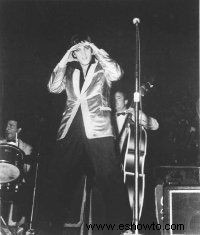 Elvis Presley siempre fue un artista consumado, sabiendo exactamente cómo formar el vínculo de conexión con su audiencia. Ver más fotos de Elvis.
Elvis Presley siempre fue un artista consumado, sabiendo exactamente cómo formar el vínculo de conexión con su audiencia. Ver más fotos de Elvis. Desde su nacimiento en una choza de escopetas en East Tupelo, Mississippi, hasta su muerte en una mansión en Memphis, Tennessee, y a través de todas las luchas y triunfos intermedios, la vida de Elvis Presley es una historia fascinante. Incluso ahora, treinta años después de su muerte, todavía hay mucho que aprender sobre este hombre que tocó tantas vidas.
Quizás debido a sus humildes comienzos, Elvis siempre fue aceptado por sus admiradores como "uno de ellos", un honor que ninguna cantidad de fama, riqueza o celebridad podría cambiar. Elvis dio un acceso sin precedentes y un sincero agradecimiento a sus fans a lo largo de su vida, incluso cuando esos mismos fans le hicieron imposible vivir una vida normal.
En las páginas de este artículo, puedes explorar la vida de Elvis Presley, comenzando con su nacimiento y primeros años, y los primeros días embriagadores de la fama como músico. Siga mientras sirve a su país en el ejército, luego regresa a los Estados Unidos para embarcarse en una nueva fase de su carrera, esta vez como un ídolo del cine. Vuelva a experimentar el espectáculo extravagante de los años de conciertos de la década de 1970 y explore el fenómeno duradero de los fanáticos que continúa rodeando a Elvis hasta el día de hoy.
Comience por el principio, con el nacimiento de Elvis Presley. Obtén más información sobre el niño que se convertiría en rey en la siguiente sección.
Para obtener más información fascinante sobre Elvis Presley, consulte:
El nacimiento de Elvis Presley
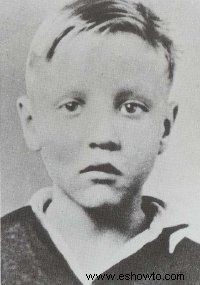
Cien millas al sureste de su futura mansión en Memphis, Tennessee, Elvis Aaron Presley llegó al mundo en East Tupelo, Mississippi, en las primeras horas de la mañana del 8 de enero de 1935. La cabaña de dos habitaciones donde nació Elvis estaba a años luz. lejos de Graceland en todos los aspectos.
El término "choza de escopeta" describe una casa tan pequeña que una bala disparada a través de la entrada principal puede volar directamente a través de la casa sin golpear nada. La casa de los Presley era, en una palabra, básica, al igual que su entorno inmediato.
Ubicado sobre una carretera que transportaba a los lugareños entre Tupelo y Birmingham, Alabama, y ubicado entre un grupo de casas pequeñas y toscas a lo largo de Old Saltillo Road, el lugar de nacimiento de Elvis fue construido por su padre, Vernon, con la ayuda del hermano de Vernon, Vester y el padre. , Jessie, cuya casa relativamente "espaciosa" de cuatro habitaciones estaba al lado.
Estos fueron los más humildes de los comienzos. A mediados de la década de 1930, en medio de la Gran Depresión, East Tupelo era un paraíso para los aparceros y trabajadores de fábricas pobres, así como para una variedad de contrabandistas y prostitutas, cuyos escasos recursos aún superaban en gran medida a los de los padres de Elvis. Vernon y su esposa, Gladys, no solo dependieron de la asistencia social para pagar los $15 que cobró el Dr. William Robert Hunt por dar a luz a Elvis y a su hermano gemelo, Jesse Garon, que nació muerto, sino que los vecinos y amigos también tuvieron que proporcionarles pañales.
La confusión sobre la ortografía correcta del segundo nombre de Elvis ha existido desde que el Dr. Hunt registró el nombre "Evis Aaron Presley" en su libro de contabilidad después del nacimiento. El certificado de nacimiento emitido por el estado de Mississippi muestra la ortografía "Aron", que también se encuentra en su aviso preliminar. La lápida de Elvis en Meditation Gardens en Graceland, sin embargo, está grabada con la ortografía más común "Aaron". La ortografía alternativa de los nombres era típica en la era de la Depresión, particularmente en las comunidades rurales donde las oportunidades educativas eran limitadas y la palabra escrita era menos significativa de lo que es ahora. Dado que los Presley eligieron el segundo nombre de Elvis en honor a su amigo y líder de canciones de la iglesia Aaron Kennedy, quien era gemelo, es probable que "Aaron" fuera la ortografía prevista.
Antes de que naciera Elvis, Gladys ganaba $2 por día en Tupelo Garment Company, mientras que Vernon tenía varios trabajos ocasionales, incluido uno en la granja lechera de Orville S. Bean. Con $180 que pidió prestados a Bean después de que Gladys quedara embarazada en la primavera de 1934, Vernon se dispuso a construir una casa familiar, y él y Gladys se mudaron allí en diciembre. Hoy en día, como parte de una atracción turística que incluye un pequeño museo, una capilla conmemorativa, una tienda de regalos y un parque arbolado en el renombrado Elvis Presley Drive, la casa que construyó Vernon Presley luce marcadamente diferente a cuando el futuro Rey del Rock 'n' Roll primero probó sus cuerdas vocales allí.
Si bien se reemplazaron el techo y el techo de este hito de Mississippi, la estructura básica sigue en pie, pero el exterior de madera ahora está pintado, el porche delantero tiene un columpio y el interior se ha adornado con muebles de época, papel tapiz, cortinas y electricidad. electrodomésticos tales como una máquina de coser que la familia Presley nunca podría haber tenido cuando vivían allí. Olvídese de la radio que ahora se encuentra en la sala de estar; la casa estaba originalmente iluminada con lámparas de aceite porque no estaba conectada al sistema eléctrico del pueblo. El jardín delantero bellamente ajardinado está muy lejos de la zona de tierra donde Gladys tenía una bandada de gallinas y una vaca.
La vida familiar de Elvis fue turbulenta durante sus primeros años, en gran parte debido a la pobreza y las circunstancias financieras de sus padres, Vernon y Gladys. Obtenga más información sobre los primeros años de vida de Elvis Presley en la siguiente sección.
Para obtener más información fascinante sobre Elvis Presley, consulte:
Los primeros años de vida de Elvis Presley
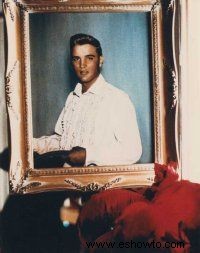
Aunque los bienes materiales no estaban fácilmente disponibles durante sus primeros años, a Elvis nunca le faltó lo más importante para cualquier niño:el amor de sus padres. Vernon era un padre dedicado y Gladys adoraba a su único hijo, formando un vínculo tan estrecho que se extendió a charlas infantiles de por vida entre los dos, como cuando Elvis la llamaba por el apodo cariñoso de Satnin'.
Temiendo perderlo de vista, Gladys acompañó a Elvis a todas partes, incluida la pequeña Iglesia de la Primera Asamblea de Dios, donde su tío Gains Mansell era el predicador y donde Elvis tuvo su primer contacto con la música. A los dos años, se deslizaba del regazo de su madre, subía a la plataforma frente a la congregación de 25 personas y se paraba frente al coro, tratando de cantar aunque era demasiado pequeño para saber la letra de los himnos.
Otro lugar que madre e hijo visitaban regularmente era el cementerio de Priceville, donde su hermano gemelo, Jesse Garon, fue enterrado en una tumba sin nombre. Aunque reforzada por la creencia de Gladys de que, como se informó en una edición de septiembre de 1956 de TV Guide, "Cuando un gemelo moría, el que sobrevivía obtenía toda la fuerza de ambos", Elvis creció a la sombra de su hermano.
Sin embargo, siempre estuvo consciente de la presencia fantasmal de Jesse cuidándolo, asegurándose de que intentara hacer lo correcto. Esto, junto con la especial confianza que compartía con su madre, fomentó una cualidad insular que Elvis mantendría hasta el final de sus días.
Muchos de los que lo conocieron, incluida su esposa, Priscilla, han atestiguado una soledad que nadie podía resolver, y aunque este lado de Elvis se exacerbó mucho después de la muerte de Gladys cuando tenía poco más de veinte años, surgió de una infancia en la que a menudo se retraía. a su propio pequeño mundo, un mundo definido por un fuerte apego a su madre y los floridos pensamientos de su fértil imaginación.
La vida estuvo bastante resuelta durante los primeros tres años de Elvis. Él y sus padres formaron un trío muy unido, que rara vez socializaba o se aventuraba lejos de la casa familiar, pero todo cambió en mayo de 1938 después de que Vernon fuera a prisión por su participación en la alteración y el cobro de un cheque que recibió de Orville Bean.
Vernon fue acusado de falsificación, junto con Travis Smith y Luther Gable, y sentenciado a tres años en la Penitenciaría Estatal de Mississippi. Cumplió solo ocho meses de su sentencia, pero durante ese tiempo Bean recuperó la casa de los Presley, lo que obligó a Gladys y Elvis a mudarse a un par de hogares temporales:al lado con los padres de Vernon, y luego en Maple Street en Tupelo, donde vivieron con Los primos de Gladys, Frank y Leona Richards.
Si este fue un período difícil para Vernon, no fue mucho más fácil para su esposa e hijo. Gladys luchó, ya veces fracasó, para llegar a fin de mes lavando la ropa y trabajando como costurera, mientras que Elvis sufrió al darse cuenta de la ansiedad de separación que sentía con respecto a su padre.
Elvis tenía mucho miedo de perder a su padre. Cuando la familia fue a nadar, Elvis no quería que Vernon se zambullera por temor a que le pasara algo malo. En otro caso, la casa de un vecino se incendió y Vernon entró corriendo para ayudar a salvar sus pertenencias. Según los informes, Gladys tuvo que evitar que su angustiado hijo fuera tras su padre. Elvis lloró y gritó ante la posibilidad de que Vernon pudiera lastimarse, y Gladys tuvo que tranquilizarlo diciéndole que confiara en que Vernon sabía lo que estaba haciendo.
Ese último comentario no habría tranquilizado al niño en 1938, cuando muchos de sus peores temores se hicieron realidad. Su único respiro llegó en forma de esos fines de semana cuando Gladys y Elvis hicieron el viaje en autobús de cinco horas para visitar a Vernon en la Penitenciaría Estatal de Mississippi en Parchman. El viaje de ida y vuelta de diez horas, que hicieron todo en un día, presumiblemente solidificó la unión madre-hijo más que nunca.
Cuando Vernon fue lanzado en febrero de 1939, un mes después del cuarto cumpleaños de Elvis, Gladys y Elvis todavía vivían con Frank y Leona Richards en Maple Street. Sin embargo, al poco tiempo regresaron a East Tupelo y, luego de una breve estadía con el hermano mayor de Vernon, Vester (quien estaba casado con la hermana de Gladys, Clettes), vivían en una sucesión de casas de alquiler bajo.
Desde muy temprana edad, el interés y la aptitud de Elvis por la música fueron evidentes. Aprende sobre las influencias musicales de Elvis Presley en la siguiente sección.
Para obtener más información fascinante sobre Elvis Presley, consulte:
Las influencias musicales de Elvis Presley
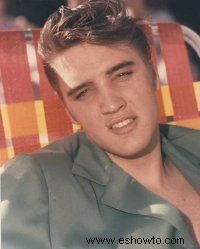
Una de las pocas constantes en la vida de Elvis durante sus primeros años fue la iglesia First Assembly of God, donde él y sus padres cantaban en el coro, así como la escuela primaria Lawhon en Lake Street, a la que comenzó a asistir en el otoño de 1941. .
Ya solitario, acostumbrado a jugar solo más que con sus pocos amigos, Elvis pronto aprendió a leer, y pasaba horas y horas con su pequeña colección de historietas. También se reencontró con la ausencia de su padre.
Beneficiándose de mayores oportunidades de trabajo creadas por la entrada de Estados Unidos en la Segunda Guerra Mundial, los Presley se mudaron a la costa del golfo de Mississippi, donde Vernon y su primo Sales encontraron empleo en el Astillero Moss Point cerca de Pascagoula en 1940.
La reubicación duró poco. Extrañando a su familia y amigos, Vernon y Gladys regresaron a East Tupelo aproximadamente un mes después. Vernon pasó la mayor parte de 1942 viviendo separado de su familia en Mississippi, Alabama, y finalmente en Memphis, Tennessee, donde trabajó en una planta de municiones mientras regresaba a East Tupelo para estar con Elvis y Gladys los fines de semana.
Vernon ahorró suficiente dinero al final de la guerra para hacer un pago inicial de $ 200 en una casa de cuatro habitaciones y $ 2,000 en Berry Street. Sorprendentemente, la persona que le vendió la propiedad no era otra que Orville Bean, cuyo cheque alterado había llevado previamente a Vernon a la cárcel.
Y poco después fue la hija de Bean, Oleta Grimes, quien animó a Elvis a hacer su primera actuación pública, compitiendo en un concurso de talentos de radio el Día del Niño en la feria anual Mississippi-Alabama Fair and Dairy Show en el centro de Tupelo. Grimes, quien también resultó ser el maestro de quinto grado de Elvis, quedó impresionado por su canto durante las oraciones de la mañana.
Cuenta la leyenda que, usando anteojos y parado en una silla para alcanzar el micrófono frente a varios cientos de personas, Elvis ganó el segundo lugar al cantar, sin acompañamiento, "Old Shep", el lacrimógeno Red Foley sobre el perro querido y fallecido de un niño. El premio de Elvis supuestamente consistía en pases gratis para todas las atracciones de la feria más cinco dólares.
Investigación realizada por Bill Burk para su libro Early Elvis: Los años de Tupelo ha disipado este mito. Las entrevistas con la familia y los amigos de Elvis, así como los comentarios hechos por el propio Elvis, confirman que sí cantó "Old Shep" sin acompañamiento y que usó anteojos por un corto tiempo en quinto grado. Sin embargo, no quedó segundo en la feria. Es posible que haya quedado quinto, pero probablemente no ganó ningún premio.
La falta de acompañamiento musical de Elvis pronto se resolvió cuando su madre le compró una guitarra de Tupelo Hardware Company para su undécimo (o posiblemente décimo, según algunas versiones de la historia) cumpleaños. Gladys lo vio como una alternativa barata y segura a la bicicleta que Elvis solicitó originalmente. Enseñado diferentes acordes por su tío Vester, Elvis comenzó a cantar y tocar en la iglesia y en el WELO Saturday Jamboree, un popular programa de talentos de radio transmitido desde el juzgado local.
El Jamboree de WELO trajo a Elvis su primer contacto directo con el mundo del espectáculo. Mississippi Slim, cuyo verdadero nombre era Carvel Lee Ausborn, fue la estrella del espectáculo, combinando la música country con la comedia, y no solo acompañó a Elvis en la guitarra, sino que también le enseñó nuevos acordes y canciones. El hermano menor de Slim, James Ausborn, estaba en la clase de Elvis en East Tupelo Consolidated y, a veces, los niños visitaban a Slim en el estudio de la estación de radio WELO, donde tenía su propio programa de mediodía. De esa manera, Elvis tendría una oportunidad adicional de obtener instrucción sobre qué cantar y cómo tocar.
Inspirado en la música country que escuchaba en la radio del Grand Ole Opry todos los sábados por la noche, además de los sonidos con sabor a gospel que resonaban en la iglesia todos los domingos por la mañana, Elvis estaba lleno de hambre por aprender y ganas de juntarse con músicos como Slim, quien aparentemente conocía a algunas de las grandes estrellas, como cantar. vaquero Tex Ritter. Sin embargo, nadie, incluido Elvis, podría haber adivinado que ya se había embarcado en el camino que lo llevaría a la fama y la fortuna.
En el verano de 1946, al no poder pagar los pagos de su casa en Berry Street, Elvis y sus padres se mudaron de East Tupelo a la ciudad vecina de Tupelo, y pronto se encontraron viviendo en su versión de Poverty Row. Mulberry Alley estaba ubicado frente a Shake Rag, el barrio negro de Tupelo, y la casa de los Presley era poco más que una choza.
A media milla de distancia estaba Milam Junior High School, donde Elvis ingresó a sexto grado en el otoño. Un estudiante promedio, era demasiado retraído para causar una gran impresión en sus maestros o compañeros de clase. Solo cuando comenzó a llevar su guitarra a la escuela en séptimo grado para tocar durante el almuerzo, esa situación cambió.
Mientras tanto, Elvis y su familia cambiaban de domicilio con tanta frecuencia como Vernon cambiaba de trabajo. Entre las ganancias de Vernon, aunque poco ambicioso, rara vez estaba desempleado, el pago que recibió Gladys por trabajar en Mid-South Laundry y el dinero de una serie de préstamos, pudieron mantenerse a flote, y en el segundo. la mitad de 1947 los Presley vivían en North Green Street, ubicado en un vecindario "de color".
En consecuencia, despreciado por varios de sus compañeros de clase blancos, Elvis también debe haber sido considerado como un intruso dentro de la comunidad negra local, sin embargo, se sintió atraído como un imán por la música que escuchaba en las calles, alrededor de las iglesias y saliendo. de los clubes y bares. Era terrenal, salvaje y, sobre todo, emocionante, reflejando la colorida ropa, la forma de hablar y, en ciertos casos, el modo de comportamiento de los participantes. Para un niño pobre con habilidades de comunicación limitadas pero sueños expansivos y una mente abierta, debe haber sido una experiencia emocionante.
Durante su adolescencia, las influencias musicales y estilísticas que Elvis encontró en su vecindario tuvieron un impacto real en la formación de su propio estilo personal. Obtenga más información sobre los años de adolescencia de Elvis Presley en la siguiente sección.
Para obtener más información fascinante sobre Elvis Presley, consulte:
La adolescencia de Elvis Presley
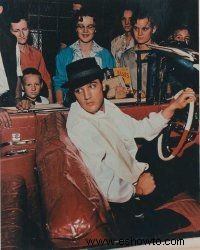
Durante los grados séptimo y octavo, Elvis se presentó en la escuela secundaria Milam Junior High todos los días con su guitarra, tocándola para cualquiera que quisiera escuchar en el área de recreo del sótano durante el almuerzo, y comenzó a adornar sus actuaciones con acordes de lo que comúnmente se conoce como "música de carreras".
Para muchos de sus compañeros de escuela, esto fue un desvío, algunos incluso hicieron su punto cortando las cuerdas de su guitarra, pero otros al menos prestaron atención a su vocalización de los estándares del país. Nadie sabía que estaban presenciando el nacimiento de una leyenda. Y nadie pareció molesto cuando se enteraron de que se mudaría a Memphis.
Perpetuamente sin dinero y ahora sin razones para permanecer en Tupelo, Vernon y Gladys decidieron que era hora de comenzar de nuevo al otro lado de la frontera estatal en Tennessee. Así que vendieron sus pocos muebles, cargaron su Plymouth con ropa y otras pertenencias y nunca miraron hacia atrás.
En Memphis, inicialmente vivieron en una casa de huéspedes en Washington Street y luego en otra en Poplar Avenue, comían y dormían en una habitación individual mientras compartían el baño con otras tres familias en una casa de dieciséis unidades.
Vernon, que trabajaba en una serie de trabajos en fábricas, solicitó vivienda pública para mejorar su situación, y su solicitud fue respondida en septiembre de 1949 cuando la Autoridad de Vivienda de Memphis trasladó a la familia a un apartamento en las cercanías de Lauderdale Courts, en la parte norte de la ciudad. ciudad. El alquiler mensual de $35 era un dólar más de lo que costaba vivir en Poplar Avenue, y el lugar en sí estaba deteriorado y necesitaba reparaciones, pero al menos los Presley ahora tenían suficiente espacio para mudarse, con una sala de estar, cocina, dos dormitorios y un baño privado.
Lauderdale Courts, con su animada variedad de familias jóvenes, estaba ubicado cerca de las atracciones del centro, como las tiendas y los cines a lo largo de Main Street, así como los clubes y bares a lo largo de Beale Street. Según la mayoría de los estándares, esta era una comunidad bulliciosa; para un niño de 14 años con los ojos muy abiertos, acostumbrado a las luces figurativamente más apagadas de Tupelo, probablemente fue poco menos que inspirador.
Aquí estaban todos los elementos para encender la imaginación de un adolescente, así como los medios para ayudarlo a realizar sus ambiciones, musicales o de otro tipo. En este punto, no está claro cuáles eran las ambiciones de Elvis, excepto que esperaba algún día ganar suficiente dinero para permitirse una vida más fácil para él y su familia. Comenzando en otra escuela, no compartió su afición musical con sus nuevos compañeros de clase en L. C. Humes High School, donde se especializó en artes industriales/taller de madera. Pero se sintió lo suficientemente libre como para tocar la guitarra y cantar con un trío de chicos con los que rápidamente se hizo amigo.
Farley Guy, Paul Dougher y Buzzy Forbess vivían en Lauderdale Courts, y juntos iban al cine con Elvis, nadaban, jugaban al fútbol, deambulaban por el centro e incluso ganaban dinero cortando el césped con una cortadora de césped comprada por Vernon. Farley, Paul y Buzzy sabían del interés de Elvis por la música, al igual que sus padres.
Vernon, Gladys y Elvis a menudo pasaban tiempo reunidos alrededor de la radio para escuchar actos de música country como Eddy Arnold, Sleepy Eyed John y Louvin Brothers; y grupos de gospel como los Blackwood Brothers y los favoritos personales de Elvis, los Statesmen. Dirigido por el carismático Jake Hess, la ropa extravagante y el canto muy estilizado de este cuarteto causaron una profunda impresión en el joven Elvis. Las influencias musicales y culturales lo bombardeaban desde todas las direcciones y él las absorbía como una esponja.
Cuando Elvis estaba en décimo grado en Humes High, se había conectado con otro grupo de adolescentes que vivían en Lauderdale Courts:Lee Denson y Johnny Black, y los hermanos Dorsey y Johnny Burnette. El cuarteto tenía un grupo musical informal que interpretaba los estándares del país al aire libre para los residentes en las cálidas tardes de verano, y Elvis se unió para contribuir con los coros.
Su creciente confianza musical también comenzó a atraer la atención femenina, incluida la de sus primeras novias, como Betty McMahan y Billie Wardlaw, quienes vivían en los tribunales. Otros en Humes High se encontraron con un Elvis completamente diferente, tanto en términos de apariencia como de comportamiento, durante su primer año de secundaria, 1951.
Hasta ese momento, la música de Elvis se compartía con moderación con familiares, amigos cercanos y vecinos, pero todo eso estaba a punto de cambiar. Para obtener más información sobre la carrera musical antigua de Elvis Presley, consulte la siguiente sección.
Para obtener más información fascinante sobre Elvis Presley, consulte:
La carrera musical antigua de Elvis Presley
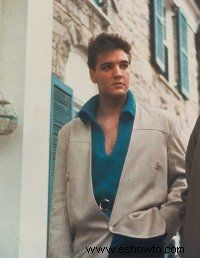
En una época en que ciertas grabaciones de Rhythm and Blues, en particular, "Rocket 88" de Jackie Brenston, se parecían mucho a lo que pronto se conocería como rock 'n' roll, Elvis comenzó a fusionar la actitud sensual y despreocupada de la música con la apariencia de un camionero rudo:cabello largo y engrasado y patillas que contrastaban con sus modales invariablemente educados. Su apariencia llamó mucho la atención, y algunos de los chicos más rudos de la escuela respondieron amenazándolo con golpearlo y cortarle el cabello.
Una leyenda que se ha transmitido durante muchos años es que Elvis incluso fue expulsado del equipo de fútbol de la escuela por negarse a cambiar su apariencia cortándose el pelo largo. La verdad del asunto era mucho menos dramática.
Aunque el entrenador Rube Boyce le pidió a Elvis que se cortara el pelo, Elvis abandonó el equipo de fútbol por su propia voluntad. En entrevistas con Bill Burk dadas para Early Elvis:The Humes Years, tanto el entrenador Boyce como el asistente del entrenador Malcolm Phillips recordaron que Elvis dejó el equipo porque consiguió un trabajo después de la escuela.
Poco después de dejar el equipo, Elvis comenzó a usar lo que luego se convertiría en su ropa llamativa característica, generalmente una llamativa combinación de rosa y negro, que compró con las ganancias de su trabajo de medio tiempo como ujier en Loew's. Teatro estatal en South Main Street.
A medida que la pasión de Elvis por la música se convirtió en algo que lo consumía todo, su trabajo escolar se tambaleó. Una variedad de calificaciones A, B y C durante su primer año en Humes había degenerado hasta el punto en que era un estudiante de C. Pasaba gran parte de su tiempo libre yendo al cine y pasando el rato en las tiendas de discos.
También asistió a sesiones nocturnas de canto gospel con sus padres en el Auditorio Ellis, donde observaba algunos de los movimientos escénicos animados de los artistas más extrovertidos. El gospel encapsuló la espiritualidad y el físico que estaban en el centro del estilo musical de Elvis Presley; sin embargo, cuando cantaba y tocaba la guitarra en las fiestas, era más probable que cantara un tema pop de Dean Martin, Bing Crosby o Perry Como.
A fines de 1952, los ingresos combinados de los Presley excedieron el máximo permitido por la Autoridad de Vivienda de Memphis, por lo que la familia se mudó de Lauderdale Courts a una casa de huéspedes en la cercana Saffarans Street, y luego a un apartamento en 462 Alabama Street, frente a los Tribunales. Aunque los Presley se vieron obligados a abandonar el proyecto de vivienda, optaron por permanecer en el mismo vecindario. Sin embargo, Elvis estaba a punto de moverse en una nueva dirección.
En abril de 1953, un par de meses antes de graduarse de la escuela secundaria, Elvis actuó en el Minstrel Show anual de Humes. Decimosexto en un proyecto de ley de 22 actos, incluido en el programa como "Elvis Prestly", sorprendió a alumnos, padres y maestros por igual con su interpretación de "Till I Waltz Again with You" de Teresa Brewer.
Fue un momento seminal. Como una escena de una de sus futuras películas, Elvis dejó de lado su propia personalidad tímida en favor de una personalidad popular y animada, y el joven de aspecto peculiar comenzó a atraer la atención de sus compañeros como polillas a una llama.
Después de graduarse de la escuela secundaria L. C. Humes, Elvis comenzó a trabajar para M. B. Parker Machinists, algo que difícilmente podría convertirse en una leyenda. Sin embargo, el destino conspiraba a su favor, las piezas encajaban y pronto todos los sueños de Elvis Presley se harían realidad. Estaba a punto de hacer su primera grabación, y de hacer historia. Consulte la siguiente sección para obtener más información sobre la primera grabación de Elvis.
Para obtener más información fascinante sobre Elvis Presley, consulte:
Primera sesión de grabación de Elvis Presley
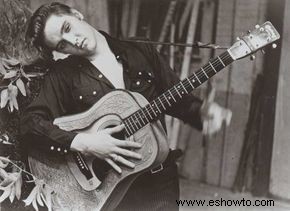
La historia del descubrimiento de Elvis Presley comienza con un tímido Elvis de 18 años que ingresa a un estudio de grabación en 1953 para grabar dos canciones en un disco de acetato a un costo de cuatro dólares. El Memphis Recording Service era propiedad y estaba operado por Sam Phillips, quien había estado grabando artistas de rhythm and blues desde 1950. Cuando Elvis llegó al estudio de grabación, Sam Cornelius Phillips era conocido como el productor de discos independiente más importante de Memphis. Abrió Sun Records en 1952 para grabar cantantes de rhythm and blues (R&B) y artistas de country-western.
Phillips disfrutó de una reputación nacional por descubrir a artistas de R&B tan talentosos como Rufus Thomas y Junior Parker. Phillips grabó a estos artistas para compañías discográficas independientes en otras partes de los Estados Unidos, incluidos Chess Records en Chicago y el sello Modern en Los Ángeles. Phillips financió las sesiones de grabación, pagó a los músicos, grabó a los artistas él mismo (a menudo actuando como ingeniero de estudio) y luego arrendó las grabaciones maestras a otras compañías discográficas. Su reputación se basó en sus grabaciones de artistas de blues, pero acababa de empezar a trabajar con cantantes de country cuando Elvis entró en su estudio de grabación por primera vez.
El folklore del rock 'n' roll relata una versión diferente del primer viaje de Elvis al Servicio de Grabación de Memphis. Según relatos más antiguos y más sentimentales, Elvis era un cantante talentoso pero sin experiencia que simplemente quería hacer un disco para el cumpleaños de su madre. Debido a que el cumpleaños de Gladys fue en abril, el momento en esta versión de la historia no es correcto, porque Elvis grabó ese primer disco de acetato a fines del verano de 1953. Es más probable que Elvis conociera la reputación de Sam Phillips como productor independiente y acudió al Servicio de Grabación de Memphis para captar su atención.
Desafortunadamente, el día que Elvis decidió pasarse, Phillips no estaba allí. Su incansable secretaria y asistente, Marion Keisker, dirigía sola el estudio de grabación. Ella notó la ropa extravagante de Elvis y su cabello largo y peinado hacia atrás y lo entabló una conversación. Marion le preguntó a Elvis qué tipo de música cantaba y a quién cantaba. Su respuesta profética, "No sueno como nadie", despertó su curiosidad, y mientras Elvis cantaba "My Happiness" de Ink Spots para su disco de acetato, Keisker también lo grabó para que Phillips pudiera escucharlo más tarde.
A principios de la década de 1950, el rhythm and blues había evolucionado a partir de una combinación de blues urbano y swing. Se la llamó "música de carreras" porque los músicos de R&B eran predominantemente afroamericanos. Phillips creía firmemente que el sonido del rhythm and blues podía conquistar una audiencia masiva. Sabía que los adolescentes blancos de Memphis escuchaban R&B y sospechaba que esto también era cierto en otras partes del país. Se sabía que Phillips proclamaba:"Si pudiera encontrar un hombre blanco que tuviera el sonido negro y la sensación negra, podría ganar mil millones de dólares". Según Marion Keisker, fue una declaración ampliamente conocida.
La segunda canción de Elvis para la otra cara del acetato fue otra canción de Ink Spots, "That's When Your Heartaches Begin". Su elección de material, dos canciones de Ink Spots, un grupo de R&B establecido, sugiere que Elvis pudo haber sabido de la declaración de Phillips y esperaba que el productor se diera cuenta. Phillips escuchó las dos canciones del cantante desconocido pero no hizo nada al respecto, aunque la leyenda dice que el talento natural de Elvis inmediatamente dejó atónito a Sam Phillips.
Años más tarde, después de que Elvis se convirtiera en una gran estrella, Phillips cambió un poco la historia. Afirmó que él era la persona detrás del escritorio en el Servicio de Grabación de Memphis en ese día histórico. Para respaldar su afirmación, Phillips señaló que Keisker no sabía cómo operar el equipo de grabación, por lo que era la única persona que podría haber grabado a Elvis. Pero Marion Keisker ha contado su relato del evento muchas veces en forma impresa y durante entrevistas televisivas y, por lo que se sabe, Elvis nunca disputó su versión.
No fue hasta que Elvis volvió al Servicio de Grabación de Memphis que Sam Phillips y Sun Records realmente se dieron cuenta. Obtenga más información sobre la relación inicial de Elvis con Sun Records en la siguiente sección.
Para obtener más información fascinante sobre Elvis Presley, consulte:
Elvis Presley y Sun Records
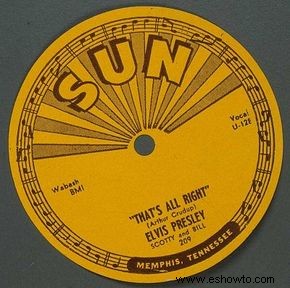
Aunque no salió nada de su primera sesión en el Servicio de Grabación de Memphis, Elvis estaba decidido a darle otra oportunidad. Regresó al servicio de grabación en enero de 1954 para grabar dos canciones más en acetato. Cantó "Casual Love Affair" y una canción country llamada "I'll Never Stand in Your Way". Esta vez Phillips hizo funcionar los controles. Aunque le ofreció poco ánimo al joven cantante, anotó el número de teléfono y la dirección de Elvis.
Phillips no llamó a Elvis hasta que Peer Music de Nashville envió a Sun Records una grabación de demostración de una balada llamada "Without You". Phillips decidió permitir que Elvis grabara la nueva balada. Desafortunadamente, Elvis no parecía dominar la canción, por lo que Phillips le pidió que cantara cualquier otra cosa que supiera. Encantado con la oportunidad, Elvis repasó con entusiasmo su extenso repertorio de canciones country y melodías de R&B. Phillips quedó lo suficientemente impresionado como para sugerir que el esperanzado cantante se juntara con Scotty Moore, un joven guitarrista que tocaba con un combo local de country-western, los Starlight Wranglers.
Elvis pasó a ver a Moore casi de inmediato. Moore recuerda:"Llevaba una camisa rosa, pantalones rosas con rayas blancas en las piernas y zapatos blancos, y pensé que mi esposa iba a salir por la puerta de atrás; la gente simplemente no usaba ese tipo de ropa llamativa". en el momento." (Nota del editor:de hecho, en la década de 1950, el rosa era el color de moda para todo, desde ropa de hombre hasta automóviles). Moore presentó a Elvis al bajista Bill Black, y los tres músicos pasaron el largo y caluroso verano de Memphis tratando de encontrar un sonido que hizo clic.
El trío trabajó en el estudio de grabación de Sun Records en lugar de actuar frente a una audiencia en vivo. Recently developed magnetic recording tape made it possible for them to do one take of a song, listen to it, then make adjustments for the next take. Presley, Moore, and Black finally hit upon their sound while they were fooling around during a break one night.
Elvis started singing Arthur "Big Boy" Crudup's blues song, "That's All Right," with a fast rhythm and in a more casual style than most blues songs, and Moore and Black jumped in. Phillips' voice boomed out from the control booth, "What are you doing?" None of them really knew. How could they? How could they know that they had stumbled onto a new sound for a new generation?
Phillips was excited about the trio's sound and recognized its potential. He asked them to refine their unique interpretation of "That's All Right," and then he recorded it. The flip side of their first record was their rendition of the bluegrass standard "Blue Moon of Kentucky," made famous by Bill Monroe and the Bluegrass Boys. Elvis' first record seemed to symbolize the roots of his musical sound; a blues song occupied one side while a country song made up the flip side.
Elvis' treatment of both songs didn't sound much like the recordings by the original artists. His approach was far more easygoing, which gave his renditions an air of spontaneity. Instead of the hard vocal delivery and tense rhythm of Crudup's version of "That's All Right," Elvis used a more-relaxed vocal style and rhythm. For "Blue Moon of Kentucky," the tempo was speeded up, and two elements were added that would make Elvis' sound famous.
He syncopated certain lyrics, using a sort of hiccuping sound, while Sam Phillips added a reverberation, resulting in the famous echo effect. Elvis' style became the basis of "rockabilly," the fusion of country music (commonly called hillbilly music) with a rhythm-and-blues sound that has been relaxed and speeded up, or "rocked." The term rockabilly was not widely known until after Elvis became a household name.
At the time he cut his first record for Sun, there was no word that could adequately describe his style of music. When the press attempted to explain his sound, they usually made a mess of it, often confusing their readers with inappropriate or comical comparisons to other types of music. Elvis was referred to at various times as a "hillbilly singer," "a young rural rhythm talent," a "white man...singing Negro rhythms with a rural flavor," and "a young man [with a] boppish approach to hillbilly music."
Not long after Elvis' success, other rockabilly and country-western singers showed up on the doorstep of Sun Studio, hoping that Phillips could work the same magic with them as he had with Elvis. Phillips eventually recorded Johnny Cash, Jerry Lee Lewis, Carl Perkins, Roy Orbison, Charlie Feathers, Billy Lee Riley, Dickie Lee, and other artists.
With their flashy clothes, raw sound, and fervent delivery, these singers forged a new sound and style that was intensely Southern, or "Dixie-fried." As Bill Williams, Sun Records publicist, recalled, "I think every one of them must have come in on the midnight train from nowhere. I mean, they came from outer space." Yet, the influence of Sam Phillips and Sun's recording artists on the development of rock 'n' roll can never be overestimated.
As his first recordings began to spread, Elvis gained recognition for his unique sound. Follow the early successes of Elvis Presley on the next page.
For more fascinating information about Elvis Presley, see:
Early Success for Elvis Presley
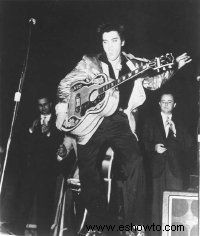
Sam Phillips took a copy of Elvis Presley singing "That's All Right" to popular disc jockey Dewey Phillips (no relation) for the latter's Red Hot and Blue radio program. At first Memphis' hottest deejay hesitated to play the Sun recording because his show was usually reserved for the music of black artists, but on July 7, 1954, he played the record on the air.
The station received dozens of requests for both sides of the disc, and Phillips played the two songs over and over. After receiving 14 telegrams and almost 50 phone calls in a matter of hours, he decided to interview the unknown singer on his program that very night.
Elvis was supposedly too nervous to stay at home and listen to himself on the radio, so he had gone to the movies. His parents, Vernon and Gladys, dashed to the theater to pick him up, and then rushed him to station WHBQ.
Dewey Phillips asked Elvis a variety of questions about his life and his interests, including what high school he had attended. This was a careful tactic on Phillips' part, for as soon as Elvis said "Humes" the audience knew he was a white man because the school was all white. At that time in 1954, Memphis schools were not yet integrated.
"That's All Right" became a fast-selling record in the Memphis area. Elvis' first single steadily climbed up the country-western charts by the end of July 1954.
Elvis' second record was released on September 25, 1954. It included the R&B tune "Good Rockin' Tonight," first made popular in 1948 by Wynonie Harris, and a country pop song called "I Don't Care If the Sun Don't Shine." This record moved up the charts even more quickly than his first single. It sold 4,000 copies in the Memphis area in two-and-a-half weeks.
By this time, Elvis was singing with Scotty and Bill at such Memphis night spots as the Eagle's Nest. At first, the talented newcomer made guest-star appearances with the Starlight Wranglers, but soon Elvis, Scotty, and Bill were performing on their own. They were called Elvis Presley and the Blue Moon Boys but often billed as the Hillbilly Cat and the Blue Moon Boys.
By this time, the three men had decided they needed to hire a professional manager. Bob Neal, a disc jockey at country station WMPS in Memphis, accepted the job and began pushing their Sun recordings, booking tours in the country-western clubs across the South and the Southwest, and handling all their business arrangements.
Bob Neal encountered a double problem in getting radio stations to play Elvis' records. The country-western stations thought Elvis sounded too much like a rhythm-and-blues singer, and blues stations found him too country. Also, audiences on the smaller country circuits considered the trio's frenzied performances to be too wild. Aside from Elvis' personal performing style, bass player Bill Black liked to clown around by dancing with his huge bass fiddle or rolling across the floor with it.
By 1955, these problems began to take care of themselves as Elvis' sound became more widely known, thanks to his weekly performances on the Louisiana Hayride radio show. Also, his newfound fame brought the band better bookings in larger towns where their act was more acceptable. They added a drummer, D.J. Fontana, and began to appear with well-established country acts, such as the Wilburn Brothers, Faron Young, Ferlin Huskey, Roy Acuff, Kitty Wells, and the Carter Family.
During 1955, Sun released three more Elvis singles:"Milkcow Blues Boogie"/ "You're a Heartbreaker" in January; "I'm Left, You're Right, She's Gone"/ "Baby Let's Play House" in April; and "Mystery Train"/ "I Forgot to Remember to Forget" in August. Like his early records, these singles featured a rhythm-and-blues song on one side and a country-western tune on the other. Elvis was still considered to be a regionally based country-western performer, but his popularity was beginning to soar.
Elvis' fourth single for Sun Records, "Baby Let's Play House," became the first Elvis Presley effort to chart nationally. Backed by "I'm Left, You're Right, She's Gone" on the flip side, it stayed on Billboard's country chart for ten weeks, reaching No. 10.
Rhythm-and-blues singer Arthur Gunter had written and recorded "Baby Let's Play House" in 1954, basing it on country singer Eddy Arnold's 1951 hit, "I Want to Play House with You." As an R&B reworking of a country-western song, "Baby Let's Play House" was perfect for Elvis' rockabilly repertoire. Gunter himself had been influenced by rockabilly artists, and he made a good model for Elvis, who had purchased a copy of Gunter's version the previous December at the House of Records in Memphis.
Elvis made the song his own with the inclusion of the syncopated phrasing "babe-babe-baby" in the verse. He also tinkered with the lyrics, changing "You may have religion" to "You may drive a pink Cadillac," a humorous foretelling of the car with which he would come to be identified. Sam Phillips added drums to the recording session for the song, marking the first time drums were used on a Presley single.
As "Baby Let's Play House" received national exposure, trade publications called it a country song, so few people connected it with the relatively unknown rhythm-and-blues artist who had inspired Elvis.
Bob Neal's management may have helped Elvis to break into the national scene, but under his next manager, he virtually exploded into fame. Learn more about Colonel Tom Parker, who became Elvis' lifelong friend and mentor, in the next section.
For more fascinating information about Elvis Presley, see:
Colonel Tom Parker, Elvis Presley's Manager
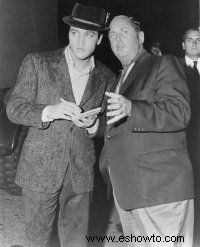
Nearly as legendary as his famous client was Colonel Tom Parker, Elvis Presley's manager. Colonel Parker was mysterious and colorful, and, under his guidance, his one and only client -- Elvis -- reached unimaginable heights.
Elvis added "Baby Let's Play House" and "I'm Left, You're Right, She's Gone" to his act in the spring of 1955. Less than a year later, he sang "Baby Let's Play House" on television for his second appearance on The Dorsey Brothers' Stage Show (February 4, 1956), just as his sensual performing style was beginning to create a national controversy.
If his hip-swinging performance on Stage Show raised eyebrows, then the lyrics to "Baby Let's Play House" added to the provocative connotation. Basically a proposition, the song is a plea from the singer to his girlfriend to return to him because he wants to "play house" with her, a slang term for an unmarried couple living or sleeping together. Despite the singer's plea, he takes a confrontational stance, telling his girl, "I'd rather see you dead than with another man."
In the spring of 1955, Bob Neal booked the Hillbilly Cat and the Blue Moon Boys on a tour with country singer Hank Snow. The tour was organized by Hank Snow Jamboree Attractions, which was owned by Snow but operated by a former carnival barker named Colonel Tom Parker.
Many colorful stories exist about Parker; some are no doubt true, while others have been exaggerated through the years. It's been said that he once covered a hot plate with straw and set baby chickens on top of it to make them "dance" to the tune "Turkey in the Straw." Another carny story tells of Parker painting sparrows yellow and selling them as parakeets.
Parker's country-western experiences included guiding country singer Eddy Arnold's career from relative unknown to star. Parker's title of "Colonel" does not refer to military rank but is an honorary title, which was bestowed upon him by the state of Louisiana in 1953. Later he was made an honorary Colonel of Tennessee as well. Much has been written about Colonel Tom Parker, not the least of which is that he was a very shrewd man.
A large portion of Elvis' audience by mid-1955 was made up of teenage girls. They were extremely enthusiastic during his stage performances, and Elvis learned to play to the girls, teasing them with his body movements and making them scream each time he swiveled his hips. During a summer performance in Jacksonville, Florida, Elvis jokingly invited all the girls in the audience to meet him backstage. But the joke was on Elvis:A swarm of screaming girls chased him all the way to his car and literally ripped most of his clothes off his body.
The incident terrified his mother, surprised the press, and delighted the Colonel, who had begun to monitor Elvis' career quite closely. Parker's position at Jamboree Attractions allowed him to quietly observe the young singer's steady rise in popularity.
As with other important events in Elvis' career, there are many versions of the story about how Colonel Tom Parker became Elvis' sole manager. Parker was supposed to have had a close working relationship with Hank Snow, but when he finally signed Elvis to a contract, Parker did not include Snow in the deal. Parker and Snow broke up their partnership over this matter, but Snow did not sue.
When the Colonel and Elvis signed their first contract in August 1955, Bob Neal still had a contract as Elvis' manager. Parker initially signed on as "special adviser," and his duties were to "assist in any way possible the buildup of Elvis Presley as an artist." Parker was also given the right to negotiate renewals on all existing contracts. At this point, Neal was kept on merely as a courtesy. When Neal's contract expired on March 15, 1956, he was completely out of the picture, and Parker became Elvis' full-time manager for a 25 percent cut.
When Parker began to take part officially in Elvis' career, Elvis was just a country-western singer. Though his style wasn't traditional and many of his most loyal fans were teenagers, Elvis still toured the country-western circuits and performed with other country stars. His records were played almost exclusively on country stations. If Elvis was going to live up to the potential the Colonel saw in him, he was going to have to be exposed to audiences outside the South on a wide scale.
As logical as this seems, the Colonel's plan was actually a bold move. After all, Elvis had never stepped foot outside the South, and northern audiences were unaccustomed to Southern musical traditions and sounds.
The first step in the Colonel's master plan was to find a recording company that could give Elvis national and international exposure. Learn about the development of Elvis' relationship with RCA Records in the next section.
For more fascinating information about Elvis Presley, see:
Elvis Presley and RCA Records
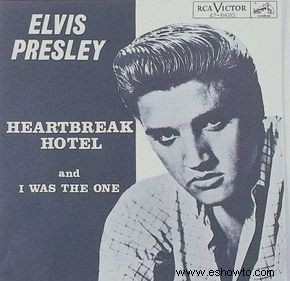
The Colonel's pursuit of the big time for Elvis -- his sole client -- began with a search for a recording contract with a nationally based company. Columbia and Atlantic expressed interest in the unusual new singer, but the Colonel had several contacts at RCA Victor, making a deal with this company preferable.
In November 1955, Sam Phillips sold Elvis' contract to RCA Victor for $35,000, plus $5,000 in back royalties he owed Elvis. It was the largest amount paid for a single performer up to that time. Steve Sholes, RCA's premier A&R (artist and repertoire) man, had helped sign Elvis to the label. Sholes oversaw the company's specialty singles, which included country-western, gospel, and R&B, so he served as the producer of Elvis' first recordings for RCA.
Moving to RCA was a major step in Elvis' career and a major investment for the company; at the very least, it meant going national and international in promotion and distribution. Sholes was aware that the executives at RCA were closely watching their unusual new artist, who didn't fit into any of the company's existing categories of music.
RCA re-released Elvis' Sun singles in December 1955; the reissue of "Mystery Train" did not sell well. Then the company arranged for Elvis to begin recording new material in Nashville the next month. Chet Atkins, RCA's head man in Nashville, organized the sessions, which started on January 10, 1956.
Scotty Moore and Bill Black, who had worked with Elvis on the road and at Sun from the beginning, accompanied Elvis as usual. DJ. Fontana, who played with Elvis on tour, checked in as Elvis' drummer, although he had never recorded with the trio before. Atkins played rhythm guitar, Floyd Cramer was added at the piano, and gospel singers Ben and Brock Speer of the Speer Family and Gordon Stoker of the Jordanaires provided backing vocals.
Moore and Black, who were used to the down-home atmosphere of Sun, found the detached, professional air at the RCA sessions intimidating, while Sholes was unsure of how to duplicate Elvis' Sun sound. Stoker was unhappy because the rest of the Jordanaires had not been asked to join the session. In fact, everyone was nervous or unsettled except Elvis, who attacked his first number, Ray Charles' "I Got a Woman," with everything he had. In effect, Elvis performed the song while he recorded it, which so impressed the typically cool Atkins that he called his wife to come down to the studio because "it was just so damn exciting."
"Heartbreak Hotel" was the second song Elvis recorded that day in January, and it became the first record he released on his new label, RCA.
Elvis had come across the song -- written by Gainesville songwriters Mae Boren Axton and Tommy Durden -- at a Nashville disc jockey convention the previous November. Durden had gotten the impetus for "Heartbreak Hotel" after reading a newspaper article about the suicide of a young man who had left behind a bitter note that read simply:"I walk a lonely street."
Axton had asked Gainesville singer Glen Reeves to record the demo and emulate Elvis' style, and Elvis copied the vocal intonations of Reeves for his recording. This story shows that Elvis' style was familiar enough to be recognized as his at the time. It also illustrates Elvis' pattern when recording a demo. He copied the interpretation of the demo singer whenever he recorded his version of a song.
"Heartbreak Hotel" borrowed the echo sound that was associated with Elvis' Sun releases, perhaps even exaggerating it. The effect is eerie, downright ghostly, especially during the opening lines to each verse when Elvis sings without accompaniment. His voice is penetrating, and the sound is despondent, perfectly capturing the alienation of disaffected youth.
Steve Sholes was disconcerted by Elvis' off-handed, instinctual approach to recording, in which he sang a take, played it back, discarded it, and then sang another, repeating the process until he felt he had captured the tune. Elvis did not read music, nor did he have any professional experience at arranging it. He just instinctively knew what to do and when to do it. RCA executives in New York were also troubled with the Nashville session. The recordings did not sound as much like Elvis' Sun records as they had wanted, and the two ballads were nothing like his previous releases.
A second recording session was arranged in New York, in which Elvis covered Carl Perkins' "Blue Suede Shoes" and Little Richard's "Tutti Frutti." This time only piano player Shorty Long was used in addition to Scotty, Bill, and D.J., and the focus was on explosive rock 'n' roll numbers. Seven tracks from the Nashville and New York sessions were chosen for Elvis' first long-playing album, Elvis Presley. These were combined with five songs previously recorded at Sun but never released. Interestingly, "Heartbreak Hotel" was not included on the first album.
Released on March 13, 1956, Elvis Presley sold over 360,000 copies by the end of April. At $3.98 per album, this made it RCA's first million-dollar album by a single artist. Elvis Presley also became the first album in music history to sell over a million copies. It reached No. 1 on Billboard's Top LPs chart, and launched an unprecedented five extended-play (EP) albums.
After his first successful full-length album, Elvis began to change his sound as he continued his growth as an artist. Learn more about the evolution of Elvis' sound in the next section.
For more fascinating information about Elvis Presley, see:
The Evolution of Elvis Presley's Sound
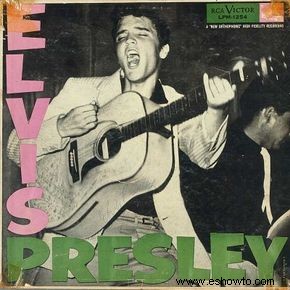
Some critics have claimed that the quality of Elvis' music began to deteriorate at RCA. They blame the decline on commercial calculation, the tightly structured schedule for recording at RCA (compared to the makeshift, down-home atmosphere at Sun), or Elvis' own desire to follow in the footsteps of Dean Martin. Elvis' music did undergo some changes once he moved to RCA, but the word "decline" is too harsh to use to describe the modification of his sound. Elvis' music did not decline at RCA, but it did move away from rockabilly to more mainstream rock 'n' roll. By the 1960s, it would mellow into a bona fide pop sound.
Part of the modification of his music was the result of deals Elvis and the Colonel made with music publisher Hill and Range, which was affiliated with RCA. After the deal was finalized, Hill and Range set up two new music publishing companies:Elvis Presley Music and Gladys Music. These companies were responsible for obtaining the rights to all the songs Elvis recorded.
This setup was financially advantageous for Elvis because he received not only his performer's royalty every time he recorded a song but also a publishing royalty. Hill and Range received half the income generated by Elvis Presley Music and Gladys Music. The songwriters who published their songs through the two smaller companies gave up a large percentage of their royalties to music publishers for the opportunity to write songs for Elvis.
They were also required to give Elvis a cowriting credit, even though he never wrote a song or any part of a song in his entire career. But the songwriters didn't complain, because even with reduced royalties, they made a lot of money. It soon became apparent that every song Elvis recorded sold millions of copies.
Obviously, it was best for all parties financially if Elvis recorded only those songs published by his own companies, although contractually he was not prevented from recording other songs. Ultimately, the Hill and Range deal limited Elvis because the material it obtained for Elvis Presley Music and Gladys Music sometimes came from songwriting hacks who had been employed by Hill and Range for years. Any writer with an exclusive agreement for another publisher was restricted from having his work recorded by Elvis. Consequently, Elvis was sometimes saddled with lackluster material from mediocre writers.
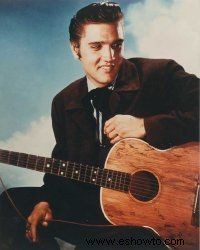
Throughout the rest of 1956, as Elvis recorded more material at RCA, he moved further away from the pure rockabilly of Sun Records and closer to a fully integrated rock 'n' roll style. By July 1956, when he stepped back into the RCA studios, Elvis seemed to be seeking a bigger, more explosive sound. It was in this session that he recorded two of his signature singles -- "Hound Dog" and "Don't Be Cruel."
Jerry Leiber and Mike Stoller wrote "Hound Dog" in 1952 for blues singer Willie Mae "Big Mama" Thornton at the request of Johnny Otis, a hustling bandleader, producer, composer, and R&B deejay. Otis invited the team to watch Thornton rehearse in his garage-turned-studio.
After watching the mighty singer belt out a few numbers, Leiber and Stoller composed "Hound Dog" -- a song about a gigolo -- in about ten minutes. Thornton growled the saucy lyrics to a hard-driving blues beat, and "Hound Dog" sold over a half million copies, climbed to No. 1 on the R&B charts, and became a top-selling record in the R&B market during 1953.
Several performers covered "Hound Dog," including country artists Tommy Duncan, Betsy Gay, Jack Turner, and Billy Starr, and lounge act Freddie Bell and the Bellboys. Bell enlivened the tempo and tampered with the lyrics in a humorous way, adding the line, "You ain't never caught a rabbit, and you ain't no friend of mine." Elvis caught the Bellboys' act in April 1956 when he was booked into the New Frontier Hotel in Las Vegas. Although Elvis flopped in Vegas, he brought back a little souvenir -- Bell's comedic version of "Hound Dog."
A male singer belting out the opening line to "Hound Dog" seems odd because the song was clearly written for a female voice, and Elvis' decision to add "Hound Dog" to his repertoire has been interpreted variously by rock music historians. Some insist that Elvis must have been familiar with the Thornton version because he was an R&B enthusiast, and they speculate that he recorded Bell's version because he recognized its humor.
Detractors suggest that he appropriated the blues tune without realizing its roots. It seems likely, however, that Elvis did know of Thornton's record. Although Elvis' recorded version was a rock 'n' roll interpretation patterned after Bell's, his rendition on the Berle show owes something to the growling, bump-and-grind vernacular of Thornton's bluesy "Hound Dog."
Pressured by producer Steve Sholes to record the tune, Elvis finally captured "Hound Dog" after about 30 takes in RCA's New York studios. Backed by "Don't Be Cruel," the record became the biggest two-sided hit in history. It climbed to No. 1 and held that position for 11 weeks, longer than any other single release of the rock 'n' roll era. It also reached No. 1 on the country-western and rhythm-and-blues charts.
"Don't Be Cruel" was the flip side of "Hound Dog." A relatively new tune, "Don't Be Cruel" had not been recorded by any singer prior to Elvis. As the song was not associated with any singer's specific style, Elvis could make it entirely his own. The recording's easygoing but fast-paced rhythm, light tone, and harmonious backup vocals by the Jordanaires indicate how far Elvis had drifted from the sounds of pure R&B and country music.
"Don't Be Cruel" was written by rhythm-and-blues singer-songwriter Otis Blackwell. He had sold the song to a music publisher, Shalimar Music, for $25 on Christmas Eve 1955. Elvis' parent publisher, Hill and Range, had acquired the song, and the demo was one from a stack the hot new singer listened to during an RCA recording session in July 1956.
When Elvis wanted to record the song, Blackwell was told that he would have to cut a deal and share the writer's credit with him, though Elvis did not contribute anything to writing the song. Blackwell was uneasy about the deal, but he realized he stood to make a great deal of money from royalties -- even at half-interest -- if Elvis recorded the song. This would not be the last time Elvis received a writing credit on a song he did not originally compose.
During the recording session, Elvis rehearsed "Don't Be Cruel" a couple of times with his regular backup musicians, a piano player hired by RCA, and the Jordanaires. Then the group worked on the song, finessing it as they went through almost 30 takes. All the musicians contributed something in their own way. DJ. Fontana used Elvis' leather-covered guitar as a makeshift drum to capture a snare effect by laying it across his lap and hitting the back with a mallet.
Their efforts resulted in one of Elvis' most beloved songs and one of his personal favorites. Total sales for any Presley single are often difficult to calculate, but by March 1992, the "Hound Dog"/"Don't Be Cruel" single had been awarded triple platinum status by the Recording Industry Association of America (RIAA).
But it was more than just a new promotional strategy and some minor developments in his music that transformed Elvis Presley into a rock 'n' roll singer. A vital part of this change occurred because of the image of Elvis the media constructed at that time, particularly after his controversial appearances on television.
Perhaps the most notorious appearances Elvis made on television were his three times as a guest on The Ed Sullivan Show. See the next section to learn more about these explosive appearances.
For more fascinating information about Elvis Presley, see:
Elvis Presley on The Ed Sullivan Show
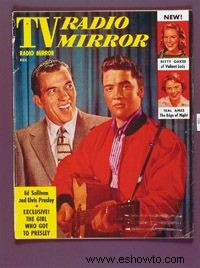
Two weeks after Elvis' first RCA recording session, he made his first television appearance on Tommy and Jimmy Dorsey's weekly Stage Show. During the next eight weeks, he appeared on this variety series five more times, and each time the show received better ratings. The first show, however, was only moderately successful and was beaten in the ratings by The Perry Como Show.
Stage Show was typical of television variety programs in the mid-1950s. Understanding the nature of these variety shows helps us to understand why Elvis created such a stir. With an hour-long format, Stage Show featured performances by a diverse group of entertainers, ranging from popular singers to animal acts to ballet dancers. Each week a guest host introduced some of the acts for that particular program.
On Elvis' first appearance, he was introduced by Cleveland disc jockey Bill Randle, who was supposedly the first radio personality to play an Elvis record outside the South. Randle, however, would be the only person featured on any of Elvis' Stage Show appearances who had any connection with the young singer.
The other hosts and guest stars who appeared with Elvis included jazz singers Sarah Vaughan and Ella Fitzgerald, stand-up comedians Joe E. Lewis and Henny Youngman, a chimpanzee act, an acrobatic team, and an 11-year-old organist. Compared to these types of entertainers -- who were considered suitable for family audiences -- Elvis' new, high-powered music and dynamic performing style seemed alien. The young singer's Beale Street clothing and ducktail haircut made him stand out even more.
On his first appearance, Elvis was visibly nervous. He sang "Shake, Rattle, and Roll" and "Heartbreak Hotel," doing a little shaking and shimmying, and then quickly moved offstage. By his final appearance, more of an interaction between Elvis and his audience took place as the young man worked hard to drive the girls in the crowd into a screaming frenzy.
When he strummed the opening chord of "Heartbreak Hotel" on his guitar, a burst of screams and applause broke out. Elvis hesitated for a moment, tantalizing the audience with anticipation. As he broke into song, he moved across the stage, shaking his shoulders and swinging his legs.
Certain moves were obviously designed to elicit emotional responses from the girls, and Elvis' smiles proved he was delighted at this explosive effect on his female fans. The interaction between Elvis and his fans was much like a game:He teased the women with his provocative moves; they screamed for more; he promised to go further; sometimes he did.
In late spring of 1956, Elvis appeared on The Milton Berle Show for the first time. The show was broadcast from the USS Hancock, which was docked at the San Diego Naval Station. Despite the novel location, this television appearance is barely mentioned in biographies or other accounts of Elvis' career, because his second appearance on the Berle program has completely overshadowed it.
This appearance on June 5 fanned the flames of the nationwide controversy over his hip-swiveling performing style. Elvis sang "Hound Dog" for the first time on television that spring night. When he began the song, no one knew what to expect, because the tune was new. But the audience responded immediately with enthusiasm. Elvis then went a bit further in his performance:He slowed down the final chorus of the song to a blues tempo, and he thrust his pelvis to the beat of the music in a particularly suggestive manner. The studio audience went wild with excitement.
The next day, the press nicknamed him "Elvis the Pelvis." Many described his act by comparing it to a striptease. Jack Gould of The New York Times declared, "Mr. Presley has no discernible singing ability," while John Crosby of the New York Herald Tribune called Elvis "unspeakably untalented and vulgar." The criticism prompted parents, religious groups from the North and South, and the Parent-Teacher Association to condemn Elvis and rock 'n' roll music by associating both with juvenile delinquency.
Elvis could not understand what all the fuss was about:"It's only music. In a lot of papers, they say that rock 'n' roll is a big influence on juvenile delinquency. I don't think that it is. I don't see how music has anything to do with it at all....I've been blamed for just about everything wrong in this country."
After The Milton Berle Show, Colonel Parker booked Elvis on The Steve Allen Show, a new variety program that aired at the same time as Ed Sullivan's immensely popular show. Allen hated rock 'n' roll, but he was aware of the high ratings Berle's show received when Elvis appeared. He was also aware of the controversy.
To tone down Elvis' sexy performance, Allen insisted that he wear a tuxedo during his segment, and he introduced him as "the new Elvis Presley." Elvis sang one of his latest singles, a slow but hard-driving ballad called "I Want You, I Need You, I Love You."
Immediately after that number, the curtain opened to reveal a cuddly basset hound sitting on top of a tall wooden stool. Elvis sang "Hound Dog" to the docile creature, which upstaged the singer with his sad-eyed expressions. Allen used humor to cool down Elvis' sensual performing style, prohibiting him from moving around much on stage and even preventing him from wearing his trademark Beale Street clothes. The fans were furious, and they picketed NBC-TV studios the next morning with placards that read, "We want the gyratin' Elvis."
Later in the program, Elvis joined Allen, Imogene Coca, and fellow Southerner Andy Griffith in a comedy sketch that satirized country-western programs, not unlike Louisiana Hayride. Many of the jokes were condescending toward Southern culture. Allen's presentation of Elvis singing to a dog plus the appearance of the "hayseed" sketch actually ridiculed Elvis. Steve Allen was the real winner that night, because his show beat Sullivan in the ratings.
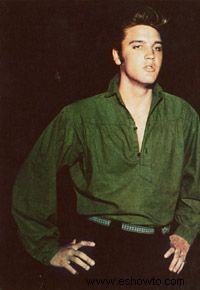
Elvis had established himself as an entertainer who could attract a large television audience and boost ratings, so it's not surprising that after many rejections, the Colonel finally arranged for Elvis to appear on The Ed Sullivan Show, a highly rated, prime-time variety program.
Sullivan, who was a powerful figure in the industry, had stated publicly that he would not allow Elvis to appear on his show because it was a family program. But ratings speak louder than scruples, and Sullivan backed down from this stance after The Steve Allen Show was so successful. Elvis was paid an unprecedented fee of $50,000 for three appearances on The Ed Sullivan Show. This was a lot more than the $5,000 per show Colonel Parker had asked for only a few weeks earlier when Sullivan turned him down.
Elvis' performance on The Ed Sullivan Show is cemented in the annals of rock music history because of the censors' decision to shoot the volatile young singer only from the waist up. However, contrary to popular belief, this decision was not made until his third appearance.
Actor Charles Laughton served as substitute host the night of Elvis' first appearance because Sullivan was recuperating from an auto accident. In kinescopes and video footage of that performance, Elvis can be seen in full figure, crooning "Love Me Tender" and "Don't Be Cruel," then later belting out "Hound Dog" and "Ready Teddy."
Elvis' third and final appearance on Sullivan's show on January 6, 1957, contains the legendary moments when the CBS censors would not allow his entire body to be shown. Seen only from the waist up, Elvis still put on an exciting show, singing seven songs in three segments. In one segment, Elvis and the Jordanaires sang "Peace in the Valley," which Elvis dedicated to the earthquake victims of Eastern Europe.
But it was his rendition of such Presley hits as "Heartbreak Hotel" and "Hound Dog" that stirred up the studio audience. Their screams and applause clued the television viewers in to what Elvis was doing out of camera range, almost subverting the censors' intent. Once again, the interaction between Elvis and the studio audience added to the power of his performance. After Elvis' final number, Sullivan declared him to be "a real decent, fine boy" -- a rather hypocritical statement considering what he and the censors had just done to Elvis' act.
For years people have wondered why Elvis was censored during his third appearance on Sullivan's show. The simplest and most probable explanation is that Sullivan received negative criticism about Elvis' earlier appearances. Other, more outrageous explanations include the theory that the Colonel forced Sullivan to apologize publicly for remarks he'd made about Elvis to the press the previous summer, and the waist-up-only order was Sullivan's way of getting back at Parker.
The wildest explanation was offered by a former director of The Ed Sullivan Show, who said that during his second appearance, Elvis put a cardboard tube down the front of his trousers and manipulated it to make the studio audience scream. To avoid a repeated occurrence of that behavior, Sullivan supposedly insisted on the above-the-waist coverage for Elvis' final appearance. None of these explanations offers any real insight into Sullivan's motivations but all add to the folklore surrounding this event, thereby enhancing Elvis' image as a notorious rock 'n' roller.
Elvis' image also owed a lot to his portrayal in the media. See the next section to learn more about Elvis and the press.
For more fascinating information about Elvis Presley, see:
Elvis Presley and the Press
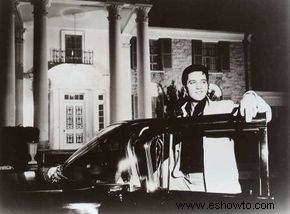
Looking back, it all seems so harmless, but Elvis appeared on the scene at a time when rock 'n' roll was coming under fire in the popular press. The controversy centered on whether this new style of music associated with teenagers led to teenage sex and crime. During the spring and summer of 1956, many national magazines published articles that claimed there was a link between rock 'n' roll and juvenile delinquency.
At the same time, Elvis was often featured in these same magazines in articles that sensationalized the effect of his sensual performing style on teenage girls. Headlines blared "Presley's Impact Piles Up Fans, Fads -- and Fear," while trumped-up stories declared his "sex-hot flame" to be inextinguishable. It did not take a great leap of imagination for journalists, reviewers, and critics to relate Elvis' personal appearance and sensual performing style to the decadence of rock 'n' roll and the horrors of juvenile delinquency.
When the popular press was not openly criticizing Elvis, they were ridiculing him. Despite the fact that his music was identified as rock 'n' roll, journalists and reporters often referred to him disparagingly as a "hillbilly singer." He was maligned for his Southern accent, his flashy clothes, his long sideburns, and his ducktail haircut so heavily laden with pomade that his blond hair looked black.
The latter in particular seemed to raise the ire of the press and public alike. Never before had an entertainer's hair been the subject of so much attention; Elvis' hairstyle was criticized because of its length, its use of pomade, and the fact that so many teenagers emulated it.
Despite the predominance of negative stories about Elvis in the press, another type of publicity began to emerge slowly but surely. This new pattern of publicity presented a different Elvis Presley, a persona that was contradictory to the high-profile figure who had caused so much controversy. This gentler side of the singer's image has come to be known in Elvis lore and literature as the "other Elvis" or "good Elvis."
The "other Elvis" surfaced on July 1, 1956, on the television interview program Hy Gardner Calling. The program consisted of syndicated columnist Gardner calling one or two celebrities on the telephone each week. A split-screen technique allowed viewers to watch both Gardner and the celebrity as they talked on the phone.
The episode featuring Elvis gave the young singer an opportunity to dispel some of the vicious rumors that were circulating about him, including one that purported he often smoked marijuana to reach the frenetic state necessary for his performing style and another that stated he had once shot his mother. Viewers saw a down-to-earth Elvis, who expressed that he was experiencing confusion over the enormity of his success. He also professed disbelief that critics could find his music to be a negative influence on anyone.
Stories about Elvis' close relationship with his parents began to appear in print. The fact that he didn't smoke or drink was brought out in some articles. Elvis was known to be polite during interviews, referring to his elders as "sir" or "ma'am." Colonel Parker publicized Elvis' strong feelings about helping less-fortunate people and booked him for many charity benefits, including those for the American Cancer Society and the March of Dimes.
Still, publications touted singer Pat Boone as a more clean-cut -- therefore a more appropriate -- teenage idol than Elvis Presley. Parker then tried to make Elvis seem more wholesome by getting his name and picture on a line of children's products. The Colonel sealed a deal with promoter extraordinaire Hank Saperstein to merchandise Elvis along the same lines as his other famous clients, who included Wyatt Earp, the Lone Ranger, and Lassie. Every child in the country could find these all-American heroes on everything from lunch boxes to T-shirts.
The Colonel wanted them to find Elvis' image on such products as well. In addition to the usual line of children's items, girls were able to buy Elvis Presley lipstick in colors of Hound Dog Orange, Tutti Frutti Red, and Heartbreak Pink. They could also get Elvis Presley charm bracelets to wear. Parker exploited this "other Elvis" image to counter the portrayal of Elvis as a hedonistic rock 'n' roller and push the singing idol closer toward respectability.
Reporters of the mainstream press had saddled Elvis with what they thought was a clever nickname, "Elvis the Pelvis" -- a name the serious young singer despised. On Hy Gardner's television interview program, Elvis complained, "I don't like being called Elvis the Pelvis -- I mean it's one of the most childish expressions I have ever heard coming from an adult." By referring to his gyrating hips, the moniker became shorthand for the accusations of tastelessness that dogged Elvis during this time. The Colonel hoped to erase "Elvis the Pelvis" from the public consciousness by showcasing the "other Elvis" at every turn.
Another step in Elvis' transformation occurred with his career move into Hollywood movies. During the years 1956 to 1958, four films featuring Elvis Presley were released to enthusiastic audiences. The films recast Elvis the Pelvis into Elvis the Rebel, a subtle but significant change. As Hollywood's newest rebel, Elvis eased into a more recognizable persona, already made acceptable by Marlon Brando and James Dean.
Love Me Tender was Elvis' first foray into acting, and all eyes were peeled to see how the young singer would perform. See the next section to learn more about Elvis' role in Love Me Tender.
For more fascinating information about Elvis Presley, see:
Elvis Presley and Love Me Tender
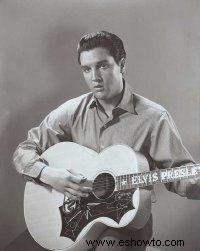
The next step in Elvis Presley's career would take him to new heights as a film star, beginning with his first movie appearance in Love Me Tender.
The first time that independent movie producer Hal Wallis saw Elvis perform, he was convinced Elvis was going to become a major star. A veteran of the movie business for 25 years, Wallis had a stellar reputation. He had worked as an executive producer at Warner Bros. for several years before forming Hal Wallis Productions in 1944.
In early 1956, Wallis happened to catch Elvis' act on one of the Stage Show episodes. The electrifying effect Elvis had on the women in the studio audience spelled movie magic to the keen-eyed producer. Wasting no time, he called Colonel Parker the next morning to set up a screen test for the controversial young singer. Parker was cool, playing Wallis like the experienced dealmaker he was, before casually replying that Elvis was planning to be on the coast soon and perhaps a meeting could be arranged.
On April 1, 1956, Elvis took a screen test with respected character actor Frank Faylen. They performed a scene from N. Richard Nash's play, The Rainmaker, which was soon to be made into a major movie. Although it happened on April Fools' Day, Elvis' screen test was taken quite seriously. His screen presence was powerful enough for Wallis to arrange a three-picture deal. If starmaker Hal Wallis had confidence in Elvis as an actor, then Hollywood was willing to accept that the young singer was well on his way to motion picture stardom.
Elvis had always loved the movies. When he was in high school, he had worked as an usher at Loew's State Theater in Memphis. Later in his life, when his superstar status prevented him from going out in public, Elvis often rented an entire theater just to be able to watch one movie in peace. From the beginning of his career, Elvis had aspired to be a movie actor. When his sudden notoriety opened the door for this to happen, he was eager to do whatever it took to make a career in the movies. "Singers come and go," Elvis said, "but if you're a good actor, you can last a long time."
Hal Wallis was working exclusively for Paramount Pictures at the time, but the studio had no suitable script for Elvis when he signed with Wallis. So Elvis was loaned to Twentieth Century-Fox for a Civil War drama called The Reno Brothers. His part in the movie was a secondary role, and both Robert Wagner and Jeffrey Hunter had originally been considered for the part. It was the first and last film in which Elvis appeared that was not specifically designed as a vehicle for him.
The movie's theme song was taken from a Civil War ballad called "Aura Lee" and reworked as "Love Me Tender." Elvis released the song as a single, which became immensely popular and gained wide exposure after he sang it on The Ed Sullivan Show. Because the tune was such a hit, the name of the movie was changed to Love Me Tender before it opened in New York on November 16, 1956.
The storyline follows the fortunes of a farm family after the Civil War. Elvis plays the youngest son, Clint Reno, who marries his eldest brother's girl. Everyone presumes that the brother has been killed in the war, but he returns unexpectedly. The family is torn apart by the consequences of the marriage, and in the end, Clint is shot and killed.
The producers of Love Me Tender worried that Elvis' fans would have a negative reaction to the movie's ending. Elvis' real-life mother, Gladys, was said to be shocked by his on-screen death. No one knew if people would stay away from theaters once word got out that Elvis' character was going to die in the last few frames.
In the movie's original ending, Mother Reno, played by Mildred Dunnock, rings the bell for dinner as the remaining Reno brothers come to supper. The pain and sadness on their faces indicate that Clint has gone to the Great Beyond. The end credits immediately follow this poignant but downbeat scene.
After the shooting of Love Me Tender was completed, Elvis was called back to make another ending for the movie. In this version, his character survives. However, the ending that was actually used in the final version of the film represents a compromise between the two. Clint Reno is killed, but Elvis' face is superimposed over the final scene as he sings "Love Me Tender." This version rings true to the original script, but fans are left with a more positive image of their idol.
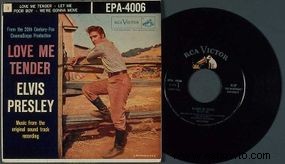
Love Me Tender has only four musical numbers, but the song "Love Me Tender" was such a big hit for Elvis that no one seemed to notice how few songs were in the movie. Some people have claimed that Hal Wallis hinted that Elvis' faithful backup musicians, Scotty Moore, Bill Black, and D.J. Fontana, were not welcome in Hollywood. Supposedly, he thought the trio was too unsophisticated to participate in a Hollywood recording session.
A group called the Ken Darby Trio backed up Elvis in the soundtrack recording sessions, but this was not Wallis's decision. He had nothing to do with the production of Love Me Tender because it was released by Twentieth Century-Fox. The story about the musicians is either untrue or it is about another Hollywood producer. In fact, Moore, Black, and Fontana appear in later movies that Elvis made for Wallis.
Elvis got along well with his costars, and he often deferred to their greater experience in making movies. Richard Egan, who played elder brother Vance Reno, said about Elvis:"That boy could charm the birds from the trees. He was so eager and humble, we went out of our way to help him." Years later, during Elvis' 1972 engagement in Las Vegas, Egan stood up after the final number and began an ovation for his former costar.
Throughout the production of Love Me Tender, Elvis nursed a crush on costar Debra Paget, beginning a career-long habit of falling for his female costars. In this case, however, his attentions went unnoticed because Paget was not interested. A couple of years older than Elvis, Paget was dedicated to her career at this point. Her mother, who was often on the set, had big plans for Debra, none of which involved Elvis.
Elvis' first screen performance got brutal reviews, which was no surprise considering the criticism by the popular press before he turned to acting. A reviewer for TIME magazine compared Elvis' performance at various times in the movie to a sausage, a Disney cartoon figure, and a corpse. A review in Variety was more to the point:"Appraising Presley as an actor, he ain't. Not that it makes any difference." But the critics' sarcasm fell on deaf ears. When a huge promotional cutout of Elvis as Clint Reno was unveiled atop a New York City theater, thousands of fans showed up to see Elvis' image larger than life.
Though Love Me Tender was a departure from Elvis' normal image, his next movie, Loving You, brought him right back to his rock 'n' roll roots. See the next section to learn more about Elvis Presley's second movie, Loving You.
For more fascinating information about Elvis Presley, see:
Elvis Presley and Loving You
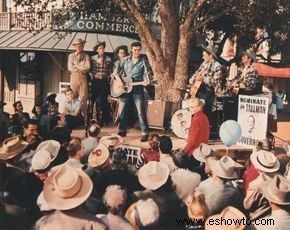
The first movie Elvis Presley made for producer Hal Wallis was Loving You. It was developed by Wallis and writer/director Hal Kanter specifically for the young star. Not only was this musical drama designed to showcase Elvis' best talents, but the storyline was rather ingeniously based on his own life.
Loving You, released by Paramount in July 1957, stars Elvis as an unknown but talented singer who has a totally new sound. His character, Deke Rivers, hails from the South, but he doesn't fit in with the country-music crowd. A ruthless music promoter, played by Lizabeth Scott, recognizes Deke's unique talent and exploits him as a fresh face who appeals to teenage audiences. The media misrepresents his appeal and brands him a dangerous hothead until Deke proves he has simply been misunderstood.
The storyline and the well-written tunes tailored to Elvis' musical style were guaranteed to attract his fans. Contrary to popular belief, Elvis received his first on-screen kiss in Loving You, not in Love Me Tender. The honor went to a young actress named Jana Lund. She had a small role in the movie as a sexy Deke Rivers fan who, unfortunately for Deke, has a jealous boyfriend.
To get the script as close as possible to real-life events, Wallis sent director Hal Kanter to Memphis to observe Elvis' act and lifestyle while he was on the road. Kanter was in Shreveport when Elvis gave one of his last performances on Louisiana Hayride.
Kanter's movie attempts to capture the excitement Elvis generated in his audience during a concert. The performance scenes in Loving You were accurate down to the constant popping of flashbulbs, the hysterical screaming of the audience, and the almost unbearable tension that built up before Elvis appeared on stage. In an article Kanter later wrote for Variety, he referred to Elvis' position in this mass hysteria as "the eye of the hurricane." It was a position Elvis would hold for the rest of his life.
Kanter also managed to depict the unpleasant side of Elvis' fame in Loving You. Fans are shown swarming around Deke Rivers in the film, just as Elvis was often followed and mobbed after he became famous. Fans infringe on Deke's personal life, making demands on his time and badgering him with selfish requests. Deke's fancy new automobile is covered with lipstick messages and phone numbers in the same way that Elvis' cars were sometimes defaced by female fans desperate to get his attention.
While making Loving You, Elvis went out with Yvonne Lime, an actress in the movie. Yvonne revealed what it was "really" like to date Elvis in the movie magazine Modern Screen. The article was just a publicity piece that presented Elvis as a shining example of wholesome living:He was the perfect gentleman, devoted to his mother, and liked to sing religious songs at parties. His rock 'n' roll image, long hair, and sideburns were explained away as a case of nonconformity.
Elvis asked his parents, Vernon and Gladys, to join him in Hollywood for the filming of Loving You because he had missed their company so much while making Love Me Tender. Hal Kanter arranged for them and some family friends to make a cameo appearance near the end of the movie as members of a concert audience. After Gladys's death, Elvis refused to watch Loving You because it was such a painful reminder of his mother.
In addition to his parents, Elvis' longtime backup musicians, Scotty Moore, Bill Black, and drummer D.J. Fontana, appeared in the movie as members of a country-western band. Even the Jordanaires popped up in the movie for a brief appearance.
The soundtrack for Loving You, which was Elvis' third long-playing album for RCA, reached No. 1 on some pop charts. This particular record also established a pattern in which songs from Elvis' latest film would be combined with tracks from recording sessions to make up an album. Elvis' films then served as elaborate promotions for his albums and vice versa. This was part of the Colonel's plan to get as much mileage from Elvis' movies as possible. One vehicle promoted the other for the maximum exposure of both.
Elvis followed up the success of Loving You with another successful film and album that was destined to become a classic. To learn more about Elvis Presley's hit Jailhouse Rock, see the next section.
For more fascinating information about Elvis Presley, see:
Elvis Presley and Jailhouse Rock
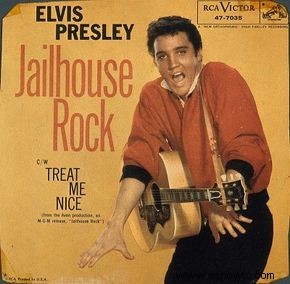
The next movie-and-album release from Elvis Presley was Jailhouse Rock . The extended-play (EP) album released as the soundtrack for Jailhouse Rock serves as a snapshot of the times. EP albums were a fixture in the recording industry during the 1950s, tapering off in popularity during the 1960s. Generally containing four to five songs, an EP offered the listener something more than a single, but it cost less than a long-playing album, which averaged ten to twelve songs.
Elvis' final commercially released EP was the soundtrack for Easy Come, Easy Go in 1967. The Jailhouse Rock EP also indicated the enormity of Elvis' popularity in the winter of 1957-1958, charting for an astounding 49 weeks and remaining at No. 1 for 28 weeks. Billboard named it EP of the Year for 1958. The highlight of the EP was the famous title song -- the embodiment of the Presley persona during that era.
Penned by the legendary Jerry Leiber and Mike Stoller, "Jailhouse Rock" became another No. 1 record for Elvis. It entered the British charts at No. 1, making it the first single ever to do so. The rock 'n' roll songwriting duo was commissioned to write most of the songs for the movie Jailhouse Rock, though they were less than enthusiastic about the assignment.
Prior to "Jailhouse Rock," Elvis had recorded a handful of songs from Leiber and Stoller, including "Hound Dog," "Love Me," and a couple of tunes from Loving You. The two songwriters were not impressed with Elvis' interpretation of their material. Leiber and Stoller had a tendency to write hard-driving, R&B-flavored tunes with satiric or tongue-in-cheek lyrics that could be understood at more than one level.
Elvis, on the other hand, performed most of his material straight, as when he recorded the duo's "Love Me," which they had originally intended as a lampoon of country-western music. Leiber and Stoller also felt that Elvis' foray into R&B territory was a fluke, and they were suspicious of his interest in blues and rhythm-and-blues.
When the three met during the April 1957 recording session for "Jailhouse Rock," Leiber and Stoller quickly changed their minds about Elvis. They realized he knew his music and he was a workhorse in the studio. The pair took over the recording sessions, serving as unofficial producers of "Jailhouse Rock," "Treat Me Nice," "(You're So Square) Baby, I Don't Care," and other tunes. Their collaboration with Elvis and his musicians on "Jailhouse Rock" resulted in the singer's hardest-rocking movie song. DJ. Fontana said of his drum playing, "I tried to think of someone on a chain gang smashing rocks."
The short period of time that Leiber and Stoller worked with Elvis proved beneficial to both sides. The irony and ambiguity in the lyrics of "Jailhouse Rock" gave Elvis one of his most clever rockers, while the singer's sincere and energetic delivery prevented the song from becoming too much of a burlesque -- a tendency with some of the Leiber and Stoller songs written for the Coasters. These songwriters hung with Elvis long enough to contribute to the King Creole soundtrack, among other projects, but eventually they ran afoul of Elvis' management for trying to introduce him to new challenges.
With its combination of hard-rocking tunes and romantic ballads, the Jailhouse Rock EP ably supported the film of the same title. King Creole boasts a powerful cast and a skilled director, and Blue Hawaii features slick production values, but the gritty, low-budget Jailhouse Rock remains Elvis Presley's best film. If Elvis the rock 'n' roll rebel liberated a generation from the values, tastes, and ideals of their parents, then Jailhouse Rock is the only Presley film that speaks directly to the feral, sensual, and unruly nature of rock 'n' roll music.
Elvis' musicals belong to that genre known as the "teenpic" or the teen musical, in which rock 'n' roll performers were showcased in musical vehicles designed to cash in on the immense popularity of youth-oriented music. From Rock Around the Clock, featuring real-life rocker Bill Haley, to Rock, Pretty Baby, starring actors pantomiming to ersatz rock tunes, producers and studios pandered to the teenage audience by combining teen fashion, teen jargon, and teen idols with a healthy dose of generational conflict.
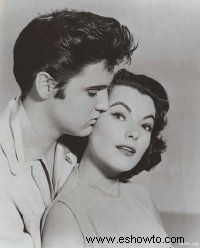
Released in 1957, Jailhouse Rock offers more than a superficial rundown of the latest fads and fashions, however, and it excludes the standard clash between generations. The plot features an insider's look at the rock 'n' roll record business (as interpreted by Hollywood) through the character of Peggy Van Alden, a record exploitation "man" (1950s title for a record promoter) who helps ex-con Vince Everett (Elvis' character) launch a singing career.
Because the audience sees the business through Peggy's point of view, the film's treatment of rock music differs from other teenpics. For example, rock 'n' roll is an established, accepted style of music when the story begins, and there is no organized resistance to it by authority figures. In general, the attitude toward the music in the script is both knowing and respectful, serving to validate rock 'n' roll as a popular art form -- an important consideration to teenagers of the era.
One scene does acknowledge the conflict in musical tastes between the generations. Vince and Peggy drop in on a cocktail party hosted by Peggy's parents. Mr. Van Alden is a college professor, so his friends and associates are depicted as upper-middle-class professionals. Bored and out of place, Vince is standing beside a group talking about music. A woman exclaims, "Some day they'll make the cycle back to pure old Dixieland. I say atonality is just a passing phase in jazz music. What do you think, Mr. Everett?" Vince snarls, "Lady, I don't know what the hell you're talking about!"
The scene curtly draws a line between the two types of music by generation and by class, and it concludes without the two sides attempting to reconcile, which was unusual for teenpics of this era. Instead, the jazz fans come off as snobbish and dull, while Vince's ultimate success with records, television, and movies validates his style of music. For once, rock 'n' roll bests another type of music and its proponents without a character having to explain or defend rock 'n' roll's existence.
The heart of Jailhouse Rock is the character of Vince Everett, who swaggers and prowls through the film with attitude and magnetism. Despite his Hollywood-style conversion in the final moments, it is Vince's impudence and haughty defiance that stay with the viewer long after the final fadeout. The character embodies the rebellious spirit and sexuality of rock 'n' roll, in much the same way that Elvis did in his career. This close identification between real-life performer and fictional character is the film's strength.
Several scenes and shots illustrate the similarities between the performing styles of Elvis and Vince and help audiences make the connection. Of particular interest is a scene in which Vince spends time in a recording studio searching for a singing style. Listening to himself croon "Don't Leave Me Now," he realizes that he lacks a personal style.
After rocking the tune just a bit, Vince discovers how "to make the song fit him." The scene echoes Elvis' efforts to work through a personal style at Sun Records back in the summer of 1954, an often repeated tale in Elvis' publicity. To make the connection between Vince and Elvis even stronger, the musicians used in the scene were Elvis' own backup band.
Also, Vince's costume in this scene duplicates Elvis' unique style of clothing. With his baggy black pants held in place by a thin belt and his tight-fitting shirt with turned-up collar and rolled-up sleeves, Vince sports the type of ultrahip attire Elvis purchased at Lansky's clothing store on Beale Street in Memphis. Similarly, Vince's hairstyle is a slightly cleaned-up version of Elvis' notorious ducktail and sideburns. Costuming and hairstyle might seem like minor details now, but to fans and audiences of the era, the similarities would have been obvious and meaningful.
Most of the songs were written especially for the film by Jerry Leiber and Mike Stoller, with Stoller making a brief appearance as a studio pianist during the scene in which Vince records "Don't Leave Me Now." The participation of these famous rock 'n' roll scribes in the making of the film adds an authenticity to it, as does the elaborate choreography for the title tune. Elvis participated in choreographing "Jailhouse Rock," with the steps based on his controversial performing style.
Thus, Elvis' image defined the role of Vince Everett as much as Vince perpetuated Elvis' image as a rebellious rock 'n' roller. For MGM and the producers, this guaranteed a sizable audience of Elvis fans. For audiences of the era, it added credibility and authenticity to the film. For contemporary audiences, it captured Elvis in his most popular incarnation -- the young rebel who not only changed the course of popular music but also gave a generation an identity and an attitude.
In retrospect, Jailhouse Rock may be Elvis' best film because of the way it captures the rebellious rock 'n' roll attitude of the 1950s. Yet, Elvis appeared in three other films between 1956 and 1958, and each of them spawned hit singles and chart-topping albums.
Despite the obvious attempt to cash in on Elvis' popularity as a recording phenomenon, Love Me Tender, Loving You, Jailhouse Rock, and King Creole are decidedly different from those films associated with Elvis during the 1960s. Musical dramas with solid supporting casts, the 1950s films benefited from the contributions of veteran Hollywood producers and directors. Chief among them was Hal Wallis.
For his next movie, King Creole, Elvis again expanded his acting talents, working with an incredibly talented supporting cast. See the next section to learn more about Elvis Presley and King Creole.
For more fascinating information about Elvis Presley, see:
Elvis Presley and King Creole
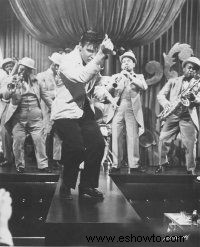
Elvis Presley's next movie, King Creole, was produced by Hal Wallis for Paramount. Based on Harold Robbins's novel, A Stone for Danny Fisher, this musical drama stars Elvis as troubled teenager Danny Fisher. Dean Jagger costars as Danny's father, a man who has fallen apart emotionally since the death of his wife, letting his family slip into dire poverty.
Determined to help his family regain the security and status it once had, Danny quits school to earn money by sweeping floors in a nightclub. A local mobster, played by Walter Matthau, takes an interest in Danny after he hears the talented young man sing. Danny becomes a regular performer in the mobster's club, packing in the crowds with his explosive performing style. But Danny seals his tragic fate when he becomes romantically involved with the mobster's girl.
Wallis had other intentions for this property when he first purchased it in 1955. At that time, a play version of A Stone for Danny Fisher was running off-Broadway, and Wallis may have originally intended the title role to go to Ben Gazzara, with more of the novel left intact.
Rumor has it that James Dean was also considered as a possibility for the role. When Wallis decided to use Elvis for the part of Danny Fisher, the original storyline had to be changed to accommodate Elvis' rock 'n' roll image. The setting was changed from New York City to New Orleans, although few characters other than Elvis speak with Southern accents. In the novel, Danny is an aspiring boxer; in the movie, he's an exciting young singer with a new sound.
Both Wallis and Paramount considered this movie to be an important project. The supporting cast features many notable actors, including Carolyn Jones, Dean Jagger, and Walter Matthau, and the director was respected veteran Michael Curtiz, who made Casablanca, Yankee Doodle Dandy, Angels with Dirty Faces, and many other Hollywood classics.
The high-quality production values plus the care taken in selecting the cast and crew paid off, because King Creole earned Elvis his best movie reviews. Many critics agreed that Elvis had improved tremendously as an actor, while others noted that he was "no longer depicted as the churlish, egotistical singing idol."
King Creole was shot in part on location in New Orleans. The film made effective use of such local sites as the French Quarter, Lake Pontchartrain, and a local high school. During location shooting, Elvis had a major problem with fans mobbing him at the Roosevelt Hotel, where he was staying. Hal Wallis arranged for heavy-duty security so Elvis could get enough rest to look fresh on camera.
Pinkerton guards patrolled the hallways, the elevators, and even the fire escapes of the hotel to keep well-intentioned but troublesome fans away. When he returned to his hotel in the evening, Elvis had to go to the top of an adjacent building, cross over the roof, and enter the Roosevelt by way of a fire escape. He was unable to enjoy New Orleans' celebrated nightclubs or famous restaurants because of the persistence of his fans.
Shooting in the city's streets was even worse; city policemen had to be used for crowd control. By this time, Elvis Presley had entered a new phase of his career that would keep him in seclusion, away from the fans who not only made him a star but also made him a recluse.
Elvis' first four movies are nothing like his later musical comedies. Aside from Love Me Tender, the plots of his early movies echo aspects of Elvis' image or actual events in his life. Loving You was a conventional Hollywood treatment of Elvis' rise to fame. Jailhouse Rock capitalized on Elvis' sensual, bad-boy image, and King Creole made use of certain details that paralleled Elvis' own life. In these movies, Elvis was clearly being groomed to take over for actor James Dean, who died in September 1955.
Elvis appealed to teenage audiences in much the same way as Dean and the young Marlon Brando. An article in Photoplay magazine, published during the shooting of Love Me Tender, indicated that David Weisbart, the producer of Dean's best-known movie, Rebel Without a Cause, was talking to Elvis about portraying Dean in a movie biography.
Elvis' role in King Creole had supposedly been offered to Dean. In 1956, a special single-issue magazine called Elvis and Jimmy showed how closely the two young men were linked in the popular imagination. The magazine designated Elvis to take up the fallen hero's leather jacket and become the premier teen rebel.
But instead of a rebel's leather jacket, Elvis surprised the world by donning a uniform and serving his country instead. To learn more about Elvis' time in the army, see the next section.
For more fascinating information about Elvis Presley, see:
Elvis Presley Joins the Army
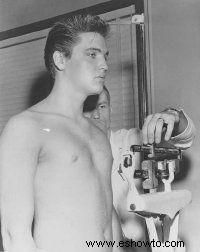
In 1958, Elvis Presley surprised fans and critics alike when he joined the army. He left behind the life of a celebrity to serve his country with pride, and was all the more cherished for it by fans.
On the night of Sunday, March 23, 1958, Elvis was riding the crest of a wave of popularity:Chart-topping records, hit movies, sold-out concerts, fan hysteria, and near-constant controversy all helped him become the biggest star on the planet. Yet on that March night, at the pinnacle of his success, with the world at his feet and an omnipresent support system of fans, relatives, and friends, it seemed as if he was giving it all away.
For more than a year the specter of military service hung over his head. When Uncle Sam came calling, Elvis passed his pre-induction physical and considered his options. Instead of taking the easy route chosen by so many celebrities in his position -- entering Special Services to entertain the troops -- he decided to show his allegiance to the Stars and Stripes by serving his time as a regular soldier.
In the face of overexposure and negative publicity about his destabilizing influence on American youth, Elvis' refusal to accept special consideration was viewed by the public in an admirable light. Though he made the most of his last night as a civilian, he seemed understandably upset about leaving his loved ones and giving up the good life. And, while making positive comments to press reporters, he was also said to be privately concerned that, after two years away, he'd never be able to pick up where he left off.
On the morning of March 24, accompanied by his parents, girlfriend Anita Wood, and various friends, Elvis reported to the draft board in the M&M Building on South Main Street in Memphis, and was soon traveling on a bus toward the Kennedy Veterans Hospital, where he and twelve other recruits were examined and processed.
Pronounced fit, Private Elvis Presley US 53 310 761 bid farewell to his distraught mother, weeping father, and Anita, and boarded yet another bus, this one bound for Fort Chaffee, Arkansas. Several hundred fans were in tow, as well as a posse of reporters and photographers intent on recording his every word and action, from folding his civilian clothes to making his army bed.
The next day, after undergoing further processing procedures, the King of Rock 'n' Roll was given the most famous haircut since Samson was tricked by Delilah. Before popping flashbulbs and whirring news cameras, Elvis good-naturedly submitted himself to a standard-issue GI cut...and promptly forgot to hand over the 65¢ fee out of the generous $7 partial pay that he'd been given a short time earlier. While a porter used a broom to sweep up the famous locks and discarded fragments of sideburn, the barber reminded Elvis that he owed some money.
Subsequently issued his U.S. Army uniform, Private Presley was assigned to the 2nd Armored Division at Fort Hood, Texas, for basic training and advanced tank instruction. Fans and members of the media followed him all the way there before Elvis' military superiors declared him off-limits to reporters and photographers following his first 24 hours at Fort Hood.
Once the immediate attention subsided, Elvis adapted to life with his fellow recruits, though he seemed desperately homesick at times. He phoned Gladys at least once a day, and many times both of them were in tears, with Gladys begging him to take proper care of himself and Elvis trying to reassure his worried mother.
While some of the soldiers gave him a hard time about his celebrity status, Elvis soon became friends with others such as Privates Rex Mansfield and William Norvell, as well as Sergeant Bill Norwood who, after suggesting that Anita Wood should visit, made his home available to her. Consequently, by the time he completed basic training at the end of May, the teen idol had begun to settle in. He earned his marksman's medal with a carbine and was classified as a sharpshooter with a pistol. Elvis had always loved guns, so it made perfect sense that he excelled in these exercises.
Life in the military wasn't always easy for Elvis, but he made the best of his two years of service. To learn more about Elvis' life in the military, see the next section.
For more fascinating information about Elvis Presley, see:
Elvis Presley's Life in the Military
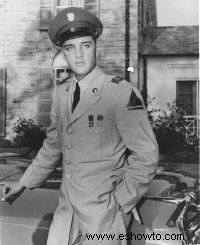
On leave for two weeks at the start of June 1958, Elvis spent time with family and friends. He also recorded several new tracks in Nashville to help satisfy RCA's need for new material while he was out of commission. Then he returned to Fort Hood, and after receiving the standard soldier's permission to live off base with his "dependents," he obtained a three-bedroom trailer home and moved there with his parents, grandmother Minnie Mae, and friend Lamar Fike.
When the trailer became a little too cramped, following the arrival of cousins Gene and Junior Smith, he simply rented a house where he could stay with his family on the weekends while undergoing advanced tank training during the week. Friends from all over would drop by, and Gladys would prepare food for everyone. All in all it was a pretty cozy setup until Gladys's health declined, and she and Vernon had to return to Memphis at the start of August.
Ever since her son's induction, Gladys had been anxious about his well-being and distraught at the thought of his absence for an extended period of time. Now extremely sick and unable to eat, Gladys was admitted to Methodist Hospital on August 9 with acute hepatitis.
Having completed his advanced tank training, Elvis was about to commence his basic unit training, but it quickly became clear that his mother's condition was serious. On August 12 the Army granted him emergency leave. Elvis headed straight for the hospital, and when his mother saw him she appeared to rally. However, during the early hours of Thursday, August 14, 1958, with Vernon by her side while Elvis was at home, Gladys Love Presley succumbed to a massive heart attack. She was just 46. It was a blow from which Elvis would never fully recover.
Elvis broke down several times in the days leading up to his mother's funeral. He sobbed hysterically while Gladys' favorite gospel group, the Blackwood Brothers, performed at the service in the Memphis Funeral Home, and he was equally inconsolable at her Forest Hill Cemetery grave site, crying out, "Oh God, everything I have is gone."
The mourning continued through the next few days as Elvis was granted extended leave. Evidently his fans were grieving too -- they sent him more than 100,000 cards and letters, around 500 telegrams, and more than 200 floral arrangements to express their sympathy for his loss. Still, even though it would never be the same, life had to carry on. Elvis returned to Fort Hood on August 24, and within a month he shipped out to join the 1st Medium Tank Battalion, 32nd Armor, 3rd Armored Division in what was then known as West Germany.
Along the way, Colonel Tom Parker organized a press conference when Elvis' troop train arrived in Brooklyn, New York, at which he answered questions about his army duty, his music, and his mom. He offered a heartfelt account of his continued mourning to the assembled reporters:
"Everyone loses their mother, but I was an only child, and Mother was always right with me all my life. And it wasn't only like losing a mother, it was like losing a friend, a companion, someone to talk to. I could wake her up any hour of the night if I was worried or troubled about something...she'd get up and try to help me."During the transatlantic trip aboard the U.S.S. General Randall, Elvis bonded with a fellow singer named Charlie Hodge, whom he'd met on the troop train to Brooklyn, and together they took charge of a talent show. But without his mother to see or talk to ever again, Elvis seemed lonely and adrift.
In West Germany, there was another press conference and further meet-and-greets during the first few days. Vernon and his mother, Minnie Mae -- whom Elvis had affectionately called "Dodger" ever since she had ducked away from a ball he had thrown at her as a child -- set up residence with Elvis and his friends Red West and Lamar Fike in a couple of hotels:one in Bad Homburg, near Frankfurt; the other in Bad Nauheim, about 20 minutes from the base.
Elvis would rise every morning at 5:30, eat the breakfast Dodger had prepared for him, and leave for base by 6:30 in a black Mercedes taxi, before returning for lunch and dinner. The only exception was Friday, when Elvis and his fellow soldiers had to stay late into the evening, cleaning the toilets and their barracks for weekly inspection the following morning. It had been a long time since the King was obliged to do any such chores, yet he mucked in with the other soldiers and did his best to be perceived -- during the day, at least -- as just a regular guy.
Some evenings, Elvis and his friends surreptitiously went to the movies -- sneaking into theaters after the lights went down and leaving just before the final credits to avoid being noticed -- and even to a couple of Bill Haley concerts. Elvis also dated a few girls while keeping in regular phone contact with girlfriend Anita Wood back in America.
Through November and much of December, Private Presley went on maneuvers at Grafenwohr and was promoted to Private First Class for his endeavors in field exercises. It was reportedly around this time that one of the sergeants introduced him to amphetamines as a means of staying awake during the long hours of training. For Elvis, taking amphetamines quickly became a regular habit.
Although he returned to Bad Nauheim to spend the holiday season with family and friends, he also spent part of Christmas Eve helping to decorate the company's Christmas tree. Then, at the start of January 1959, one of the girls whom Elvis had briefly dated, 19-year-old Elisabeth Stefaniak, moved into the Hotel Grunewald with him and his inner circle, having accepted an invitation to work as his secretary.
It was particularly handy that, courtesy of her German mother and American stepfather, Elisabeth was bilingual. So, installing herself in a corner room at the hotel, she answered his fan mail and became romantically involved with him despite the knowledge that he continued to see other girls.
The time Elvis spent in the army was a whirlwind of activity. See the next section to learn more about what Elvis did on leave, and to read about the end of Elvis' military career.
For more fascinating information about Elvis Presley, see:
The End of Elvis Presley's Military Career
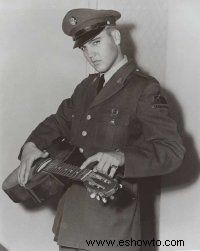
In early February the Presley clan relocated to a three-story, five-bedroom house at Goethestrasse 14, which afforded everyone more space and privacy than the nearby Hotel Grunewald. For the exorbitant rent of $800 a month, it also provided them with a landlady named Frau Pieper who doubled as their housekeeper.
At last, Elvis was living in a home where he could relax away from prying eyes, listen to records, entertain friends, and sit at a piano to play and sing his favorite songs. He came home every day for lunch, and each evening he would spend time signing autographs for fans who waited patiently in front of the house. On Sundays he and some friends would play touch football just down the street.
Early in 1959, accompanied by friends Red West and Lamar Fike, Elvis used a three-day pass to visit Munich and call unannounced on Vera Tschechowa, an 18-year-old actress whom he'd met a few months earlier. Together, they visited the Moulin Rouge nightclub.
As usual, the press was on hand to photograph Elvis with his "latest flame." In this case they also took numerous shots of him posing with the club's showgirls, but all it really amounted to was a footloose and fancy-free young man having some fun. Enough fun, in fact, for him to pay a return visit to Munich's Moulin Rouge nightclub in mid-June before continuing his two-week furlough by traveling to Paris and dropping in on the original Moulin Rouge.
By June, Red West had returned to the United States, so Elvis was accompanied by Lamar Fike as well as his two army buddies Charlie Hodge and Rex Mansfield when visiting Parisian nightspots including the Lido, the Folies Bergère, and a club called Le Bantu that didn't even open until 4:00 a.m. All in all, the Paris stopover was reported to have been a live-by-night, sleep-by-day adventure. Elvis returned to the French capital for one last adventure in January 1960, although by then a new girl was occupying his thoughts.
Fourteen-year-old Priscilla Beaulieu had only recently been voted "Queen of Del Valley Junior High" by her classmates in Austin, Texas, when 24-year-old Elvis Presley first met her on the evening of Sunday, September 13, 1959. Brunette, with a sensuous mouth and sultry blue eyes, she was wearing a navy and white sailor dress with white socks and shoes; he, a bright red sweater and tan slacks. Brenda Lee's "Sweet Nothin's" was spinning on the record player.
Priscilla, as can be expected, seemed in awe of the superstar, while Elvis was said to be instantly infatuated with the beautiful stepdaughter of Air Force Captain Joseph Beaulieu. Captain Beaulieu had been transferred to Wiesbaden, a 45-minute drive from Bad Nauheim, just a month earlier, and Priscilla had been invited to visit Elvis at his home by mutual acquaintance Currie Grant, a U.S. Airman and assistant manager at Wiesbaden air force venue the Eagle Club.
Elvis spent the rest of that Sunday evening talking to Priscilla and, amid a room full of friends, even sang to her. It wasn't long before he asked Currie Grant to invite her back.
Soon Elvis and Priscilla began dating, and after Elvis met Priscilla's parents and convinced them that his intentions were honorable, they saw each other frequently during his last few months in West Germany. Because of Elvis' inability to go out in public unrecognized (and without creating a mob scene), most of his dates with Priscilla consisted of her visits to his house, where they were surrounded by Elvis' family members and friends. Although a relationship with someone so young could have had a ruinous effect on Elvis' image, there was surprisingly little publicity about his interest in Priscilla.
Elvis was promoted to sergeant on January 20, 1960, received his stripes on February 11, and was scheduled to be discharged from the Army in early March. Accordingly, he began preparing for the resumption of his life at Graceland and his career in Nashville and Hollywood, sending old girlfriend Anita Wood a French poodle for Christmas and calling her more frequently as his return to America drew closer.
Regardless, word of his relationship with Priscilla did reach the media, and on March 2, the day of his departure from West Germany, press photographers and news cameras captured her somber face as she waved good-bye to her love at the Rhein-Main airbase. The photos ended up in Life magazine, and Priscilla was labeled "the girl he left behind." Which she was...for the time being.
Discharged on Saturday, March 5, after disembarking in Fort Dix, New Jersey, Elvis finally arrived back in Memphis two days later amid a snowstorm and much hoopla. That afternoon, sitting in his father's office behind the main house at Graceland, he gave a press conference, during which he acknowledged -- yet tried to play down -- his relationship with Priscilla Beaulieu, focusing instead on how happy he was to be back home. "I just can't get it in my mind that I'm here," he told the media.
Elvis wasn't the only Presley to find a new love in Germany. His father, Vernon, met Dee Stanley while the Presley family was living in Bad Nauheim. At the time they met, Dee was in the process of divorcing her military husband. Dee returned to America with Vernon after Elvis' discharge, and the two were married in Huntsville, Alabama, in July 1960. Elvis did not attend his father's wedding, which led to speculation that the marriage caused friction between the two men. (Elvis not only gained a stepmother, but he got three stepbrothers as well.)
As time would tell, Elvis was a changed man when he emerged from the Army. Critics speculated that the damage done to his career during his two years in the Army could be irreparable. Instead, Elvis surprised everyone by trading in the frenzied trappings of his rock 'n' roll youth for a more mature image built on the good publicity from his tour of duty. The success of his movies and pop music albums was a testament to the wide appeal of his new, more mellow style. See the next section to learn more about Elvis' return to America.
For more fascinating information about Elvis Presley, see:
Elvis Presley Returns to America
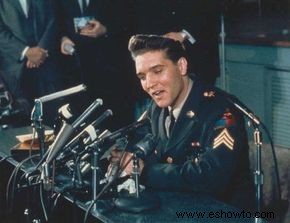
As soon as Elvis set foot on American soil after his discharge from the army, reporters descended on him with questions about his career. Newspaper interviews revealed that he did not intend to abandon rock 'n' roll "as long as people wanted it." Yet, almost immediately, Elvis and Colonel Parker embarked on a course designed to do just that; they altered Elvis' image by using the same entertainment arenas that had constructed his image in the first place -- recordings, television, and the movies.
Elvis and Colonel Parker were no longer interested in rock 'n' roll, which had changed between 1958 and 1960. If anything, rock musicians were more controversial than ever:Little Richard was in trouble with the IRS; Chuck Berry had been arrested for violating the Mann Act; and Jerry Lee Lewis was ostracized for running away with and marrying a 13-year-old girl. To make matters worse, at least in the eyes of the press, the girl was Lewis's cousin and he was already married at the time. All these scandals served to temporarily put their careers on hold and damage rock 'n' roll's already tarnished reputation.
While scandal claimed some rockers, death claimed others such as Buddy Holly, Ritchie Valens, the Big Bopper (J.P. Richardson), and Eddie Cochran. The loss of these rock pioneers from the music scene contributed to the rise in popularity of ballad singers. As early as 1958, articles in music magazines began to note with pleasure that ballad singers were replacing the more frenzied performers who had been on the charts.
When Elvis returned home in 1960 -- amid headlines blaring "Chorus of Teenage Squeals Rocks Elvis Out of the Army" and "The Army's Made a New Man Out of Elvis" -- the stage was set for him to take up a more mellow style. The Colonel took advantage of the good publicity over Elvis' tour of duty to promote a more mature Elvis who he hoped would attract a larger audience.
Rock 'n' roll critics and fans view this change as a decline, but in reality it was a deliberate change in Elvis' image. Elvis and his manager abandoned the notoriety of rock 'n' roll for the wider appeal of movies and pop music. In terms of financial success and overall popularity, they made the right decision.
A single image sums up the ramifications of this important switch in the young singer's career:Elvis' long ducktail haircut, which had been so ceremoniously shorn for his army induction, was never grown back.
Two weeks after his discharge, Elvis journeyed to Nashville for his first recording session in almost two years. Elvis was joined in the studio by two of his oldest friends, guitarist Scotty Moore and drummer D.J. Fontana. Bill Black, who had played doghouse bass for Elvis, was no longer part of his band. Moore, Black, and Fontana had been Elvis' backup musicians during most of his early career, but in the fall of 1957, Moore and Black resigned as regular members of Elvis' band.
Money probably had a lot to do with their decision as Scotty and Bill were paid only $100 a week while they were in Memphis and $200 a week while they were on the road. It is assumed that the Colonel was responsible for the skimpy wages, but throughout his career Elvis was never known to pay very high wages to any of the people who worked for him.
Black eventually formed his own group, the Bill Black Combo, and in 1959 they recorded an instrumental tune called "Smokie." Moore continued to record with Elvis in the studio on a freelance basis until 1969. D.J. Fontana, who had been recruited from Louisiana Hayride, had a separate arrangement with Elvis, which allowed him more leeway in his career.
Moore and Fontana were not the only musicians hired for the Nashville recording sessions. The famed country pianist Floyd Cramer signed on, and once again the Jordanaires sang backup vocals. During the first session, Elvis cut a single featuring "Stuck on You," with "Fame and Fortune" on the flip side. In early April, Elvis returned to the RCA studio in Nashville to record the additional tracks that were needed to make an album.
By the end of April, Elvis Is Back! had been released. In less than two months, RCA had cut and pressed this brand-new Elvis Presley album, and it was playing on the radio. To learn more about Elvis Is Back!, see the next section.
For more fascinating information about Elvis Presley, see:
Elvis Is Back
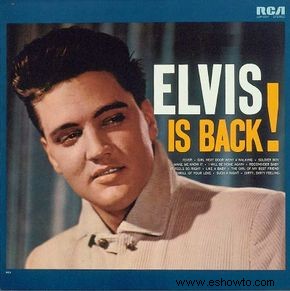
Elvis returned from the army to a music scene very different than the one he had left. Smooth-sounding teen angels, such as Bobby Vee, Bobby Rydell, Frankie Avalon, and Connie Francis caught the ears of young listeners, while the dance craze the Twist propelled them across the dance floor. Elvis and his manager, Colonel Tom Parker, embarked on a campaign to mold his image around current trends and away from the controversy that had followed him before the army. The rebellious persona was cast aside for a mature public image; in his music, the innovation of his Sun Studio roots was replaced by the calculation of mainstream ambitions.
While many have criticized this change, it did not represent a decline in the quality of Elvis' music. On the contrary, Elvis Is Back represents a peak in the singer's career, when his maturity and confidence led to a control and focus in his music. Like the pre-army Elvis recordings, this album offered an eclectic collection of musical genres, from a sentimental duet with Charlie Hodge called "I Will Be Home Again" to the gritty "Reconsider Baby" with a bluesy sax solo by Boots Randolph. Once again, Elvis' talent for unifying disparate styles of music resulted in an innovative and successful album, and it reached No. 2 on the charts.
Not all the songs that Elvis recorded in Nashville were included on the Elvis Is Back album. RCA held back for later release two of his highly acclaimed ballads:"It's Now or Never" and "Are You Lonesome Tonight?" The melancholy tune "Are You Lonesome Tonight?" was a clear departure from the kind of music that Elvis sang before he went into the army.
In the 1920s, Al Jolson had made this song popular, but Elvis was probably more familiar with a 1959 version of the song that was recorded by pop singer Jaye P. Morgan. She had borrowed her arrangement from a 1950 rendition by the Blue Baron Orchestra. It is believed that Colonel Parker urged Elvis to record "Are You Lonesome Tonight?" even though it was unusual for him to interfere with Elvis' choice of music. The song perfectly suited Elvis' new image as a mainstream pop singer.
Who could have guessed that "It's Now or Never," a reworked version of the 1901 Italian opera-style classic "O Sole Mio," would become the King of Rock 'n' Roll's biggest-selling single? But then, in 1956, when Elvis was skewered by most newspapers in the country for thrusting his hips to the bluesy beat of "Hound Dog," no one would have known that he would become a press favorite in just four years.
By quietly serving his country in the army from 1958 to 1960, Elvis had won the hearts and minds of the mainstream press and general public. "It's Now or Never" received airplay on conservative radio stations that previously wouldn't have touched a Presley record, thus exposing Elvis to a wider, adult audience.
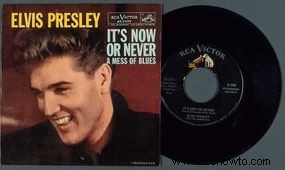
Yet Elvis did not record the song just to gain a broader audience. "O Sole Mio" was written by G. Capurro and Eduardo di Capua at the turn of the twentieth century, but it had been made popular much later by Mario Lanza. Elvis was a fan of Lanza and undoubtedly heard the opera singer's recording, but he had also heard the English version "There's No Tomorrow" by Tony Martin.
While still in the army, Elvis asked his music publisher, Freddie Bienstock of Hill and Range (part of RCA), to find someone to write new lyrics for the song. The only songwriters available at Hill and Range to do it were Aaron Schroeder and Wally Gold, who jumped at the chance because they knew the royalties on an Elvis Presley song would be enormous. They composed the lyrics in less than 30 minutes. A singer named David Hill (aka David Hess) recorded the demo with a cha-cha arrangement, and Elvis loved it. He was challenged by its operatic style and attracted to its drama.
"It's Now or Never" charted for 20 weeks, holding the No. 1 spot in the U.S.A. for five weeks. Worldwide sales of the tune, according to The Guinness Book of Recorded Sound, eventually exceeded 20 million copies.
On May 8, 1960, Elvis appeared on TV for the first time since his discharge from the army. He was a guest on The Frank Sinatra-Timex Special, also known as Welcome Home Elvis. Colonel Parker had made the deal with the show's producers months before Elvis was released from active duty. He had hoped that appearing with Frank Sinatra would introduce Elvis as a pop singer to a wide audience made up of adults and pop enthusiasts as well as teenagers and country-western fans.
Never one to take chances, the Colonel made sure Elvis would make a big splash by packing the studio audience with 400 members from one of Elvis' biggest fan clubs. The program received phenomenal ratings, giving ABC-TV a 41.5 share for that evening. Elvis was paid a staggering $125,000 for a total of six minutes on the air.
Sammy Davis, Jr., Peter Lawford, and Joey Bishop, members of Sinatra's famed "Rat Pack," also appeared on the television special. In addition, the cast included Sinatra's daughter Nancy, whom the gossip columns had recently linked with Elvis. Elvis sang his two latest hits, then later in the show he joined Sinatra for a short duet.
Dressed in a conservative but stylish tuxedo, the former teen idol sang Sinatra's "Witchcraft," while Sinatra crooned Elvis' "Love Me Tender." His choice of clothes, shorter hairstyle, and connections with the Rat Pack indicated that Elvis' career was taking a new direction. When Elvis and Sinatra sang each other's songs, it was as though Sinatra was passing on his position as pop idol to the next generation:The Voice, as Sinatra was known in the 1940s, was making way for the King.
In Ed Sullivan's syndicated newspaper column in the New York Daily News, May 1960, the crusty show business luminary spoke harshly of Elvis' appearance on the The Frank Sinatra-Timex Special. Lingering bitterness over his dealings with Colonel Parker crept into his account. Sullivan blasted Parker for allowing Elvis to sing only two songs in the special, stating, "Col. Tom, using the logic of a farmer, is a firm believer in not giving a hungry horse a bale of hay."
Sullivan seemed to forget that it was Sinatra's special, not Elvis', and there were four other guests to showcase as well. Some jabs at how Elvis looked rounded out the column as Sullivan noted that the young singer, "minus his sideburns, has substituted what the ladies probably would call a 'high hair-do.' His hair is so high in front that it looks like a ski jump."
Less than a year later, on March 25, 1961, Elvis performed live at the Bloch Arena at Pearl Harbor, Hawaii. The show was a fundraiser to build a memorial for the USS Arizona, the largest of the eight battleships that had been sunk on December 7, 1941, during the surprise Japanese air attack on Pearl Harbor. Ticket prices for Elvis' performance ranged from $3 to $10 a seat, with 100 ringside seats reserved for people who donated $100.
Elvis and Colonel Parker bought 50 of these special seats and donated them to patients from Tripler Hospital in Hawaii. Elvis' benefit raised more than $52,000 for the memorial fund. On March 30, the Hawaii House of Representatives passed Special Resolution 105 thanking Elvis and the Colonel.
The benefit for the Arizona memorial could be considered a good career move in that it helped Elvis become more acceptable to an adult audience, but his career was not the only reason Elvis agreed to do the concert. He had a sensitive, generous nature, and throughout his entire life, Elvis gave freely to charities and other worthy causes, whether he received publicity for it or not.
Five years after this benefit, while in Hawaii filming Paradise, Hawaiian Style, Elvis visited the completed memorial and placed a wreath there. Photographers and reporters rushed in to record the event, but Elvis sent them away. He did not want his visit to the memorial to become a publicity stunt.
After the success of Elvis Is Back and "It's Now or Never," Elvis and the Colonel decided it was time to revive Elvis' film career as well. See the next section to read about Elvis' return to Hollywood.
For more fascinating information about Elvis Presley, see:
Elvis Presley Returns to Hollywood
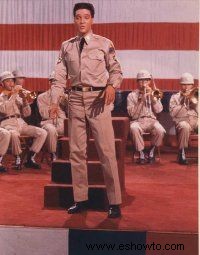
The 1961 concert in Hawaii marked Elvis Presley's last live performance until 1969, and he made no television appearances after the Sinatra special until December 1968. Throughout most of the 1960s, if Elvis' fans wanted to see him, they had to see him on the silver screen.
In May 1960, Elvis had returned to Hollywood to begin shooting G.I. Blues. The movie's storyline is about a singer serving in the army in Germany. Producer Hal Wallis borrowed details from Elvis' own life to flesh out the script just as he had done in the two previous films he made with Elvis. In G.I. Blues, Elvis' character is not only stationed in Germany, but he's also a member of a tank division just as Elvis had been.
Like the movies Elvis made before going into the army, G.I. azules is based on the events of his own life, but it is a musical comedy instead of a musical drama. G.I. azules was aimed at a family audience, and Elvis' controversial performing style had been toned down. Even though most of the songs are fast-paced, they don't have the same hard-driving sound, sexual connotation, or emotional delivery of Elvis' prior soundtrack recordings.
Elvis' screen image was deliberately softened for G.I. Blues. In one scene, he sings a Bavarian-sounding folk tune during a children's puppet show, while in another, he baby-sits an adorable infant. The movie's ads perfectly sum up these changes:"See and Hear the New Elvis:The Idol of the Teenagers is the Idol of the Family."
G.I. azules was enormously successful, ranking fourteenth in box-office receipts for 1960. The soundtrack album reached No. 1 quickly, remaining on the charts longer than any other Elvis Presley album. Movie critics applauded the new Elvis. They approved of his new image and predicted he would find plenty of new fans among older women. Elvis didn't share the critics' enthusiasm for G.I. Blues. He felt that there were too many musical numbers and believed some of them made no sense within the context of the plot. He was concerned that the quality of many of these songs was not as good as the music for his earlier movies.
Elvis was eager to move on to more demanding and serious roles. The western Flaming Star gave him the chance to prove himself as an actor. The movie brought together some of Hollywood's most notable actors and creative personnel. In this tense drama, Elvis was able to hold his own with veteran performers John McIntire and Dolores Del Rio. Newcomer Barbara Eden, who later starred in the TV series I Dream of Jeannie, was also featured in the film.
Director Don Siegel, who later won critical acclaim for his work on the original Dirty Harry, fashioned a strong statement on racial prejudice out of the script, which had been based on a popular novel by Clair Huffaker. Nunnally Johnson, a longtime Hollywood producer and screenwriter, cowrote the script with Huffaker. Established composer Cyril Mockridge produced the background music.
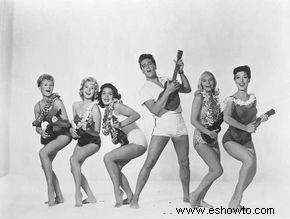
Elvis got one more shot at serious acting when he was signed to star in the drama Wild in the Country. The film, directed by Philip Dunne, was from a script by playwright Clifford Odets. It features Elvis as Glenn Tyler, a young hothead from the rural South who tries to straighten out his life after serving time in a juvenile hall. The original script for this movie had no original songs, but after Flaming Star 's poor showing at the box office, they added six musical numbers to Wild in the Country. Only four of them made the final cut.
In addition to the title tune that is sung over the opening credits, Elvis sings a song to each of the three women in the movie. Even with the musical numbers, the film was deemed a disappointment by Elvis' fans. Like Flaming Star, the movie didn't lose money at the box office, but it wasn't a smash success either.
Both Elvis and costar Tuesday Weld were voted the Damp Raincoat Award as the most disappointing performers of 1961 by Teen revista. While awards such as this can hardly ruin anyone's career, they indicated to Elvis and the Colonel that this type of film was not what Elvis' most devoted fans wanted to see. Elvis did not accept another serious role until the end of his film career.
The standard interpretation of Elvis' career in the movies is to view this juncture as the beginning of the end, because he seemed to give up his dream of becoming a serious actor. However, after Wild in the Country, Elvis made 24 movies, all of which were financial and popular successes. Therefore, it seems appropriate to give Elvis' film career a different spin:Elvis Presley did not become a serious actor, but he was an extremely successful movie star.
The first in this string of successful and popular movies was Blue Hawaii. To learn more about Elvis' role in Blue Hawaii, see the next section.
For more fascinating information about Elvis Presley, see:
Elvis Presley and Blue Hawaii

On March 14, 1961, Elvis and assorted friends, assistants, and bodyguards flew to Los Angeles so he could begin production on his next film, Blue Hawaii. Upon his arrival, he spent a few fun-filled days with friends Juliet Prowse, Joan Blackman, and Pat Fackethal, a real-life stewardess selected to play a bit part as a stewardess in the film. Afterward, he buckled down to record the songs that would comprise the soundtrack. Elvis recorded the tunes for the modestly budgeted musical comedy in Hollywood as opposed to Nashville, where much of his nonsoundtrack music was produced.
While this was business as usual for Presley that year, in retrospect it marks a juncture in his career. His management team, made up of Colonel Parker, Elvis, Hal Wallis, and Abe Lastfogel, Elvis' William Morris agent, had already determined that movies should be the focus of his career, but Blue Hawaii would narrow that focus further. Because it was Elvis' highest-grossing film at the box office, it became the model for the type of musical comedy associated with him during the 1960s. As the decade progressed, all other Elvis recordings took a backseat to the music for the movies.
The soundtrack to Blue Hawaii may have been miles away from rock 'n' roll or rhythm-and-blues, but it gave Elvis the song with which he would close most of his 1970s concerts:"Can't Help Falling in Love." Recorded at Radio Recorders in Hollywood in 1961, Blue Hawaii featured 14 songs, more than any other Elvis soundtrack.
The material was not particularly creative, nor did it have the mix of sounds found on Elvis Is Back!, but it is a solid example of that blend of pop and rock that defined Elvis' movie music. Blue Hawaii -- the album and the movie -- was aimed at a far wider audience than his studio recordings. Elvis' management was interested in appealing to the mainstream audience and generating spectacular sales.
They were less concerned with the impact of his music or his role as a musical innovator. This and other soundtrack albums were meant to serve a different purpose and to appeal to different audiences. Unfortunately, as the 1960s wore on, the movie material declined in quality, reflecting poorly on all the soundtracks.
Most of the 14 songs on the album are pop-style tunes. Some of these were not written for the film but had been recorded and released previously, including "Moonlight Swim," "Blue Hawaii," and "Hawaiian Wedding Song." "Aloha Oe" was composed by Queen Liliuokalani of Hawaii in 1878. The title tune and the song "Aloha Oe" had been recorded in the 1930s by Bing Crosby during a craze for the allure of the tropical isles.
The songs composed for the film were not rock 'n' roll either, although "Rock-a-Hula Baby" is a playful pastiche of rock 'n' roll dance crazes. To capture a Hawaiian-style sound, special musicians were employed for the recording sessions. Percussionist Hal Blaine, whose expertise involved Hawaiian instruments, joined drummers D.J. Fontana and Bernie Mattinson. Steel guitar and ukelele players were also added.
Blue Hawaii became Elvis' biggest-selling movie soundtrack. It topped the Billboard albums chart two months after its October 1961 release. It was the No. 1 album in the country for 20 weeks, which set a record for a rock performer or group that lasted until 1977 when Fleetwood Mac's Rumors broke it. Blue Hawaii remained on the albums chart for 79 weeks and was awarded double platinum status by the RIAA in March 1992.
After the soundtrack was recorded, Elvis and his entourage flew to Honolulu for a month's worth of location shooting. Hawaiian fans were as enthusiastic as those on the mainland, persistently trying to get into Elvis' hotel to see their idol. A few pretended to be mail messengers with special delivery packages that only Elvis could sign for; others managed to climb the fire escape.
Fans gathered on the beach by his hotel and scratched messages in the sand that Elvis could see from his window. Finally, a 24-hour guard was posted outside Elvis' room, and Elvis curtailed his off-set activities. Elvis' personal time in Hawaii was anything but the fun-filled, action-packed adventure portrayed in the film.
The exotic locale was a key element in the promotion of Blue Hawaii and in its success. The scenery provided more than just beautiful cinematography. As a tropical paradise, Hawaii was the perfect setting for romance, and it represented an escape from the mundane everyday world of most viewers. Even the title reinforced the locale, reminding audiences of the beautiful paradise that had become America's 50th state amid much fanfare in 1960.
The entertainment industry had taken advantage of the public interest in Hawaii's admittance to the union with the release of Blue Hawaii and Gidget Goes Hawaiian on the big screen in 1961 and the TV series Hawaiian Eye on the small screen in 1959.
The romance and escape that went with these settings became an essential ingredient in the formula for Elvis' later movies. He returned to Hawaii to make Girls! ¡Muchachas! ¡Chicas! and Paradise, Hawaiian Style and went to Florida to make Follow That Dream; Girl Happy; Easy Come, Easy Go; and Clambake. The movies Fun in Acapulco, It Happened at the World's Fair, and Viva Las Vegas provide action in obvious places. The films Harum Scarum and Double Trouble offer fabulous adventures in distant countries.
Any viewer familiar with Elvis' movies recognizes the prevalence of unique and exotic locations, but not all realize the extent to which these settings affect the whole film. For example, Elvis' characters were independent spirits who worked as race-car drivers, pilots, tour guides, entertainers, or boat captains -- unusual occupations, to say the least. Yet they seem almost appropriate given the exotic settings. In a way, the settings determined the occupations of Elvis' characters, which indirectly helped define them as free souls who reject the conventional, nine-to-five lifestyle.
In addition, exotic and vacation settings convey the idea of slipping off to paradise for romantic escapades. For decades, travel brochures have used this very notion to entice tourists to distant lands. As soon as viewers recognized the setting of an Elvis film as exotic, unique, or a haven for fun-seeking vacationers, the stage was set for romance.
And romance was the main attraction in an Elvis Presley movie. The plot may center around a quest or an adventure, but it parallels the pursuit of a beautiful woman by Elvis' carefree hero. The story concludes when the goal is completed or the quest fulfilled, which is represented by the union of Elvis' character with his leading lady. The complete closure of the film in terms of fulfilling the goal and winning the girl is generally indicated by the final musical number in which the couple are united via song and/or dance.
Blue Hawaii firmly established this pattern. Here, Elvis played Chad Gates, an ambitious young man just out of the army who refuses to go into the family business. By the end of the film, after several misadventures, he has formed his own tour-guide service.
The fact that he is a success is indicated by his marriage to his girlfriend, Maile, because he refused to marry her until he had proven himself. "Hawaiian Wedding Song," which concludes Blue Hawaii, is part of their wedding ceremony and serves to announce their union. The fulfillment of Chad's dream and the winning of Maile are neatly tied together in this final number.
"Hawaiian Wedding Song" provides an excellent example of how Elvis' music changed from his pre-army movies to the Presley travelogues. Elvis does not sing this song in a stage setting; he sings to someone who shares the spotlight with him, and the song advances the story. Most of the production numbers in the film are presented in a similar fashion, which was the exact opposite of the musical numbers in his pre-army films.
Blue Hawaii established the formula for the presentation of the songs in Elvis' movies thereafter. In Elvis' post-army vehicles, the songs are integrated into the storyline, helping to advance the story or relate something about the characters to the viewers. In this type of musical, characters tend to burst into song at any moment -- on the beach, in a car, even on a horse. Elvis disliked this type of musical and was uncomfortable when his character sang in situations where people would not normally sing.
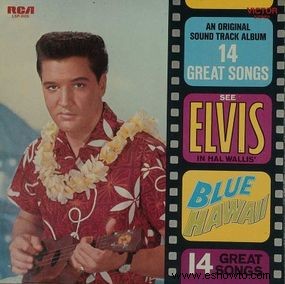
Because the musical numbers often tell part of the story, it is not unusual for them to include other characters. Most often, Elvis' characters sing to or dance with the leading ladies as a means of winning their love or to symbolize the couple's growing affection. Sometimes the film will feature Elvis singing to a child, a pet, or an elderly woman to help soften the vagabond nature of his characters. In Blue Hawaii, Chad gives Maile's grandmother a music box that plays "Can't Help Falling in Love," to which Chad sings along. The scene helps the audience understand that Chad is not the rash, immature young man that his parents believe him to be.
Elvis' performing style in Blue Hawaii and his later films differs a great deal from that of his 1950s films. Gone are the sensual hip movements, leg swivels, pelvic thrusts, and dramatic hand gestures that drove the ladies wild in Loving You. Elvis still moves while he sings, but his style is noticeably toned down. This seemed an appropriate change if Elvis was singing to another character.
The notorious performing style of his early career was not suitable for romantic situations or when singing to a child or grandmother. When he wasn't singing to someone else, or when he sang a tune with an upbeat tempo, a bevy of beautiful women often danced in the background. Thus, Elvis no longer needed to move provocatively because a chorus of women did it for him. After all, women dancing in a sexual or provocative way was a more conventional -- and therefore more acceptable -- sight in mainstream movies.
Elvis' toned-down style was less controversial and considered more suited to family entertainment. His musical comedy vehicles were designed to attract the family audience. Elvis, Colonel Tom Parker, Hal Wallis, and Abe Lastfogel wanted to turn Elvis into a mature leading man for the movies. His new singing style and smoother pop-oriented music helped accomplish that. A version of this image had been introduced in G.I. Blues, but it was perfected in Blue Hawaii, arguably the best of Elvis' musical comedies.
Blue Hawaii was well crafted and shrewdly manufactured to suit Elvis' new image. It was also wildly successful. While it turned Elvis Presley into a highly paid star, it limited the types of roles he could play, because it established the formula that his movies followed to the end of his Hollywood career. Much has been written about how Elvis' hopes of becoming a serious actor were foiled by the formula. His potential as an actor was a casualty of his success as a movie star. Because of the significance it holds in Elvis' career, Blue Hawaii is both revered and reviled.
With some notable exceptions, the Blue Hawaii formula defines the bulk of his movies, which Elvis disparagingly called "Presley travelogues." Film reviewers and Presley biographers refer to these movies as "vehicles." In Hollywood, a vehicle is a film constructed around a star's image. A star plays a character based on the star's own personality rather than portraying a complex, three-dimensional character. Vehicles showcase a performer's specialty, and in this regard, musical stars tend to benefit more than other actors from appearing in vehicles.
Vehicles have showcased many well-respected musical and comedy stars, including Fred Astaire, Ginger Rogers, and Bob Hope. In this context, Hal Wallis's decision to display the talents of Elvis Presley in a series of musical comedies was a logical one. To learn more about Elvis' continued success in these comedy vehicles, see the next section.
For more fascinating information about Elvis Presley, see:
Elvis Presley's Continued Big Screen Success
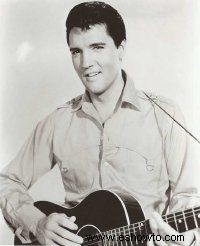
Elvis Presley was not the only pop-rock star to appear in a series of lightweight musicals during the 1960s. Everyone from Frankie Avalon to Herman's Hermits bopped through their own musical vehicles, which were marketed to youthful audiences. Some of these teen musicals featured pop-flavored songs that sounded more like some Hollywood executive's idea of what rock music should be, while others included the music of well-known rock 'n' roll bands of the era.
The most famous teen flicks included the series of beach movies produced by American International Pictures starring Frankie Avalon and Annette Funicello. The first, Beach Party, was released in 1963 and was so successful it launched four others with the same cast -- Muscle Beach Party, Bikini Beach, Beach Blanket Bingo, and How to Stuff a Wild Bikini.
In each film, Funicello played DeeDee, who spent most of the time trying to keep Frankie, played by Avalon, in check. Frankie and Annette's youthful shenanigans were supported by a gang of stock players:dancer Candy Johnson, whose deadly wiggle literally knocked men for a loop; John Ashley, who was often Frankie's rival for DeeDee's affections; and Jody McCrae, a surf bum named Deadhead who had taken one too many spills.
Although their low-budget origins are apparent, the films captured the pleasures of youthful pastimes and the spirit of surfing music, which was so popular during the early 1960s. Several bands known for the "surfin' sound" -- Dick Dale and the Del-Tones, the Hondells, the Pyramids, and the Kingsmen -- made guest appearances in the beach party movies. In addition, such well-known film actors from past generations as Robert Cummings, Buster Keaton, Dorothy Malone, Mickey Rooney, and Keenan Wynn rounded out the casts, lending this series an aura of legitimacy that was lacking in other teen flicks.
When the beach began to look too familiar, the party moved to the ski slopes. A whole new subgenre was born after producer Gene Corman at American International decided to use a ski resort for the setting of Ski Party.
Frankie Avalon courted Deborah Walley this time out, while Dwayne Hickman was paired with Yvonne Craig. Leslie Gore and her pop-flavored songs fit right into the fluffy storyline, but James Brown's highly charged soul numbers burned through the screen when he boogalooed into the scene with his Famous Flames.
Still other musicals made use of a college setting in an effort to keep this youth-oriented genre alive, including Get Yourself a College Girl, with Nancy Sinatra, Mary Ann Mobley, and Chad Everett, and C'mon Let's Live a Little, with Bobby Vee and Jackie DeShannon.
Some of the English rock groups that were part of the British Invasion were also packaged into movie vehicles. Peter Noone and Herman's Hermits made a splash with their feature musical, Hold On, while the Dave Clark Five made a dismal effort titled Having a Wild Weekend. The Beatles' two feature films, A Hard Day's Night and Help!, belong to this musical genre as well, but the creative direction by Richard Lester lifts them above the exploitative level of the typical teen flick.
Most of the movies that starred pop-rock singers were meant strictly for teen audiences, but Elvis' musical comedies were family fare. The casts included children as well as older characters who are accepted as wise representatives of past generations. Despite these differences, Elvis' movies fit quite well into the teen musical genre.
Many of Elvis' costars, for example, were featured in the beach and ski movies, including Shelley Fabares, Nancy Sinatra, Yvonne Craig, Deborah Walley, Joby Baker, Dwayne Hickman, and Mary Ann Mobley. Producers and directors from other teen musicals also worked on Elvis' films. Sam Katzman, the "King of the Quickies," who produced Get Yourself a College Girl, had been in the youth exploitation market since he made some of the first rock 'n' roll vehicles during the 1950s. He was responsible for two of Elvis' films, Kissin' Cousins and Harum Scarum.
The settings and plots of Elvis' films paralleled those of other youth-related musicals. When Spring Break in Fort Lauderdale and other resort areas became a popular subject, as in Where the Boys Are and Palm Springs Weekend, Elvis starred in his own Fort Lauderdale adventure, Girl Happy. When the mod scene in England and Europe was all the rage, Elvis appeared in Double Trouble, featuring the swinging discotheques of London and Amsterdam as a backdrop. The considerable number of beach-related films that Elvis made, including Blue Hawaii, Clambake, and Paradise, Hawaiian Style, was undoubtedly influenced by the popularity of the beach party movies.
Placed within the context of the teen musical, Elvis' movies make perfect sense, even standing out because of their high-quality production values. A critic for Variety praised Elvis' movies for this reason in a review of Easy Come, Easy Go: "Anyone who has seen similar films recognizes the superior quality of Presley's films:the story makes sense; the songs are better and are better motivated; cast and direction are stronger; production values are first-rate."
The teen musical genre, including Elvis' musical vehicles, is a testament to the popularity of that easy-going, pop-rock music of the mid-1960s and to those teen idols who were part of that scene. Never meant to be serious filmmaking, all of these films are best taken as lighthearted Americana.
Although biographers and film critics continue to condemn Elvis' Hollywood career, his films have always been interesting viewing for fans, who know some of the behind-the-scenes anecdotes and tall tales.
While in Hollywood, Elvis developed a reputation for dating his costars while a movie was in production. Rumors about Elvis' relationships with actresses were repeated in fan magazines, gossip columns, and the entertainment press. Much of what was said was obviously manufactured for its publicity value, but some of the rumors were undoubtedly true or came close to being true. To his credit, Colonel Parker usually kept information about Elvis' personal life out of the press.
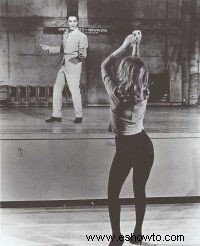
Elvis did not have an exclusive contract with Hal Wallis. He also worked for MGM, United Artists, and Allied Artists. The producers from these other studios followed the musical comedy formula that Wallis had developed, occasionally even improving on it.
Viva Las Vegas, produced by MGM and released in 1964, features Elvis as a race-car driver who takes a job as a waiter at the Flamingo Hotel to earn money to enter the Las Vegas Grand Prix. Ann-Margret plays a swimming instructor who is romanced by Elvis' character and by another dashing race-car driver played by Cesare Danova. The movie was shot in and around Las Vegas, using such locations as the Flamingo and Tropicana hotels and the drag strip at Henderson, Nevada.
The inclusion of Ann-Margret made this Presley travelogue a cut above most. Ann-Margret was known at the time as "the female Elvis Presley" for her sensual, rock 'n' roll dancing style. Fans were excited about the potential screen explosion promised by the pairing of Elvis with his female counterpart, and they weren't disappointed. The musical numbers in Viva Las Vegas are sparked by an electricity not found in other Elvis movies. The on-screen chemistry between Elvis and Ann-Margret reflected their highly publicized off-screen romance.
Of all his relationships with his costars, Elvis' romance with Ann-Margret was probably the most serious. During the production of Viva Las Vegas, Elvis and the redheaded starlet set the publicity mill grinding when they began showing up together at restaurants and clubs around Las Vegas. They shared a mutual love for motorcycles and occasionally rode together, but they were warned to be careful because an accident involving either one of them would have delayed production on the movie.
Other actresses whom Elvis dated during his career in Hollywood included Joan Blackman while working on Kid Galahad, Yvonne Craig while shooting It Happened at the World's Fair, Deborah Walley during the production of Spinout, and Mary Ann Mobley while working on Girl Happy.
Some actresses stand out for not dating Elvis during film production. Donna Douglas, costar of Frankie and Johnny, was a religious and spiritual person who impressed Elvis because she was so well read. He admired her intellect, and he was inspired by her example to read more, particularly books on religion and philosophy. Elvis tried desperately to get costar Shelley Fabares to go out with him during the production of Girl Happy, but she was heavily involved with record producer Lou Adler and later married him. In lieu of a romantic relationship, Elvis and Fabares became friends. She costarred with him in two other movies, Spinout and Clambake. Elvis later claimed that she was his favorite costar.
After a long string of successful movies, Elvis began to make low-budget movies in quick succession, and the practice took a toll on his status as a movie star. See the next section to read about what happened when Elvis' movie career began to falter.
For more fascinating information about Elvis Presley, see:
Elvis Presley's Career Begins to Falter
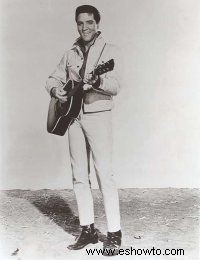
Elvis' musical comedies were relatively inexpensive to produce but always profitable, so Hal Wallis often used them as collateral for financing more prestigious movies. The potential profits from Roustabout were enough of a guarantee for investors to back Wallis's production of Becket, which later won an Academy Award for best adapted screenplay. After Elvis stopped making movies, he complained bitterly that this practice had made him feel used.
Kissin' Cousins was the first of Elvis' low-budget movies. After he made this movie, the shooting schedules for his musical comedies seemed to get shorter, and the budgets seemed to get smaller.
Some people say that Colonel Parker thought Elvis' popularity as a movie star was waning, so he began to seek out producers who could lower production costs. He also looked for resorts and hotels that allowed the cast and crew to stay for free. But there's no proof that the Colonel intended to lower the quality of Elvis' movies. The reverse actually may have been the case, and the decline in production values that went along with lower budgets and shorter schedules may have resulted in a decrease in box-office receipts.
Unfortunately, the music in Elvis' 1960s movies was often not as good as it should have been. Elvis averaged three movies per year between 1960 and 1969, and a soundtrack album was released in conjunction with each movie. After 1964, the Colonel insisted that Elvis record only soundtrack albums. Many of the songs written for Elvis' films were done by hacks who worked for Hill and Range, the publishing house associated with RCA Records. The production values of these albums were erratic.
Typically, the songs for a soundtrack album were recorded in two or three all-night sessions. Neither Colonel Parker nor anyone at RCA or Hill and Range was interested in sinking money into securing good material for Elvis when mediocre soundtrack albums were so easy to produce and sold so well. Since the system worked to everyone's advantage, there was no reason to change it.
The albums and the movies promoted each other. The release of a soundtrack album reminded fans that a movie would soon be appearing in their neighborhood theater, while the movie served as a glorious advertisement for the soundtrack album.
Elvis' control of the pop, country, and rhythm-and-blues charts faded during the 1960s. After 1960, Elvis didn't have a song on the country charts until 1968, and after 1963, he never again placed a record on the R&B charts. Elvis was able to coast on his reputation until about 1965. That year, he had only one Top-Ten single, "Crying in the Chapel," which he had actually recorded in 1960. His soundtrack albums placed in the Top Ten but just barely. In 1966, only one of Elvis' singles, "Love Letters," made it to the Top 20. By 1967, none of Elvis' singles or albums charted anywhere near the Top 20.
Elvis' music may have declined in quality, originality, and popularity during the 1960s, but the decline was not as rapid as many claim, nor was all the music written for his films mediocre. He recorded some good songs during that decade, even if they were for the soundtracks of his movies.
Many of the tunes from Viva Las Vegas are comparable to those from his earlier films. Other excellent songs include the title tune from Follow That Dream, "Return to Sender" from Girls! ¡Muchachas! Girls!, "Rubberneckin'" from Change of Habit, "Wolf Call" from Girl Happy, "Can't Help Falling in Love" from Blue Hawaii, "Little Egypt" from Roustabout, y muchos más. Although there is little hard-driving rock 'n' roll or rhythm-and-blues in these musical numbers, Elvis' mastery of the pop-rock idiom is smooth and confident.
Unfortunately, these well-written songs tend to get lost on soundtracks that feature anywhere from six to fourteen numbers. There is no escaping the fact that Elvis recorded some clunkers during the 1960s. Among the most ridiculous are "(There's) No Room to Rhumba in a Sports Car" from Fun in Acapulco, "Fort Lauderdale Chamber of Commerce" from Girl Happy, "Queenie Wahini's Papaya" from Paradise, Hawaiian Style, "Yoga Is as Yoga Does" from Easy Come, Easy Go, "Barefoot Ballad" from Kissin' Cousins, "He's Your Uncle, Not Your Dad" from Speedway, and "Petunia, the Gardener's Daughter" from Frankie and Johnny.
RCA did not market or package Elvis' albums very wisely. His soundtrack albums were a hodgepodge of songs that lacked unity and consistency, and the Colonel and the people at RCA were determined to saturate the market by releasing material at an extremely rapid rate. It was not unusual for RCA to release a Presley soundtrack while an earlier one was still on the charts, even though standard practice was to get as much mileage as possible from a performer's album before releasing the next.
Most of Elvis' albums and films secured a profit no matter how hastily they were manufactured. The Colonel continually tied him up with three-film contracts with a number of studios, so even when Elvis decided to stop making movies around 1968, he was contractually obligated to star in several more.
Despite the decrease in box-office revenue for Elvis' films at the end of the 1960s, everyone benefited financially from these vehicles. The budgets of Elvis' films were planned so 50 percent of the total budget was allotted for his salary, and he received a percentage of the profits. Parker received 25 percent of Presley's gross income and whatever he could negotiate as technical adviser, while Abe Lastfogel of William Morris received 10 percent off the top of any film deal.
Colonel Parker understood the key to the financial success of the films when he told a scriptwriter that there were a quarter of a million die-hard Elvis Presley fans willing to see each movie three times. The fans believed that Elvis' charisma transcended any mediocre material he was given. When the lines formed outside the box offices, the people in those lines came to see Elvis and nothing else.
Elvis' career may have been faltering due to this string of mediocre movies and soundtracks. After he decided to stop making movies in the late 1960s, Elvis returned to his first love, music, and began to record quality original material. For more on Elvis' career comeback, see the next section.
For more fascinating information about Elvis Presley, see:
Elvis Presley's Career Comeback
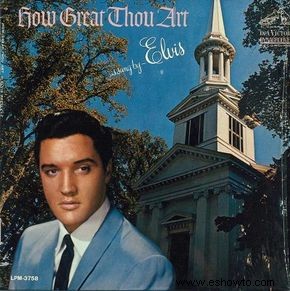
From January 1964 to May 1966, Elvis recorded nothing but movie soundtracks, mostly in Hollywood. Unsatisfied with his life for complex professional and personal reasons, he did not venture into the Nashville studios to cut any album material. When he did finally decide to record new material, he returned to the studio with new musicians and a new producer, Felton Jarvis.
Elvis went to the RCA studios in Nashville in the spring of 1966 to make a gospel album, How Great Thou Art. As a child of the South, he was steeped in gospel music. Memphis was the center of white gospel music during the 1950s, and as a teenager Elvis had frequently attended all-night gospel sings at Ellis Auditorium. Early in his recording career, he developed the lifelong habit of warming up before each session by singing gospel harmonies with the Jordanaires or with his companions.
Elvis loved all gospel music, but he favored the style of four-part harmony sung by male gospel quartets who were associated with the shapenote singing schools of the early 1900s. A quartet usually included first and second tenors, a baritone, and a bass. As a teenager, Elvis' favorite gospel quartets included the Blackwood Brothers, whom he knew personally, and the Statesmen, whose lead singer was the colorful Jake Hess.
The Statesmen were known for their emotional, highly stylized delivery, and Hess had a reputation as a flamboyant dresser. So Elvis was delighted when Hess and his latest quartet, the Imperials, joined him in the studio to record "How Great Thou Art," along with a few secular songs that were released later. Also on board were the Jordanaires and a female backup group.
The arrangements for the gospel numbers consisted of Statesmen and Blackwood Brothers material. For most numbers, Elvis sang as the solo artist while one of the quartets backed him up. A high point of the sessions occurred when Elvis and Hess sang a duet on the Statesmen's famous "If the Lord Wasn't Walking by My Side."
How Great Thou Art proved to be a milestone in Elvis' career, winning him the first of his three Grammys, this one in the Best Sacred Performance category. He won Best Inspirational Performance for He Touched Me in 1972 and again in that category for the song "How Great Thou Art" from the album Elvis Recorded Live on Stage in Memphis in 1974.
Elvis created How Great Thou Art during a time of personal and professional struggle. He had been frustrated creatively by the formulaic movies and their conventional soundtrack music. It is most fitting that Elvis should record a gospel album at a time when he was at a creative and spiritual low. Gospel had inspired his interest in music, it had always calmed his nerves before a session or a performance, and now, as they say in the South, it called him back home.
After years of starring in movie vehicles and mainly recording soundtrack material, Elvis had fallen into a rut, devoid of creativity and vitality. The decision to turn Elvis into a big-screen leading man via a series of musical comedies was arguably a good career move in the early 1960s, but by 1968 the movie formula was clearly a dead end.
In December of that year, the broadcast of his television special, Elvis, turned his career around by introducing him to hipper recording material and new directions. To learn more about how the television special helped put Elvis back on top, see the next section.
For more fascinating information about Elvis Presley, see:
Elvis Presley Back on Top
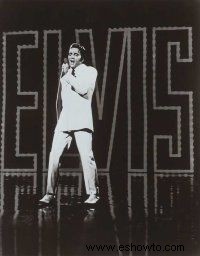
Inspired and invigorated by the success of his television special, Elvis walked through the door of tiny American Sound Studios in Memphis in January 1969 to make quality music that would garner him hit records. Elvis had not recorded in his hometown since he left Sun in 1955, but the musical atmosphere at RCA's Nashville studios had become stale. His friends and associates encouraged him to record at American Sound because Nashville would yield nothing for him at this time.
American Sound Studios, a small studio in a rundown neighborhood, was operated by Chips Moman. With Moman as producer, Elvis worked hard to record his first significant mainstream album in years. In retrospect, From Elvis in Memphis may be his most important album because it brought his recording career back from soundtrack purgatory and set a creative standard for the next few years.
The material Moman brought to Elvis represented all styles of music. Some songs were from the pens of new country songwriters who had been influenced by the innovative music scene of the 1960s. From Mac Davis came a song with socially conscious lyrics called "In the Ghetto," which was light-years away from the benign movie tunes Elvis had been recording. It became a Top Ten hit for Elvis in the spring of 1969. He also recorded Jerry Butler's rhythm-and-blues hit, "Only the Strong Survive."
Elvis recorded 32 songs from a variety of genres, but the 12 cuts on From Elvis in Memphis seem weighted toward modern country music. Elvis' intense version of "Long Black Limousine," about a poor country girl who moves to the big city, turned a sentimental country song into a bitter social comment.
Other passionately sung country tunes on the album include Eddy Arnold's "I'll Hold You in My Heart (Till I Can Hold You in My Arms)" and "After Loving You." Also among the 32 tracks Moman produced at American Sound Studios were the rock-flavored hits "Suspicious Minds" and "Kentucky Rain," which were not included on From Elvis in Memphis. "Suspicious Minds" was included on the follow-up release, From Memphis to Vegas/From Vegas to Memphis.
The house band at American Sound Studios included musicians who were steeped in all forms of Southern music. Both black and white artists recorded there, and the house band remained generally the same. Many of these musicians, including guitarist Reggie Young (who played Scotty Moore's old guitar on "Suspicious Minds"), bassist Tommy Cogbill, and pianist Bobby Wood, had grown up on Elvis' music. No more fitting group of musicians could have backed Elvis on his return to Memphis.
Released in May 1969, From Elvis in Memphis landed on Billboard's Top LPs chart, where it reached No. 13, and the Country LPs chart, where it hit No. 2. The RIAA certified a gold record for the album in January 1970. Most importantly, From Elvis in Memphis helped alter Elvis' image as the crooning movie star.
The year 1969 became a precedent-setting year for Elvis Presley in the way that 1956 and 1960 had been. Just as the events in those years had determined a certain image for Elvis, so did the events of 1969 point Elvis toward a new image and a new sound. His dynamic recordings from the first half of that year helped steer him toward this goal, but his smash engagement in Las Vegas that summer constructed the image that would stay with him for the rest of his career.
After Elvis felt the excitement of singing for a live audience during the performance segment of the comeback TV special, he was excited to return to the concert stage. In early summer of 1969, Elvis was invited to play at the new International Hotel in Las Vegas.
The main room of the hotel had not yet been opened, and Elvis was asked to do the honors. When the Colonel decided that Elvis shouldn't risk making his live comeback on an untested stage, the International Hotel booked Barbra Streisand to open the main room in July. It then scheduled Elvis for August and paid him a half million dollars for four weeks. On the marquee was one word:"ELVIS."
Elvis had not appeared in a live concert since 1961 when his music had been much simpler. In designing his return to live performing, Elvis chose not to re-create his earlier image or sound. Instead, he planned his act on a broad scale.
For his Las Vegas performances, he was joined onstage by pop/gospel quartet the Imperials, female backup singers the Sweet Inspirations, a rock band, and a 35-piece orchestra. The members of his rock band included the well-known Southern blues guitarist James Burton, drummer Ronnie Tutt, bassist Jerry Scheff, keyboard player Larry Muhoberack, and guitarists/vocalists John Wilkinson and Charlie Hodge. (Hodge had been part of the Memphis Mafia ever since he and Elvis had been in the army together.) Part of the reason for such an extensive entourage was doubtless due to the large 2,000-seat room in which Elvis would perform at the International, but the enormous sound created by Elvis and his musical entourage seemed symbolic of Colonel Parker's favorite billing for his boy -- "the World's Greatest Entertainer."
To learn more about Elvis' return to the stage in Las Vegas, see the next section.
For more fascinating information about Elvis Presley, see:
Elvis Presley Returns to the Stage
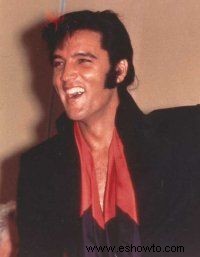
Elvis was terribly nervous about staging his comeback to live performances in Las Vegas, the city where he had bombed when he appeared at the New Frontier Hotel in 1956. The sting of his failure had not diminished with the passing years.
Although he did have time for several rehearsals before his engagement at the International, he had no opportunity to iron out any kinks before a live audience, which added to his anxiety.
Elvis may have been frightened, but Colonel Parker was in his element as he began promoting Elvis all over Las Vegas. He rented every available billboard and took out full-page ads in the local and trade papers. He filled the lobby of the International with Elvis Presley souvenirs:T-shirts, straw boaters, records, and stuffed animals.
The Colonel made sure that Elvis' return to the stage would be the show-business event of the year. Kirk Kerkorian, then owner of the International Hotel, planned to send his own plane to New York in order to fly in the rock press for opening night.
The list of celebrities who planned to attend Elvis' opening included Pat Boone, Fats Domino, Wayne Newton, Dick Clark, Ann-Margret, George Hamilton, Angie Dickinson, and Henry Mancini. Elvis personally invited Sam Phillips, the man who had helped him develop his raw talent into a unique musical style.
On July 31, 1969, Elvis performed in front of a sold-out crowd at the International. To the hard-pounding strains of "Baby, I Don't Care," Elvis walked onstage. There was no emcee to introduce him. He grabbed the microphone, struck a familiar pose from the past, and snapped his leg back and forth.
The crowd jumped from their chairs and gave him a standing ovation before he sang one note. The audience of 2,000 began to whistle, applaud furiously, and pound on the tables. Some people stood on their chairs. When the ovation began to subside, Elvis launched into "Blue Suede Shoes" with such fury that ten years of his movie music melted away.
Elvis looked devastatingly handsome that night. He was dressed in a modified karate suit made especially for him out of black mohair. He was thinner than he had been in his last few films, and his blue-black hair reached down past his collar. Elvis' sideburns were the longest they had been since the 1950s.
Never one to take himself too seriously, Elvis joked with the crowd about the old days and the old songs. At one point, he decided to dedicate his next number to the audience and the staff at the International:"This is the only song I could think of that really expresses my feeling toward the audience," he said in all earnestness, before bursting into "Hound Dog."
Elvis closed his act with "What'd I Say" from Viva Las Vegas, and again the sold-out crowd gave him a standing ovation. Elvis came back for an encore and sang "Can't Help Falling in Love," the song with which he closed every show for the rest of his career.
Backstage after the performance, many celebrities and well-wishers, including Cary Grant, were on hand to congratulate Elvis on his triumphant return to live performing. Priscilla Beaulieu Presley, in her account of her life with Elvis, reveals a touching story about Colonel Parker. At this moment of great personal and professional triumph for his one and only client, the Colonel pushed his way backstage.
Everyone could see that tears were welling up in his eyes. Where was "his boy" he wanted to know. As Elvis emerged from his dressing room, the two men embraced, too overcome with emotion to say anything. There have been many stories about Colonel Tom Parker over the years, many of them illustrating his greed, his mistakes, or his ruthlessness, yet none reveals the complexity of the relationship between Elvis and the Colonel like this one.
Most members of the rock 'n' roll press, of whom many were teenagers when Elvis began his career, felt ecstatic about his return to the stage and expressed their enthusiasm in glowing reviews. Rolling Stone magazine declared Elvis to be "supernatural," while Variety proclaimed him a superstar.
The next day, the Colonel sat down with the general manager of the International to discuss the enormous success of Elvis' performance. The hotel offered Elvis a five-year contract to play two months a year -- February and August -- at a salary of $1 million dollars per year.
In his typical flamboyant style, the Colonel took out a pen and began scribbling specific terms on the red tablecloth. When he finished, he asked the general manager to sign the cloth to close the deal. The "red tablecloth deal" has become a show business legend, although Parker drew criticism for locking Elvis into a long-term contract that didn't take inflation into account.
Six months after his first Las Vegas show, Elvis returned to the International for another month of sold-out performances. During this engagement, Elvis wore a jumpsuit on stage. Bill Belew, who had designed the black leather outfit for the comeback TV special, designed a white jumpsuit for this occasion. The costume was slashed down the front to reveal the chest, fitted closely at the waist, and belled out at the legs, which was the fashion of the day. The costume's high collar was inset with semiprecious jewels, and Elvis wore gold and diamond rings on the fingers of both hands. A macramé karate belt made of gold- and pearl-colored strands accentuated his slender waist.
Dean Martin attended the opening night of Elvis' second Las Vegas engagement. Elvis sang "Everybody Loves Somebody Sometime" as a tribute to Martin, the pop singer he had always admired. Elvis altered his repertoire for this engagement by emphasizing his current recordings and including some contemporary country and rock ballads.
He limited the older material to a few key places during the show, or he covered it in a medley-style arrangement. He was determined not to rest on his laurels so he focused his act on his new material and his new sound, which he had developed with the help of Chips Moman at American Sound Studios.
The success of Elvis' comeback was probably enhanced by the 1950s music revival that began in the late 1960s. Many performers who had helped to develop the rock 'n' roll sound and attitude reaped the benefits of this renewed interest in the roots of rock music. Bill Haley and the Comets, Chuck Berry, and Jerry Lee Lewis were touring once again and attracting large crowds.
Elvis not only benefited from the rock-nostalgia craze but also undoubtedly influenced it. Yet, Elvis carefully kept his material new and varied. He didn't identify himself with the rock 'n' roll revival, and his show was never considered to be an oldies act.
Rejuvenated in his professional career, Elvis had also been experiencing a time of personal growth and change in his private life. In 1967, Elvis had married longtime girlfriend Priscilla Beaulieu. See the next section to learn more about Priscilla Presley, Elvis' wife.
For more fascinating information about Elvis Presley, see:
Priscilla Presley, Elvis Presley's Wife
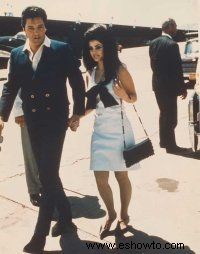
Elvis met Priscilla in 1959 while he was stationed in Germany during his stint in the army. Priscilla was only 14 when the pair was introduced.
Priscilla was photographed by the press at the airport when Elvis left for America, and some of those photos ended up in LIFE revista. Beyond this, there was surprisingly little publicity about their relationship.
After Elvis was discharged from the Army, his only contact with Priscilla Beaulieu was over the phone and by mail. Two months shy of her 15th birthday, the blue-eyed brunette with the turned-up nose remained in Germany when Elvis departed for the United States. Within days there were reports that he was dating Nancy Sinatra.
It was three weeks before Priscilla next heard his voice, reassuring her that she was the only girl for him, and over the next two years she grew accustomed to the rumors and his denials, as well as the pain and frustration that came with loving the world's biggest heartthrob from a distance of several thousand miles.
In a press conference on the day he arrived back at Graceland, Elvis played down his relationship with "the girl he left behind." But in truth, though he was dating Anita Wood and several actresses, he seemed to have reserved a special place in his heart for "Cilla." For the time being, Elvis went along with the Colonel's belief that an all-consuming relationship would hurt his image and be bad for his career. Priscilla patiently waited for their reunion.
During their conversations, Elvis would discuss his career, even his relationship with Anita Wood, causing Priscilla to wonder where she fit in. However, he also insisted that he wanted her to visit Graceland. Cilla just had to hang on. And she did for nearly two years, even amid newspaper and magazine articles linking Elvis to beauties such as Juliet Prowse and Tuesday Weld.
Then, one day in March 1962, after several months without contact, Elvis called Priscilla out of the blue and invited her to join him in Los Angeles. Simultaneously stunned and overjoyed, she pointed out that, although her mother might be receptive to this idea, it would be nearly impossible to persuade her father, Captain Paul Beaulieu. It was a challenge Elvis seemed happy to accept.
While Priscilla prevailed upon her mother, Elvis spoke with the Captain several times and finally won him over by agreeing to a list of rules:the two-week-long vacation wouldn't take place until Priscilla was out of school for the summer; Elvis would send her a first-class round-trip ticket; the Beaulieus would be provided with a comprehensive itinerary of her daily activities in Los Angeles; she would be chaperoned everywhere; she'd write to her parents every day; and at night she'd stay with his friends, George and Shirley Barris. Which is what happened...for the most part.
Priscilla arrived in Los Angeles in June, and following a visit to Elvis' house on Bellagio Road, she did stay at the Barris home -- for one night. The next afternoon, Elvis informed her that he had planned a trip to Las Vegas, and shortly after midnight she was sitting next to him in his luxury motor home on the way to Nevada. She slyly circumvented the problem of her parents receiving letters each day by quickly pre-writing a week's worth and asking Elvis' butler to mail them from Los Angeles. Their next stop was the Sahara Hotel and Casino, where the King and his princess shared a suite.
During twelve blissful, fun-filled days and nights in Las Vegas, Elvis took Priscilla shopping, chose the clothes she should wear, and instructed her on how to style her hair and apply heavier makeup. Elvis liked his women to wear plenty of eyeliner and mascara, and Priscilla readily accepted his choices. Courtesy of a hairdresser at the hotel, her tresses were teased and twisted into a beehive style, her eyes were heavily made up, and the result was the apparent transformation of an innocent teen into a sophisticated siren.
After her return to Germany, Priscilla had something to look forward to during the next six months:Christmas at Graceland. Elvis had invited her, and once again she had to persuade her parents. However, that request was nothing compared to what the Beaulieus were confronted with once the Christmas trip was over and their darling daughter returned home:Elvis wanted her to finish school in Memphis.
Elvis called Captain Beaulieu and used all his powers of persuasion. If Cilla moved to Memphis, he promised, she wouldn't live with him at Graceland but with Vernon and his wife in their house nearby. She would be enrolled in the very best Catholic school, where he'd ensure that she would graduate. And she would be cared for and chaperoned wherever she went.
Not only did Elvis swear that he loved, needed, and respected Priscilla, but he also insisted that he couldn't live without her. The Beaulieus were left with two painful alternatives:let Priscilla go and risk her being devastated if things didn't work out, or veto the proposed plan and be responsible for destroying her happiness. In the end, Elvis got his way, and Priscilla moved to Memphis.
In October 1962, while he was in Hollywood filming Fun in Acapulco, Elvis played host to Priscilla and her dad, and won over the senior Beaulieu with his charm and hospitality. After a few days, father and daughter flew to Memphis, where Captain Beaulieu and Vernon Presley enrolled Priscilla in the all-girl Immaculate Conception Cathedral High School and moved her into the home that Vernon shared with his second wife, Dee.
Once her father had returned to Germany, however, Priscilla seemed uncomfortable living with her future in-laws, and soon she was spending more and more time with Elvis' grandmother at Graceland. Before long, for all intents and purposes she'd basically relocated there.
Vernon chauffeured Priscilla to and from school until she got her license and he agreed to let her drive Elvis' Lincoln Mark V. He also provided her with pocket money to spend on clothes, gas, and going to the movies, bowling alley, and Leonard's Drive-In with cousin Patsy (whose mother was Gladys's sister Clettes, and father was Vernon's brother Vester). Still, despite the company of Grandma Dodger, the maids, and the secretaries, Priscilla often seemed extremely lonely waiting for Elvis to return from filming.
One evening shortly before Christmas 1966, Elvis went down on one knee in the bedroom at Graceland and proposed to Cilla. Then he slipped a ring on her finger. Purchased from jeweler Harry Levitch, the ring featured a 31/2-carat diamond encircled by a row of smaller, detachable diamonds. Just over seven years after her first meeting with Elvis, Priscilla's early fantasies became reality.
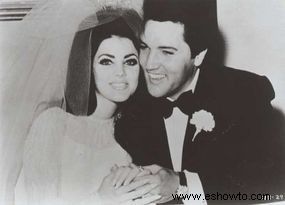
The wedding itself took place on Monday, May 1, 1967. Elvis filmed Clambake in Los Angeles while Colonel Parker made the wedding arrangements. The ceremony took place at the Aladdin Hotel in Las Vegas, in the small second-floor suite of the Colonel's friend, owner Milton Prell. The nuptials were presided over by Nevada Supreme Court Justice David Zenoff and took less than ten minutes. In true Colonel Parker style, a press conference was held immediately afterward, followed by a breakfast reception for 100 guests, including many members of the press.
The newlyweds spent their honeymoon in Palm Springs, and after a couple of days they returned to Memphis where, on May 29, they climbed back into their wedding attire and threw a reception at Graceland for all of their relatives, friends, and employees, as well as a few lucky fans. The only absentee was bodyguard Red West, who refused to attend because he hadn't been invited to the actual wedding ceremony.
Less than two months after the wedding, Elvis began work on Speedway , and on July 12 he made an announcement on the set that Priscilla was pregnant. Yet, it wasn't long before rumors began to swirl that Elvis was having an affair with his costar Nancy Sinatra.
Then, seven months into the pregnancy, he shocked Priscilla by suggesting that they have a trial separation. This idea was quickly dropped, but after their daughter, Lisa Marie, was born on February 1, 1968, the relationship cooled quickly. For a time, Priscilla tried to reignite the marriage, but after Elvis returned to the concert stage in the summer of 1969, his frequent lengthy absences put further strain on the already troubled relationship.
In early 1972, she and Elvis separated, and their divorce was finalized on October 9, 1973. They remained friends, and even held hands during their divorce proceedings.
Though he may have been a less-than-devoted husband, there's no doubt that Elvis was a doting father to Lisa Marie. Until the end of his life Elvis adored Lisa Marie, spoiling her and showering her with jewels and gifts when she visited him, and rarely, if ever, disciplining her.
As in many other aspects of his life, Elvis' love for his daughter ran to excess. Once, he flew her aboard his private jet so she could play in the snow. For her birthday, he rented the amusement park Libertyland for Lisa Marie and her friends. He bought her a golf cart and a pony, which he let her ride through the front door of Graceland.
In her autobiography, Priscilla asserted that she and Elvis retained their mutual affinity and relished their joint role as parents. During one of their last phone conversations, Priscilla mused over the possibility that one day it might be their time once again. "Yeah," Elvis joked, "when I'm seventy and you're sixty. We'll both be so old, we'll look really silly, racing around in golf carts."
After his successful engagements at the International Hotel in Las Vegas, Elvis took his act on the road and toured for much of the next few years. See the next section to learn more about Elvis' life in the 1970s.
For more fascinating information about Elvis Presley, see:
Elvis Presley in the 1970s
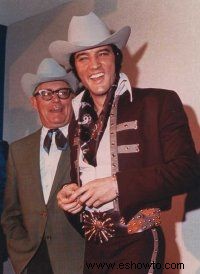
Following his success in Las Vegas, Elvis took his act on tour. For Elvis' first show on the road, Colonel Parker arranged for him to appear in the Houston Astrodome in conjunction with the Texas Livestock Show.
The logic behind choosing such a large arena was simple:Elvis, "the World's Greatest Entertainer," should appear only in magnificent coliseums or showplaces.
Besides, Texas had always been good to Elvis. In 1955, East Texas had been the scene of a great surge of Elvis-mania, which helped boost his early career. To return this kindness and perhaps to ensure a sellout, tickets for Elvis' engagement at the Astrodome were greatly reduced in price, with some seats selling for as little as one dollar.
Despite his boost in confidence from the Las Vegas victories, Elvis was overwhelmed by the size of the Astrodome and the thought of having to please 44,500 people. Referring to the Astrodome as an "ocean," he worried about losing some of his energy and dynamism in such a vast arena.
Again his fears proved unfounded because the Astrodome sold out each night of his engagement, and the local music critics raved about his personal charisma and his exciting act. For the first time since the 1950s, Elvis was swarmed after his show in a frightening example of mob hysteria. His limousine had been parked by the stage door so he could make a rapid getaway, but the fans were able to reach the car quickly. They surrounded the vehicle; some tried to shove flowers and gifts into the doors and windows while others just wanted to touch their idol.
After winning Houston, Elvis continued to tour. He was usually on the road for several weeks out of a month, in addition to playing Las Vegas in February and August. His touring schedule was grueling. By 1971, Elvis was on the road more than most other acts in show business.
Elvis would tour for three weeks at a time, taking no days off and doing two shows on Saturday and Sunday. He would rest for a few weeks and then repeat the cycle. Elvis usually played one-night stands, meaning every performance was scheduled for a different arena. Often Elvis and his entourage would arrive in a city and depart again in less than 24 hours.
Such a demanding schedule took its toll in terms of Elvis' desire to update or change the material in his act. Eventually, his performances became standardized, even routine. Despite this, Elvis' concerts were almost always sold out.
During the final Houston show, Elvis experienced problems with his eyes. Upon returning to Memphis, he checked into Baptist Memorial Hospital where he was diagnosed with glaucoma, a serious eye disease that can eventually result in blindness.
Elvis became consumed with an irrational fear that he would be blind by the end of the year. He grew morose, irritable, and reclusive. It took six months for his doctor, his family, and his friends to convince him that his case was treatable. His overreaction to his ailment seemed partly a result of the fatigue and nervousness associated with a demanding schedule.
Touring and performing in Las Vegas became the basis of Elvis' career during the 1970s. These engagements of 57 or 58 shows generally lasted about one month, a schedule equally as exhausting as being on the road. Plus, the pressure of performing live was as draining as the physical nature of the performances, resulting in sleeplessness, bouts of depression, and exaggerated emotional responses.
Little of this showed in his performances during the early 1970s, and those who saw him on stage marveled at the excitement he generated in his audiences. Indicative of his stage show during this time period is the Elvis:Aloha From Hawaii concert, which was not only televised but also recorded and released on an album titled Aloha From Hawaii via Satellite. The album hit the top spot on Billboard's album chart, remaining on the charts for 52 weeks. It was Elvis' last album to reach No. 1.
To learn more about Aloha From Hawaii, see the next section.
For more fascinating information about Elvis Presley, see:
Elvis:Aloha From Hawaii
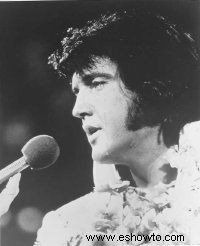
Taking advantage of advances in global communications, Elvis:Aloha From Hawaii was beamed by the Intelsat IV satellite to countries all over the world on January 14, 1973. Broadcast at 12:30 a.m. Hawaii time, the special was seen in Australia, New Zealand, the Philippine Islands, Japan, and other countries in the Far East. Even parts of Communist China supposedly tuned in. The next day, the show was rebroadcast to 28 European countries.
The special consisted of a concert performance by Elvis in front of a live audience at the Honolulu International Center Arena. After the audience left the arena, Elvis was filmed singing five more songs, which were to be included in the U.S. edition of the concert.
However, NBC's broadcast of the show on April 4 included only four of the additional songs. The American broadcast of the special was watched by 51 percent of the television viewing audience, more than the number of people who watched the first walk on the moon. When it finished airing around the world, Elvis:Aloha From Hawaii was seen in 40 countries by at least 1 billion people.
On January 12, Elvis did a full dress rehearsal that was not televised. After seeing a tape of this performance, he decided he needed a haircut. The difference in hairstyles provides a way for the Elvis fan to distinguish between photos of the rehearsal and photos of the special. Both shows were a benefit for the Kuiokalani Lee Cancer Fund and raised about $75,000. Lee was a Hawaiian composer who had died of cancer, and Elvis performed Lee's song, "I'll Remember You," in his honor.
Elvis sang a variety of songs throughout the concert special, including his current hits, "Burning Love" and "Suspicious Minds," and past hits "Hound Dog," "Love Me," and "A Big Hunk o' Love." He also sang "My Way," "Steamroller Blues," and other pop and rock tunes, as well as the moving country classic "I'm So Lonesome I Could Cry." During the course of the evening, he doffed his magnificent cape, and later, while singing "An American Trilogy," Elvis tossed his studded belt into the audience.
"A live concert to me is exciting because of all the electricity that is generated in the crowd and on stage. It's my favorite part of the business -- live concerts," Elvis proclaimed at a press conference prior to Aloha From Hawaii.
For the finale, Elvis sang his standard closing number, "Can't Help Falling in Love," that built up to the large-scale sound typical of his style of that era. By the time this number began, Elvis had resumed wearing his cape, which typically signaled the end of the show for his band and the audience.
Usually, he concluded the number by dropping to one knee in the spotlight, grabbing the ends of his cape in his hands, and spreading the garment out behind him -- a grandiose gesture befitting the World's Greatest Entertainer. On this night, he added an extra touch by throwing the gem-laden cape into the crowd, where it was caught by a lucky fan. As the orchestra reprised "See See Rider," Elvis left the stage. As usual, he did not return for an encore. It was simply too hard to top the effect of such sublime imagery.
Aloha From Hawaii featured many of the elements -- such as the jumpsuit and energetic performance style -- that were hallmarks of Elvis' concerts in the 1970s. To learn more about Elvis' particular brand of entertainment, see the next page.
For more fascinating information about Elvis Presley, see:
The King
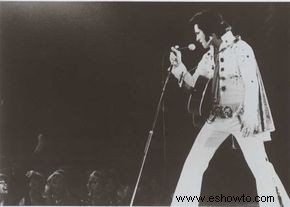
A typical Presley concert of the 1970s was more like a series of rituals and ceremonies than a performance by a mere entertainer. Elvis made his grand entrance to Richard Strauss's Also sprach Zarathustra, popularly known as the "Theme from 2001," charging into the spotlight as though propelled by some supernatural force. He incorporated karate kicks and tai chi arabesques into his act as well as other dramatic postures.
Elvis also mocked his 1950s sex-symbol image by exaggerating the pelvic thrusts and sexual posturings of his old performing style, while making jokes about the "old days." A peculiar part of his act was wiping the sweat from his brow with his scarf or a towel then throwing it into the audience. This gesture became so popular that dozens of white towels were kept in the wings for Elvis to throw to fans at frequent intervals.
Although Elvis' enormous popularity forced him to live a remote life secluded from the public, his act onstage gave the illusion of intimacy. His rapport with his audiences was based on treating them like old friends or an extended family.
Much interaction occurred between Elvis and the audience members, such as the exchange of "gifts." Elvis threw towels and flowers into the audience; fans returned the gesture by throwing underwear, hotel keys, teddy bears, bouquets, and other mementos.
In fact, each time Elvis played Las Vegas, the hotel stocked fresh undergarments in the restrooms because of the women tossing their underwear onto the stage while he was performing. Elvis kissed, hugged, and held hands with many of the women in the audience. They lined up just below the stage, like a receiving line for royalty, waiting to be blessed by the King's touch. Audience members expected Elvis to sing specific songs and perform familiar moves, and he always fulfilled their expectations.
This type of interaction can be traced back to Elvis' early career, when audiences became hysterical at his gyrations and performing style. Even then, Elvis exhibited an uncanny instinct for knowing what the fans wanted to see and hear. He teased them with a few hip and leg movements, they responded, and then he cut loose, singling out specific members of the audience to interact with. This phenomenon was reciprocal in nature, forming a strong bond between performer and audience. If Elvis' fans were unusually loyal and demonstrative throughout his career, this interactive aspect of his act -- from the beginning of his career to the end -- was partially responsible.
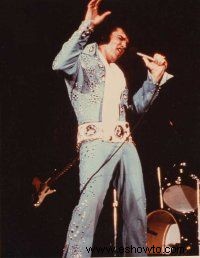
If there is one symbol that has come to represent this period of Elvis' career, it is the bejeweled jumpsuit. As Elvis launched each new tour or Las Vegas appearance, his jumpsuits became more elaborate. Sometimes accompanied by a waist-length or floor-length cape, these costumes were decorated with real gems, jewels, and semiprecious stones. With the addition of chains and studs, the outfits could weigh as much as 30 pounds.
Later costumes were emblazoned with certain symbols that held some significance to Elvis, including eagles, karate emblems, tigers, or sundials. Fans refer to these costumes by name, such as the Mexican Sundial, the King of Spades, the Rainbow Swirl, the American Eagle, the Red Flower, the Gypsy, and the Dragon. They can identify specific tours and appearances by the costumes Elvis wore.
Elvis' repertoire of songs varied after the early 1970s, but his style of music and the format of his act did not change. Fans like to find parallels between Elvis' personal life and the songs he chose to sing at certain points in his career. Around 1972, when Elvis and Priscilla were experiencing marital problems, he included "Always on My Mind" and "You Gave Me a Mountain," two songs about the trials and tribulations of life and love.
The following year, Elvis included "My Way" in his act. Paul Anka wrote this powerful song's lyrics, which are about a man reflecting back on his life as death draws near, with Frank Sinatra in mind. Yet, the song became a personal anthem for Elvis, one that seemed to explain his eccentric lifestyle and larger-than-life image. However, a single of this song by Elvis was not released until June 1977.
In 1971, country songwriter Mickey Newbury put together a unique arrangement of three 19th-century songs that he recorded and released as "An American Trilogy." Elvis heard the record and immediately incorporated the medley into his act. This piece has become so associated with Elvis Presley that it is difficult to imagine anyone else performing it with the same showstopping fervor that Elvis put into it. A combination of "Dixie," "The Battle Hymn of the Republic," and the spiritual "All My Trials," the songs reflect Elvis' patriotism, his religious convictions, and his deep affection for his native South.
A Vegas-style comedian always opened Elvis' concerts, even when he was on the road. Rock music aficionados were appalled by the old-fashioned routines and stale jokes of these stand-up comics, particularly because this era saw the rise of a new, more hip generation of comedians with socially relevant material.
But, even when he was on the cutting edge of rock 'n' roll in 1956 and 1957, Elvis always toured with an oddball assortment of vaudeville-flavored acts dug up by the Colonel. Therefore, it seems only natural that the Colonel would hire this type of opening act when Elvis returned to live performances in the 1970s. Elvis and the Colonel were accustomed to this kind of show business act, and the humor went over well in Vegas. Sammy Shore opened for Elvis in the early 1970s, and Jackie Kahane did the honors after 1972.
Kahane's responsibilities included announcing, "Ladies and gentlemen, Elvis has left the building," at the end of each performance. Elvis rarely performed an encore, although many times the audience remained behind after the final number, hoping Elvis would respond to the thunderous applause and return for one last song. To avoid any problems with overzealous fans, Elvis always ran backstage immediately after the last song, often while the band was still playing, and dashed into a car waiting at the stage door. Kahane's announcement let the audience know it was truly time to leave.
Despite the predictability of Elvis' live performances during the 1970s, there were still many highlights. On June 9-11, 1972, Elvis played Madison Square Garden in New York City. This was the first time he'd ever performed live in New York. All four shows sold out well in advance. A total of 80,000 people attended, including David Bowie, Bob Dylan, George Harrison, and John Lennon.
However, Elvis and his management team feared that the sophisticated New York critics wouldn't like his Las Vegas-style show. On opening night, Elvis was decked out in one of his bejeweled jumpsuits and a gold-lined cape. He wore a gigantic belt emblazoned with "The World Champion Entertainer," in case the critics didn't know who they were dealing with.
Throughout the show, particularly while singing his old songs, Elvis maintained an ironic distance from his audience. Sometimes he couldn't resist joking about his former image. At the beginning of "Hound Dog," for example, Elvis dropped dramatically down to one knee, and then said, "Oh, excuse me," and switched to the other knee.
During the New York engagement, Elvis appeared to be in top physical condition. His voice was strong and clear, and he sang a variety of old and new songs with drama and flair. Most of the New York critics were enthusiastic. RCA recorded all four shows at the Garden for an album titled Elvis as Recorded at Madison Square Garden. They mixed the songs, pressed the records, and had the albums in stores in less than two weeks.
In addition to concert recordings, two documentaries -- Elvis on Tour and Elvis:That's the Way It Is -- followed the action as the entertainer toured. See the next section to learn more about these documentaries about the King.
For more fascinating information about Elvis Presley, see:
Elvis Presley's Concert Documentaries
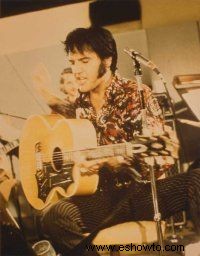
MGM produced two film documentaries, Elvis -- That's the Way It Is and Elvis on Tour, that captured Elvis' live performances. Elvis -- That's the Way It Is, a feature-length movie, is built around Elvis' August 1970 engagement at the International Hotel in Las Vegas.
About half of the movie features his performance onstage in the main room. One segment in which Elvis sings "Mystery Train" and "Tiger Man" was filmed at a concert in Phoenix. The rest of the movie documents the excitement Elvis generated as a performer. Elvis is shown in rehearsal for the show, whipping his band into shape and mastering new material for the act.
Intercut with the rehearsal footage are shots of the massive promotional buildup in Las Vegas. They also sent a film crew to Luxembourg to record an Elvis Presley convention.
Elvis -- That's the Way It Is was directed by Denis Sanders, who had won an Oscar for Best Documentary for his film, Czechoslovakia 1968. Expert cinematographer Lucien Ballard caught the excitement of Elvis' performance onstage with eight Panavision cameras.
The film was released on November 11, 1970, to good reviews. The Hollywood Reporter remarked that Elvis was probably the only entertainer alive who could draw enough people into a theater to make a documentary profitable at the box office. The film also introduced Elvis as a live performer to an audience who was too young to remember him from the 1950s and knew Elvis only from his movies.
In 1972, MGM released another feature-length documentary about Elvis, which was shot in the spring of that year. Elvis on Tour focuses on his road show during a 15-city tour. This film captures the final phase of Elvis' career at its highest point. It was produced by Pierre Adidge and Robert Abel, who had won critical acclaim for their rock documentary Joe Cocker:Mad Dogs and Englishmen.
Some of the editing was supervised by Martin Scorsese, who also worked on the editing of Woodstock. Andrew Solt is credited with doing research on Elvis on Tour. He later coproduced the semidocumentary This Is Elvis as well as Imagine, a film about John Lennon. Elvis on Tour won a Golden Globe for the Best Documentary of 1972; it is the only Elvis Presley movie to be honored with an award of any kind.
Elvis' return to concert performing probably contributed to the disintegration of his marriage to Priscilla. Gone from Graceland much of the time while touring, Elvis saw less of Priscilla and his daughter, Lisa Marie, as his career and lifestyle took a different direction. The horrendous pace of performing in a different city every night made traveling together difficult, and Elvis enforced a "no-wives" rule while on the road, which applied to himself and all members of the Memphis Mafia.
Priscilla left Elvis in early 1972, and Elvis sued for divorce the following August. Elvis' lawyer succinctly summed up the problem when he released this statement:"Elvis has been spending six months a year on the road, which put a tremendous strain on the marriage." In October 1973, the couple officially divorced, but it was an amicable split. They held hands during the divorce proceedings and walked out of the courtroom arm in arm.
The years 1969 through 1973 were an incredibly creative time for Elvis. He returned to performing live and developed a new sound and a new image that completely replaced the singing-movie-star image that he believed never really matched his talents. Dressed in gold and jewels, this Elvis Presley lived up to the titles "World's Greatest Entertainer" and "The King of Rock 'n' Roll."
By the mid-1970s, the constant touring began to wear on Elvis. To read more about Elvis Presley's physical and mental decline, see the next section.
For more fascinating information about Elvis Presley, see:
Elvis Presley's Physical and Mental Decline
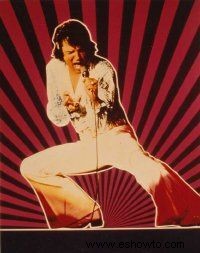
The nonstop touring and Las Vegas engagements played a part in Elvis Presley's physical and spiritual decline as did his dependency on a variety of prescription drugs.
His oppressive performance schedule and his reliance on drugs were connected, at least in Elvis' mind. He claimed he needed drugs to maintain his energy onstage and then drugs to sleep after his performances, but some of the prescription drugs he got his hands on were not designed for those purposes. Some time during the 1970s, Elvis' overuse of drugs evolved into a frightening level of abuse.
In addition, Elvis' record output during the 1970s was extensive, making his recording schedule as grueling as his concert tours. Each year, RCA typically released three to four studio albums, one to two live albums, and various singles.
A misconception exists that Elvis was lazy during the 1970s, that he secluded himself inside Graceland for extensive periods and did very little. Yet, based on his touring and recording schedules, this is clearly untrue. The problem was not inactivity; it was a grinding schedule of repeated routines, the monotony of the road, and a heart heavy from personal disappointments.
Personally downhearted and professionally unchallenged, Elvis grew bored and disaffected. By 1976, no one could get Elvis Presley into the recording studio despite his contractual obligations. Any enthusiasm he had previously mustered for recording was lost by the mid-1970s. Whether it was the end result of a downward spiral or because he thought the drugs had affected the range of his voice is unknown.
To appease Elvis by making the recording process easier, RCA sent their recording truck to Graceland in February 1976 so the reluctant singer could work in the convenience of his own home. Technicians set up a makeshift studio in the downstairs back room known as the Jungle Room because of its decor. They made some technical compromises but, from this session and another session in October 1976, they produced two albums:From Elvis Presley Boulevard, Memphis, Tennessee and Moody Blue. The October session, resulting in only four completed tracks, was Elvis' last effort at studio recording.
Moody Blue, released in July 1977, consists of leftover tracks recorded at Graceland in 1976, three live songs from concert performances in April 1977, and one previously released cut titled "Let Me Be There." Critics and biographers have overlooked or criticized the album because it is a hodgepodge of tracks representing producer Felton Jarvis's desperate attempts to put together an album on schedule for RCA. While it is not a musical milestone by any standard, Moody Blue does tell us something about Elvis Presley and for that reason it deserves consideration and evaluation.
The selection of songs indicates the eclectic nature of Elvis' tastes, while his ability to put them over with a consistency reveals his style. From the country classic "He'll Have to Go" to the pop song "It's Easy for You" by Andrew Lloyd Webber and Tim Rice, Elvis unites disparate sounds and genres of music into a style that is big, dramatic, and unique to him.
If there was one common denominator to his song selection during the last couple years of his life, it was his affinity for brooding ballads or other songs of regret and loss. Several songs of this type had been recorded around the time of his separation and divorce from Priscilla, but this preference resurfaced as his personal and professional life continued to deteriorate.
If speculation exists as to whether Elvis realized the extent of his decline, the proof of self-awareness lies not in his words or deeds but in the song selections for his final studio albums. "He'll Have to Go," "She Thinks I Still Care," and the title cut "Moody Blue" from this LP are about lost love affairs, bitter endings, and hopeless relationships. These tracks are not great musical innovations, nor did they change the course of music history, but their autobiographical relevance to Elvis' circumstances make their inclusion on this album -- released one month before his death -- poignant and heartrending.
Moody Blue reached No. 3 on Billboard's Top LP chart and remained on the charts for 31 weeks. It was certified platinum on September 1, 1977. The original pressing of Moody Blue produced 200,000 copies on blue translucent vinyl. Green, red, and gold vinyl were experimented with but quickly discarded for the blue -- an obvious choice considering the album's title. After the initial pressing sold out, RCA chose the customary black vinyl for the next run, but later they returned to blue. Fans referred to this album as the "Blue Album," which seemed appropriate not only for its color but also for Elvis' frame of mind.
The reasons, sources, and explanations for Elvis Presley's problems, maladies, and behavior have been discussed, dismissed, interpreted, and exaggerated for decades, often by those who have their own agendas and personal motivations. While separating the reasonable explanations from the angry accusations can be difficult, a common thread among them is Elvis' isolation from the outside world, which resulted in an unconventional lifestyle.
When Elvis began his career, he allowed his fans unprecedented access to himself and his family. Fans tracked him down and visited him in the comfort of his home. As time passed, the fans became too much for him to manage. He was mobbed, pushed down, and sometimes stripped bare by crowds of adoring admirers.
Elvis couldn't sightsee, eat in a restaurant, or enjoy himself in public without his fans besieging him. By the time Elvis was discharged from the army, he had begun living as a recluse. He secluded himself at Graceland or his home in California. This isolation, coupled with his boredom when he was between projects, eventually led Elvis to indulge in destructive habits.
These bad habits accelerated during the 1970s after he returned to performing in concert and a hectic life on the road. His worst problem was obviously his dependence on prescription drugs, which altered his behavior and personality. According to members of the Memphis Mafia, a group of his bodyguards and friends, Elvis began using amphetamines and diet pills in the 1960s; the drugs were intended to help Elvis keep his weight down.
To counteract the amphetamines, Elvis and his court, who always indulged in whatever Elvis was doing, began to take sleeping pills. By the early 1970s, when he was touring on a debilitating schedule of one-nighters, Elvis was taking medication for pain and discomfort caused by various afflictions and conditions. These drugs eventually left him in a state of mental limbo. Memphis Mafia members disagree about how many drugs Elvis took, but the fact remains that he took more drugs than his body could withstand.
Elvis' drug problem was the result of prescription drugs, some of which were administered for health problems. He had back pain, digestive troubles, and eye afflictions, including glaucoma. Treatments for these conditions put Elvis in the hospital several times between 1973 and his death four years later. He was also hospitalized for throat ailments, pleurisy, and hypertension. Ironically, Elvis rarely indulged in alcohol and often spoke out against taking illegal drugs.
Because of his wealth and position, Elvis' eating habits and choice of foods have been exaggerated and blamed for his weight gain. Some writers reported that the amount of food Elvis consumed was excessive. They told tall tales about Elvis eating so many Spanish omelettes that he created an egg shortage in Tennessee. Elvis did sometimes go on eating binges, usually during his time off between projects. However, the stories about his binges on foods such as bacon, ice cream, and pizza have been repeated so often they infer that Elvis ate this much every day.
Most of Elvis' favorite foods were typical Southern dishes that incorporate a variety of fried meats. Reporters and magazine writers who were not familiar with Southern cooking thought that Elvis' eating habits were peculiar, although many people in the South enjoy the same foods Elvis liked to eat.
As early as 1955, when he was 20 and considered an up-and-coming country-western singer, articles about the young singer often mentioned that he liked to down several cheeseburgers at one sitting. In the late 1960s, an article in Esquire magazine took a sarcastic but lighthearted tone when describing Elvis' favorite snack of peanut butter and mashed banana sandwiches washed down with plenty of Pepsi. Elvis always had these eating habits, and age and lack of exercise had as much to do with his weight gain as anything else.
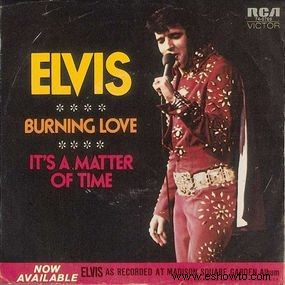
Not all of Elvis' excesses were bad for his health. He also liked to collect and wear ostentatious jewelry, which is perhaps an extravagance more befitting the King. During the 1970s, Elvis wore rings on all his fingers, both onstage and off. He also wore heavy medallions, gold-plated belts, and chain-link bracelets. On a gold chain around his neck, Elvis wore a gold Star of David as well as a crucifix.
He also liked to carry walking sticks adorned with tops of silver or gold. Elvis bought expensive jewelry not only for himself but also for the Memphis Mafia, their wives, and his show business friends. He once gave a $30,000 ring to entertainer Sammy Davis, Jr.
Among Elvis' extravagant habits were his buying sprees, particularly of cars, motorcycles, and other vehicles. Elvis had a lifelong love affair with Cadillacs and bought more than 100 during his lifetime, mostly for himself but also for the members of his entourage. If he bought himself a new car, he tended to buy one for the friend or family member who was with him at the time.
Later in his life, he was known to buy cars for other customers who were on the car lot at the same time. Sometimes he purchased vehicles to smooth over the ruffled feathers of members of the Memphis Mafia, who tended to feel slighted at the drop of a hat, like kids fighting on a playground.
Elvis Presley also collected guns. He owned thousands of dollars worth of guns, and he lavished gifts of expensive guns on the Memphis Mafia. During the 1970s, he carried a gun on him much of the time, partly because he had received several death and kidnapping threats. He believed that assassins sought glory or media attention when they attempted to kill a famous person and that he was as likely a target as a president. Elvis carried guns onstage when he performed, during trips in airplanes, and while in his hotel rooms.
Perhaps more than his guns, Elvis was proud of his police badge collection. He was fascinated with law enforcement and collected badges from across the country. The prize of the collection was a federal narcotics badge and a complete set of credentials. He wheedled these out of President Richard Nixon on a spontaneous visit in December 1970. Elvis initiated the meeting by writing a six-page letter to Nixon while on the plane en route to Washington, D.C. The many times that he packed a gun onstage and the many stories about his infatuation with law enforcement reveal a life lived beyond the constraints of the norm.
A life of isolation from the outside world combined with the privileges of stardom eventually led Elvis to self-destruct. He maintained a secluded existence inside the walls of Graceland, where there was no one with enough influence to stop the indulgences of the King.
Still, Elvis' dark habits and self-destructive whims are often exaggerated to such a degree that only a fantasy figure could have indulged in proportions of this magnitude. Perhaps normal standards of measurement are simply not adequate when describing the excesses and achievements of Elvis Presley. For all the heartbreaking details that have been revealed since his death, the one part of the legend that remains untarnished is his voice, which rang clear and true from the day he recorded "That's All Right" until June 26, 1977, the day he gave his final performance at Market Square Arena in Indianapolis.
After his final concert performance, Elvis Presley continued to decline over the next few weeks at Graceland. He died on August 16, 1977 under questionable circumstances. See the next section to learn more about the death of Elvis Presley.
For more fascinating information about Elvis Presley, see:
The Death of Elvis Presley
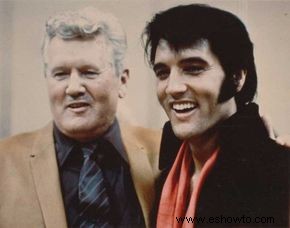
Elvis Presley died at Graceland on August 16, 1977. He was 42 years old. Girlfriend Ginger Alden found him slumped over in the bathroom. Paramedics were called, but they failed to revive Elvis, and he was taken to Baptist Memorial Hospital where further attempts to resuscitate him failed. He was pronounced dead by his physician, Dr. George Nichopolous, who listed the official cause of death as erratic heartbeat, or cardiac arrhythmia.
Almost immediately, rumors that Elvis was dead began to sift into the Memphis newspaper, radio, and television newsrooms, but reporters took a wait-and-see attitude. They had heard these rumors before.
Over the years, many crank calls had come in declaring that Elvis had been killed in a car accident or a plane crash or that he'd been shot by the jealous boyfriend of a woman who was hopelessly infatuated with him. Once, someone reported that he had drowned in a submarine.
Elvis Presley was a hometown boy and a constant source of news, some of which was manufactured for or by the Memphis press. Newspaper editors and newsroom managers were cautious about sending out their reporters if the rumor that Elvis was dead was just another hoax. But when the staff of the Memphis Press-Scimitar learned from a trusted source that Elvis actually was dead, the newsroom became unusually silent. Dan Sears of radio station WMPS in Memphis made the first official announcement, and WHBQ-TV was the first television station to interrupt its programming with the terrible news.
As the news of Elvis' death spread across the country, radio stations immediately began to play his records. Some stations quickly organized tributes to Elvis while others simply played his music at the request of listeners, many of whom were in a state of shock over his sudden death. Some people called their favorite radio stations just because they wanted to tell someone their stories about the first time they'd heard Elvis sing or to talk about how much his talent and his music meant to them.
In the same way that many people remember exactly where they were when they heard President John F. Kennedy had been killed, most of Elvis' fans remember where they were the day Elvis died. Mick Fleetwood, of rock group Fleetwood Mac, recalls, "The news came over like a ton of bricks. I was driving back from the mountains, and I had the radio on. They were playing an Elvis medley, and I thought, 'Great.' And then they came back with the news."
The manner in which the major television networks handled the news of Elvis' death illustrated his enormous popularity and the tremendous impact he had on America, something few realized until he was gone. Data from the television-ratings service Arbitron revealed that on the day Elvis died, there was a huge increase in the number of televisions tuned to evening news programs.
The staffs of television newsrooms considered Elvis' death a late-breaking story. There was not enough time for TV reporters who had been sent to Memphis to file stories for the evening news. Executives had to decide quickly what film footage they could use from their files and where to place the story in relation to the other news of the day.
NBC-TV not only rewrote their news lineup to lead off with the story of Elvis' death, but the network also made immediate plans to delay The Tonight Show and put together a late-night news documentary. David Brinkley, a national news anchor for NBC at the time, opened his broadcast with three minutes devoted to Elvis' sudden death. ABC-TV also decided to lead with the Presley story. When they learned that NBC would be doing a late-night news special about the significance of Elvis Presley to American music, ABC announced that they would also air a half-hour documentary.
CBS did not follow suit, however. The CBS Evening News with Walter Cronkite, featuring the most respected man in broadcasting at that time, had led the news program ratings for more than a decade. CBS executives chose not to open the evening broadcast with the Presley story. Arbitron's records indicate that when millions of viewers realized this they immediately switched the channel to another network.
The CBS decision not to lead with Elvis' death gave the CBS Evening News its lowest ratings in years. (For the record, Roger Mudd was substituting for Walter Cronkite that evening.) CBS devoted only 70 seconds to its story on Elvis, placing it after a lengthy segment on the Panama Canal. The producer for that evening's news was vehemently opposed to leading off with Elvis' death, in spite of other members of the CBS programming staff suggesting it repeatedly. Interviewed later, the producer agreed that he was out of sync with the national consciousness. Two days later, CBS tried to save face by putting together a documentary on Elvis.
Even though Elvis never performed in Europe, countries from all over the world sent reporters to Memphis. The press coverage in foreign newspapers and on European television was almost as extensive as the reporting in the United States. Everywhere in the world, people lamented the loss of an irreplaceable entertainer.
Within one hour after Elvis' death, fans began to gather in front of Graceland. By the next day, when the gates were opened for mourners to view Elvis' body, the crowd was estimated at 20,000. When the gates closed at 6:30 p.m., about 80,000 fans had passed by Elvis' coffin. Many had come from different parts of the country; many from different parts of the world.
Eventually, so many mourners arrived that it was impossible for them all to be admitted to Graceland, even with extended calling hours. Law enforcement officials were afraid there might be problems with crowd control, but there were none. However, an unrelated tragic incident occurred:A drunk driver's car careened into three teenagers in the crowd, killing two of them.
As the group of mourners grew around the gates of Graceland, a carnival atmosphere developed; people hawking T-shirts and other souvenirs began to work the crowd. The people who were unable to get into Graceland to pay their last respects to Elvis consoled each other by exchanging anecdotes about their idol. When reporters asked them why they were there, people inevitably gave the same reply:They didn't really know, but they felt they wanted to be where he was this one last time. The hot Memphis weather and the close crush of the crowd caused many people to pass out. A medic was stationed nearby to assist anyone who fainted, but no one left because of the heat.
Elvis' fans sent a tremendous array of flowers, which were set out along the bank in front of the house. Every blossom in Memphis had been sold by the afternoon of August 17, and additional flowers were shipped in from other parts of the country. It was the biggest day in the history of FTD, a florists' delivery service. FTD employees claim that more than 2,150 arrangements were delivered. The arrangements were shaped like lightning bolts, guitars, hound dogs, and stars, as well as more traditional wreaths and bouquets. Many of the arrangements were sent immediately to Forest Hill Cemetery, the site of the burial. After the funeral, Vernon Presley allowed the fans to take away the flowers as mementos.
Numerous celebrities attended Elvis' funeral, including Caroline Kennedy, country music guitarist Chet Atkins, performers Ann-Margret and George Hamilton, and television evangelist Rex Humbard, who was one of the speakers during the service. Comedian Jackie Kahane, who had opened many of Elvis' concert performances, delivered his eulogy, and a local minister also spoke.
Gospel performers sang, including Jake Hess, J.D. Sumner, James Blackwood, and their vocal groups, as well as singer Kathy Westmoreland. The casket was carried to Forest Hill Cemetery in a long motor cortege of all-white automobiles.
Later, when someone threatened to steal Elvis' remains, his casket was moved to the Meditation Garden behind Graceland. Gladys's body was also moved to the Meditation Garden in 1977; Vernon Presley died and was buried there in 1979; and Minnie Mae Presley was laid to rest beside the rest of her family in 1980.
Elvis' sudden and shocking death left many unanswered questions, and fanned the flames of controversy. See the next section to learn more about the controversy surrounding the death of Elvis.
For more fascinating information about Elvis Presley, see:
The Controversy Over Elvis Presley's Death
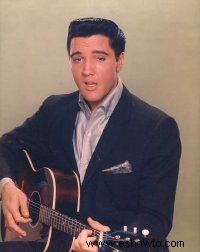
In a strange stroke of timing, on August 1, 1977, 15 days before Elvis died, Ballantine Books published a book, Elvis:What Happened?, put together by Steve Dunleavy. It consisted of interviews with three of Elvis' former bodyguards:Red West, Sonny West, and Dave Hebler.
The men were the first to come forward with stories of Elvis' bizarre lifestyle. The book gave accounts of his mood swings, his relationships with women, and his excessive use of prescription drugs. It received almost no publicity until journalist Bob Greene, a columnist for the Chicago Sun-Times, interviewed Sonny West. By coincidence, the article happened to run on the day Elvis died.
Greene's column provoked a great deal of protest from fans across the country and inspired the wrath of several journalists, including Geraldo Rivera, who blasted Dunleavy on Good Morning America for smearing Elvis' name.
The bodyguards' story was hard to believe for several reasons. Nothing like it had surfaced on a wide scale before because, for the most part, Elvis had been able to keep his eccentric habits and erratic behavior out of the press.
Dunleavy also lacked credibility. He had been a reporter for the tabloid newspaper The National Enquirer when he started working on the book about Elvis, and he was employed by the controversial newspaper the New York Post when Elvis:What Happened? was published.
Dunleavy appeared on the NBC documentary about Elvis that aired the evening he died. The reporter made the mistake of using the term "white trash" in reference to Elvis, and this went over like a lead balloon with the fans. Because Dunleavy wasn't popular with either the public or the press and because Vernon had fired the three bodyguards the previous year, many people believed their outrageous account of Elvis' life amounted to sour grapes over being dismissed. Dunleavy was accused of having manipulated the story to make it as sensational as possible.
The autopsy did not reveal any substantive information. The family had requested a private autopsy, and the exact findings were not made public. All reports, notes, and photos related to the autopsy disappeared forever by August 19, and the contents of Elvis' stomach were destroyed before further analysis was done. Any concrete evidence of a drug-related death could only be found in the sealed autopsy report.
Two years later, on September 13, 1979, ABC-TV's news magazine 20/20 aired a report called "The Elvis Cover-Up," and the details surrounding Elvis' death began to take on the character of a mystery novel. This investigative report, produced by Charles Thompson and reported by Geraldo Rivera, marked the first major national media attention devoted to the rumors of a drug-related death.
The show attempted to pinpoint the exact cause of Elvis' death and had gone so far as to file a lawsuit on August 10 to obtain a copy of the autopsy report from Dr. Jerry Francisco, the Tennessee medical examiner. When Francisco refused to hand over the report, 20/20 accused him of participating in a cover-up. The medical examiner held a news conference declaring that he was not involved in any cover-up.
After the 20/20 report, Shelby County officials were pressured to open a criminal investigation of the case, but ultimately they declined to do so. The lawsuit, filed by Thompson and local Memphis reporter James Cole, eventually made it all the way to the Tennessee Supreme Court. In 1982, the court ruled that Francisco was not obligated to release the autopsy results because the postmortem had been requested by the family.
Meanwhile, Elvis' Memphis physician, Dr. George Nichopoulos (Dr. Nick), was brought before the Tennessee Board of Medical Examiners on several charges related to overprescribing drugs to Elvis Presley and other patients. In January 1980, the board suspended his license for three months for indiscriminately prescribing and dispensing controlled substances to ten people, including Elvis and Jerry Lee Lewis. Although the board's conclusions did not challenge Francisco's official ruling about the cause of Elvis' death, the inquiry did reveal stories about the singer's extensive drug use.
The exaggerated rumors that had been floating around for more than two years paled in comparison to the damning details that surfaced in Dr. Nick's testimony:Elvis was prescribed over 12,000 pills and vials of potent drugs in the last 20 months of his life; he was hospitalized several times because he was swollen from head to foot from drug misuse; whenever he toured, he carried three suitcases of pills and supplies, which his whole entourage used freely.
These stories resurfaced in November 1981 when Nichopoulos was officially charged in a criminal court with 11 felony counts of overprescribing drugs to nine patients, including Elvis and Jerry Lee Lewis. He was acquitted. Five new charges were brought against him in 1992 by the state of Tennessee for overprescribing drugs to Elvis. This time, the State Department of Health was determined to revoke the doctor's medical license permanently.
Over the years, the cause of Elvis' death has generally been recognized as polypharmacy, or the interaction of several drugs. This is based on the information revealed by the Nichopoulos trials as well as on statements to that effect by Dr. Eric Muirhead, pathologist at Baptist Memorial, and Dr. Noel Foredo, who was present at the autopsy.
Meanwhile, the struggle to have the autopsy results made public continued. In 1991, ABC went to court again to force Francisco to surrender the autopsy report. In May 1993, the Shelby County Commission filed a lawsuit to force the state of Tennessee to reopen an investigation into Elvis' death. As a result, the autopsy notes -- but not the report -- were given to a forensic pathologist to help settle disputes about the actual cause of death.
The spontaneous outpouring of grief over Elvis' death, the extended coverage by the news media, and the offering of condolences from around the world were reminiscent of the mourning that occurs when a head of state dies. Hundreds of editorials attempted to summarize Elvis' place in our culture. For the first time, the nation as a whole seemed to realize that Elvis had changed the way we look, the way we talk, the music we listen to, and the kind of hero we believe in.
At the time, many people felt that Elvis' death marked the end of an era, as well as the end of a legendary career, but this has not proved to be true. After Elvis died, the mythology surrounding him continued to grow with each new revelation about his personal life and each new reinterpretation of his contribution to popular culture. Elvis the man died on August 16, 1977, but Elvis the myth continues to flourish. The King is dead -- long live the King. To learn more about the lasting legacy of Elvis, see the next section.
For more fascinating information about Elvis Presley, see:
The Legacy of Elvis Presley
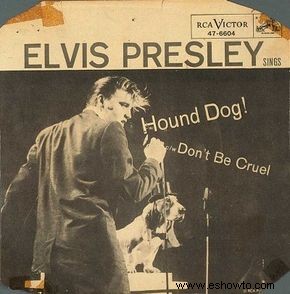
Although Elvis Presley died in 1977, his name, music, and image have sustained the public's attention. The period after his death has been marked by controversy, acclaim, ridicule, and commercialism:Officials debated the role of drugs in his death, music organizations honored his accomplishments, the media ridiculed the fans, and profiteers made money from it all. From the pits of tabloid headlines to the peaks of awards and honors, Elvis continued to make news. Death was not the end of Elvis Presley's career, it simply marked another phase.
To commemorate Elvis on the 25th anniversary of his death, RCA released a compilation of his No.1 records titled ELV1S:30 #1 Hits. The marketing campaign was designed around the tag line:"Before anyone did anything, Elvis did everything." A clever bit of phrasing, the line succinctly summarized Elvis' contribution to pop culture history while evoking the dynamism of his sound and the danger of his original image.
The world needed to be reminded of this -- and it was. ELV1S:30 #1 Hits rocketed to No. 1 when it debuted, selling 500,000 copies in its first week of release. Debuting an album in the top spot on the U.S. charts was an accomplishment Elvis had not managed while he was alive. In addition to America, ELV1S:30 #1 Hits opened at No. 1 in 16 other countries, including Canada, France, the United Kingdom, Argentina, and the United Arab Emirates.
Marketing strategy aside, it was the music that accounted for the CD's success. Arranged in chronological order, the compilation of hits covered Elvis' entire career at RCA -- from "Heartbreak Hotel" in 1956 to "Way Down" in 1977. All the songs reached No. 1 on the charts at the time of their original release, either in the United States or the United Kingdom. This fact softens the accusation by rock music historians who claim that Elvis' music went into severe decline during the last few years of his life. His health and career may have suffered, and his sound was no longer rock 'n' roll, but his music was still vital to large portions of the audience.
This could also be said for today's audiences. As a last-minute addition to ELV1S:30 #1 Hits, the producers included a remix of "A Little Less Conversation," a song Elvis originally recorded for the soundtrack of Live a Little, Love a Little. Its reworking had been done in early 2002 by Dutch deejay act Junkie XL for a Nike World Cup commercial, but when it was released as a dance-mix single, it became Elvis' first Top Ten single in decades. "A Little Less Conversation" was billed as a bonus track, keeping it separate in concept from the rest of the cuts on the CD.
The team of Ernst Jorgensen and Roger Semon compiled and researched the tracks on ELV1S:30 #1 Hits. Jorgensen and Semon of BMG (which now owns RCA) have researched the Presley song catalog for several years, working hard to restore and repackage his music to its former glory. A group of expert engineers and mixers was hired to optimize the sound in ways that remained true to the original recordings, a difficult assignment considering the condition of the original tapes.
Stashed away at RCA's storage facilities in Iron Mountain, Pennsylvania, some of the original tapes had not been played in more than 40 years. Most were deteriorated to some degree, and the first goal was to transfer them onto a digital format for remixing or remastering. Some, including the tape for "Way Down," were in such bad condition they had to be baked in an oven to prevent the oxide from falling off the tape.
The songs from 1956 to 1961 had been recorded on a monaural (mono) system and could not be remixed, only remastered. The ones from 1961 to 1966 had been recorded on a three-track recording system and required an antique three-track machine to help in the remixing process. Only a few of these machines still exist, and the one the remixing team used tended to overheat, further aggravating the process.
Later tunes had been recorded on eight tracks, 16 tracks, and even 24 tracks, which were considerably easier to remix. However, the goal was to produce a uniform quality in all the tracks and to ensure that the quality remained whether the CD was played on a home stereo, a computer, or a car stereo. The efforts of these engineers and remixers resulted in a modernization that restores the songs' vitality yet does not detract from Elvis' renditions of the songs.
The energy in Elvis' recordings comes in part from the way he worked in the studio. When Elvis entered the studio, he took down the partitions between performer and musician, so he was in the same room as the band. They warmed up by singing a few gospel songs or other tunes, then got down to selecting whatever songs had been brought in by the band, the Memphis Mafia, the Colonel, or anyone who had a suggestion.
Elvis sang each take of a song completely through, as if it was a performance before an audience. Each take was enlivened or ruined by interaction between Elvis and the band, a kind of trial-and-error approach that thrived on instinct and spontaneity. Sometimes he moved along with the music in a way that inspired the band to do something a bit different on some takes or hone in on what had worked well in previous takes.
All decisions regarding a song were made in the studio during the session, not beforehand. In this way, Elvis was the producer of his work, relying on the immediacy of performance to dictate the recording. He did not generally overdub, nor did he splice together various takes of a song to get a perfect "studio version." The expert remixing and remastering of the songs on ELV1S:30 #1 Hits captures the vitality of Elvis' unique approach to recording, one he never abandoned for easier, more technically driven methods.
The astounding success of ELV1S:30 #1 Hits in 2002 steered the spotlight away from the rumors, the mass merchandising, and the antics of the fans in that all-important 25th-anniversary year toward something more significant -- his recordings.
The story of Elvis' music in the post-death period has not always had such a happy ending. To follow the story as a new generation is exposed to Elvis' music, see the next section.
For more fascinating information about Elvis Presley, see:
A New Generation Discovers the Music of Elvis Presley
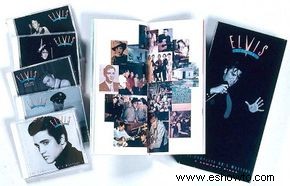
More important than the souvenirs, merchandise, and commemoratives is the music of Elvis Presley, which has been overshadowed by the more peculiar aspects of the phenomenon generated since his death. Before he died in 1977, Elvis sold 250 million records worldwide. Immediately after his death, record stores across the country quickly sold out of Elvis' records.
RCA's pressing plants operated 24 hours a day to fill the new orders for Elvis' records that began to pour in. For a while, the record company subcontracted other pressing plants to keep up with the demand. By September, RCA still had not caught up with all the orders. RCA's offices and pressing plants outside the U.S. found themselves in the same position. Pressing plants operated day and night. One factory in Hamburg, West Germany, produced only Elvis records in an attempt to meet the demands. By October, sales in the U.S. were so high that several of Elvis' albums were on the charts again.
RCA continued to release albums of Elvis' music at the rate of two or three per year. As was the case while he was alive, some of the albums were well-received, others were criticized for their inferior quality. The marketing strategy behind the albums varied as much as their quality.
Some albums, such as Guitar Man, attempted to take advantage of contemporary recording techniques to "improve" Elvis' sound. Other albums, such as He Walks Beside Me -- Favorite Songs of Faith and Inspiration, contained previously released material repackaged for yet another time. Still other albums seemed to be the result of RCA searching the vaults for any recording of Elvis' voice. Elvis -- Greatest Hits Vol. 4, for example, contained previously released cuts in addition to never-before-released "live" material from Las Vegas, Hawaii, and Nashville.
In 1983, a record producer from RCA found master tapes and records stored at Graceland, some of which contained unreleased live performances and offstage conversations with Elvis. Two years later, RCA released much of the musical material on a six-album set that celebrated Elvis' 50th birthday.
RCA has been criticized by purists for tinkering with the recordings of their most famous artist. Over the years the company has released several Elvis Presley albums of older material that was cleaned up for modern audiences. I Was the One makes use of modern instruments that were overdubbed to accompany his vocals. Other albums consisted of original mono recordings with "rechanneled stereo." Rock 'n' roll historians claim any attempt to "improve" or "clean up" Elvis' early recordings does not illuminate his contributions to popular music; instead, it distorts them.
A new approach to marketing and releasing Elvis Presley's music began after RCA was sold in 1986 to the German publishing group Bertlesmann Music Group (BMG). BMG formed an international restoration committee two years later to research and restore the Presley catalog of recordings. Representatives from America, England, Germany, Denmark, and Asia comprised the committee, which was ultimately responsible for the high quality of subsequent compilations of Elvis' music.
The BMG committee also researched the actual sales figures for the records and albums that Elvis sold. The Recording Industry Association of America (RIAA) is the official organization to which record companies report sales and request gold and platinum records for their artists. However, the RIAA was not formed until 1958, three years after Elvis had already sold millions of records.
Although RCA awarded Elvis various in-house gold records for his pre-1958 hits, they never asked the RIAA for retroactive certification of these records. Also, RCA rarely requested additional certification when Elvis' records went gold or platinum more than once.
The BMG committee used Colonel Tom Parker's files to accurately research how many records Elvis sold and which ones deserved gold, platinum, or multiplatinum status. After completing their research, they estimated that Elvis Presley had sold over a billion records worldwide. By August 1992, the committee had updated the status of Elvis' albums and singles. As a result, he was awarded 110 additional gold, platinum, and multiplatinum albums and singles by the RIAA -- the largest presentation of gold and platinum records in history.
Among the best of the BMG-RCA productions in recent years is the Masters Series, which represents Ernst Jorgensen's and Roger Semon's efforts to not only release Elvis Presley's music commercially but also reframe it historically. Their work has gone a long way toward refocusing attention on his musical triumphs rather than on the personal tragedies of his life or the bizarre aspects of the post-death era.
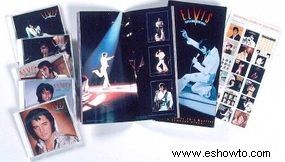
Released between 1992 and 1996, the series consists of Elvis:The King of Rock 'n' Roll -- The Complete 50s Masters, Elvis:From Nashville to Memphis -- The Complete 60s Masters I, and Elvis:Walk a Mile in My Shoes -- The Complete 70s Masters. Together these three sets of CDs are a faithful audio documentation of Elvis' music from the beginning to the end.
The tracks have been digitally remastered from old Sun and RCA recordings, but they maintain the integrity of the originals. Vocal exchanges and banter between Elvis and his musicians capture the camaraderie and the spontaneity of the sessions. An archival and musical achievement, the Masters Series also includes complete session credits and lengthy liner notes by music historians Peter Guralnick and Dave Marsh.
Separately, each set suggests something about Elvis' career that defies a commonly held perception. By following the evolution of Elvis' work from 1954 to 1958, The Complete 50s Masters proves that Elvis did not "steal" the sound of black rhythm-and-blues artists and call it his own. Instead, the tracks reveal a blending of influences that coalesced into a commercial sound that inched ever closer toward a mainstream style.
The Complete 60s Masters I shows that Elvis did not entirely abandon his roots in country, gospel, and rhythm-and-blues after he achieved his pop style -- an accusation hurled most often by rock music critics. The smooth, mainstream pop stylings of the movie soundtracks did dominate the period, but his recordings of the blues tunes "Reconsider Baby" and "Such a Night" and his gospel work later in the decade are declarations of his Southern heritage.
The Complete 70s Masters reveals that Elvis did not grow lazy and rest on his laurels after his comeback to stage performances.
A more concise treatment of Elvis' career can be found in Elvis Presley Platinum:A Life in Music, that charts the evolution of his style in a four-CD box set. Platinum contains 100 tracks, 77 of which were previously unreleased. The unreleased material consists mostly of alternate takes of Presley classics or practice runs of various songs. However, it also included the newly discovered 1954 demo of Elvis singing "I'll Never Stand in Your Way."
This type of chronological treatment of his music forces listeners to reevaluate the familiar and find a context for the unreleased material. In doing so, a new light is shed on Elvis' music and a full appreciation is gained for the impact of his career. This rings true not only for young audiences, rock 'n' roll listeners, and Presley critics but also for Elvis fans, who remained faithful through the dark years of badly packaged re-releases.
Key to the Elvis phenomenon is the loyalty of his fans. His death left a void that fans have filled with conventions, rituals, fan clubs, and other activities. Their intense devotion results from a complex combination of circumstances, beginning with Elvis' early career on the country-western circuit.
Country music followers are among the most loyal of popular music fans. Many people who love country music remain devoted to a particular performer for decades, and they often inspire their children to become fans as well. Many of Elvis' most devoted fans became interested in him when he was regarded as a country singer, and they remained loyal to him after he became a national rock 'n' roll star.
Elvis always tried to give his fans what they wanted to see and hear. In the 1950s, his audience came to see his notorious performing style, hoping he would go further at each appearance than he'd ever gone before. Elvis was able to whip his audiences into a frenzy, an experience not understood by those who were not his fans. In the 1960s, his fans paid to see Elvis' musical films. In the 1970s, audiences expected Elvis to perform certain songs, wear his trademark jumpsuits, and strike specific poses -- standard parts of his act that he maintained for his fans until he died.
Elvis, the Colonel, and members of Elvis' family always treated the fans with the utmost consideration from the early days of his success until the very end, when Vernon Presley allowed fans to take flowers from his son's funeral. Elvis believed that his success was dependent on his fans, and he was always grateful for their loyalty and love. When he was young, he allowed them access to his personal life in a way that no other entertainer would dare.
Before Elvis moved to Graceland, fans were always hanging around the Presleys' home. At Graceland, fans often gathered at the gate, and Elvis would walk down or ride one of his horses there to sign autographs. Elvis' Uncle Vester was one of the guards at the gate house, and he sometimes stood and talked with fans for hours.
No matter how difficult the fans made Elvis' life by forcing him to live in seclusion, he never complained publicly, and he always had nice things to say to the press about his fans. Colonel Tom Parker gave premiums and special offers to Elvis' fan clubs and donated Elvis' personal belongings to be auctioned off for charity. Elvis once presented a car to the president of one of his fan clubs. When he was on tour during the 1950s, Elvis gave as many interviews to the reporters for high-school newspapers and fan-club newsletters as he did to the reporters who worked for big-city papers.
Though Elvis accumulated great wealth and success during his lifetime, he never forgot he was a Southern boy from humble beginnings. He chose not to reside permanently in Hollywood but preferred to live in Memphis, where he frequented local businesses and contributed generously to local charities.
Elvis never completely lost his Southern accent, and he always preferred down-home cooking and the company of other good ol' boys. Despite his money, position, and power, he never acted as though he was better than his fans. To fans, this meant that Elvis had always been one of them -- one of the people. "I guess you could say Elvis was what we'd like to be. He's one of us -- and yet he's our ideal," said an anonymous fan, as though she was speaking for all fans.
Elvis Presley fans have always been intensely devoted, and many have passed on that quality to other generations as a legacy. Elvis' fans are the most genuine testimony to his talent and impact on all of us. To learn more about how Elvis' fans keep his memory alive, see the next section.
For more fascinating information about Elvis Presley, see:
The Memory of Elvis Presley Lives On
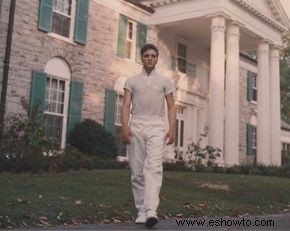
Since his death, the fans' desire to get close to Elvis is gratified through visiting Graceland, where the events of his personal life unfolded. The echoes of Elvis' past linger in the rooms and halls of his private retreat.
On the anniversary of Elvis' death, thousands of fans brave the sweltering August heat in Memphis to remember their idol. They have organized a week of tributes and memorials that includes visiting Graceland, Sun Records, and other Presley haunts. The week culminates in a candlelight ceremony.
On the evening of August 15, fans gather in front of the Music Gate. They sing some of Elvis' songs and swap Elvis stories. At 11:00 p.m., two or more Graceland employees walk down to the gate with a torch that has been lighted from the eternal flame.
As the Music Gate swings open, the fans, with their lighted candles, climb silently and reverently up the hill behind the house, where they walk single file past the gravesite. The procession often takes as long as six hours to pass through the Meditation Garden. It is not only a gesture of respect for Elvis and what he represents, but also it's proof that Elvis' fans are as faithful after his death as they were during his lifetime.
The almost continuous release of biographical information keeps Elvis' name in the news and fuels the phenomenon. Professional writers and scholars have published books about Elvis. Rock-music historian Dave Marsh's eloquent and insightful Elvis, published in 1981, concentrated on the singer's contributions to popular music and culture. Peter Guralnick, a noted music historian, wrote two perceptive biographies titled Last Train to Memphis:The Rise of Elvis Presley and Careless Love:The Unmaking of Elvis.
Members of the Memphis Mafia also published books about Elvis. Jerry Hopkins wrote Elvis:The Final Years, and Marty and Patsy Lacker collaborated on Elvis:Portrait of a Friend. Both books confirm the stories about Elvis' drug use and destructive lifestyle related in the controversial Elvis:What Happened? by Red and Sonny West.
Subsequent biographies by members of Elvis' family acknowledged his bad side but most often balanced these stories with anecdotes about his generosity. The most awaited biography was Priscilla Beaulieu Presley's account of her relationship with Elvis, titled Elvis and Me. Published in 1985, the book offers no revelations about his career but does provide some much-needed insight into his secluded lifestyle during the 1960s.
The Touch of Two Kings by Elvis' stepbrother Rick Stanley, who is now a minister, recounts Stanley's experiences with his famous relative. Elvis:We Love You Tender by Elvis' stepmother Dee Stanley is a compassionate look at his ups and downs during the 1960s and 1970s.
In 1987, to mark the tenth anniversary of Elvis' death, a reappraisal of his musical contributions began to appear in the popular press. After years of negative publicity, the career of Elvis Presley was finally being reevaluated. This appreciation was short-lived, however, because rumors surfaced that Elvis was still alive, undermining any credible assessment of his career.
Initially, the rumors that Elvis Presley had faked his own death served to discredit his standing as an important cultural figure. Fueled by Gail Brewer-Giorgio's self-published book, The Most Incredible Elvis Presley Story Ever Told, the "Elvis is alive" rumors escalated in 1988 with reported sightings of Elvis in fast-food restaurants in Michigan. Giorgio's book was retitled Is Elvis Alive? to take advantage of the media attention surrounding the current surge of interest in Elvis. Included with each book was an audiocassette of Elvis' voice discussing events that occurred after he died. Later an Elvis soundalike came forward, asserting that he had made the recording for a project that never materialized, a claim Giorgio denied.
Ultimately, the authenticity of the tape mattered very little, because the rumors and the way they were handled in the press added another dimension to the Elvis Presley phenomenon. The frequency of books, newspaper and tabloid articles, and programs on radio and television indicated that many people -- whether or not they believed the rumors -- were interested in keeping Elvis Presley "alive."
Bumper stickers that sentimentally declared, "Elvis lives in my heart," were replaced with the more emphatic "Elvis Lives." But it was not the historical Elvis Presley who was resurrected -- it was Elvis the icon of American popular culture.
The "Elvis is alive" stories and the massive amounts of publicity that surrounded their circulation helped refigure the historical Elvis into an American folk hero endowed with as much symbolic significance as Davy Crockett or Wyatt Earp. As an icon, Elvis Presley can evoke any number of ideas, including rebellion, success, excessiveness, and the glory and pitfalls of fame. As a folk hero, he inspires the telling and retelling of anecdotes and stories that are exaggerated and manipulated to illustrate any of these ideas.
In the years since his death, Elvis Presley has been highly honored and sharply criticized. At times a powerful symbol of revolution and at other times a national joke, through it all he has remained the King of Rock 'n' Roll. His crown is intact, only slightly tarnished by the criticism, exploitation, and hype. It is a fitting title because it embraces the breadth of an extraordinary career and because it reminds us of the music -- his true legacy to American culture.
For more fascinating information about Elvis Presley, see:
ABOUT THE AUTHOR
Susan Doll holds a Ph.D. in radio, television and film studies from Northwestern University. She is an instructor of film studies at Oakton Community College and a writer of film and popular culture. A sought-after expert on the works and life of Elvis Presley, Susan has appeared on The Joan Rivers Show and National Public Radio to discuss the King and other topics related to popular film. She is the author of numerous books on popular culture, notably Elvis:A Tribute to His Life, The Films of Elvis Presley, Marilyn:Her Life and Legend, Elvis:Rock 'n' Roll Legend, Best of Elvis, Understanding Elvis, Elvis:Forever in the Groove, Elvis:American Idol, and Florida on Film.

